Bosch Security Systems DCNWDU02 DCN Discussion Unit User Manual
Bosch Security System BV DCN Discussion Unit
Contents
- 1. User Manual Part 1
- 2. User Manual Part 2
User Manual Part 1
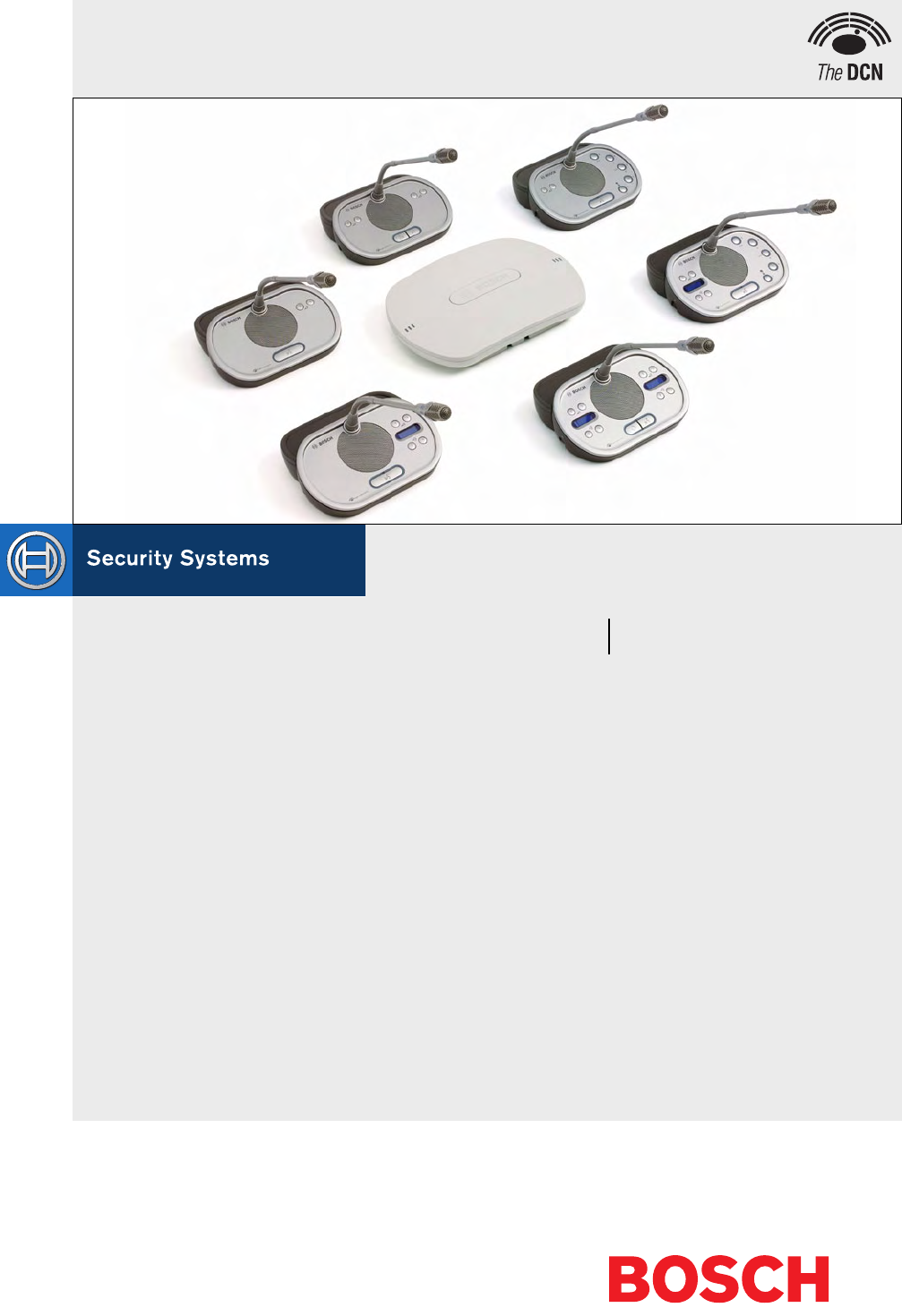
Installation and User Instructions
Wireless discussion systemen
DCN Wireless

Bosch Security Systems | 2007-11 | 9922 141 70691 en
DCN Wireless | Installation and User Instructions | Important Safeguards en | 3
Important Safeguards
Before you install or operate the DCN Wireless digital
congress network, you must read the Important Safety
Instructions. The Important Safety Instructions are
supplied together with the central control unit.

Bosch Security Systems | 2007-11 | 9922 141 70691 en
DCN Wireless | Installation and User Instructions | Disclaimers en | 4
Disclaimers
CobraNet is a trademark of Peak Audio — a division of
Cirrus Logic, Inc. — in the United States and/or other
countries.
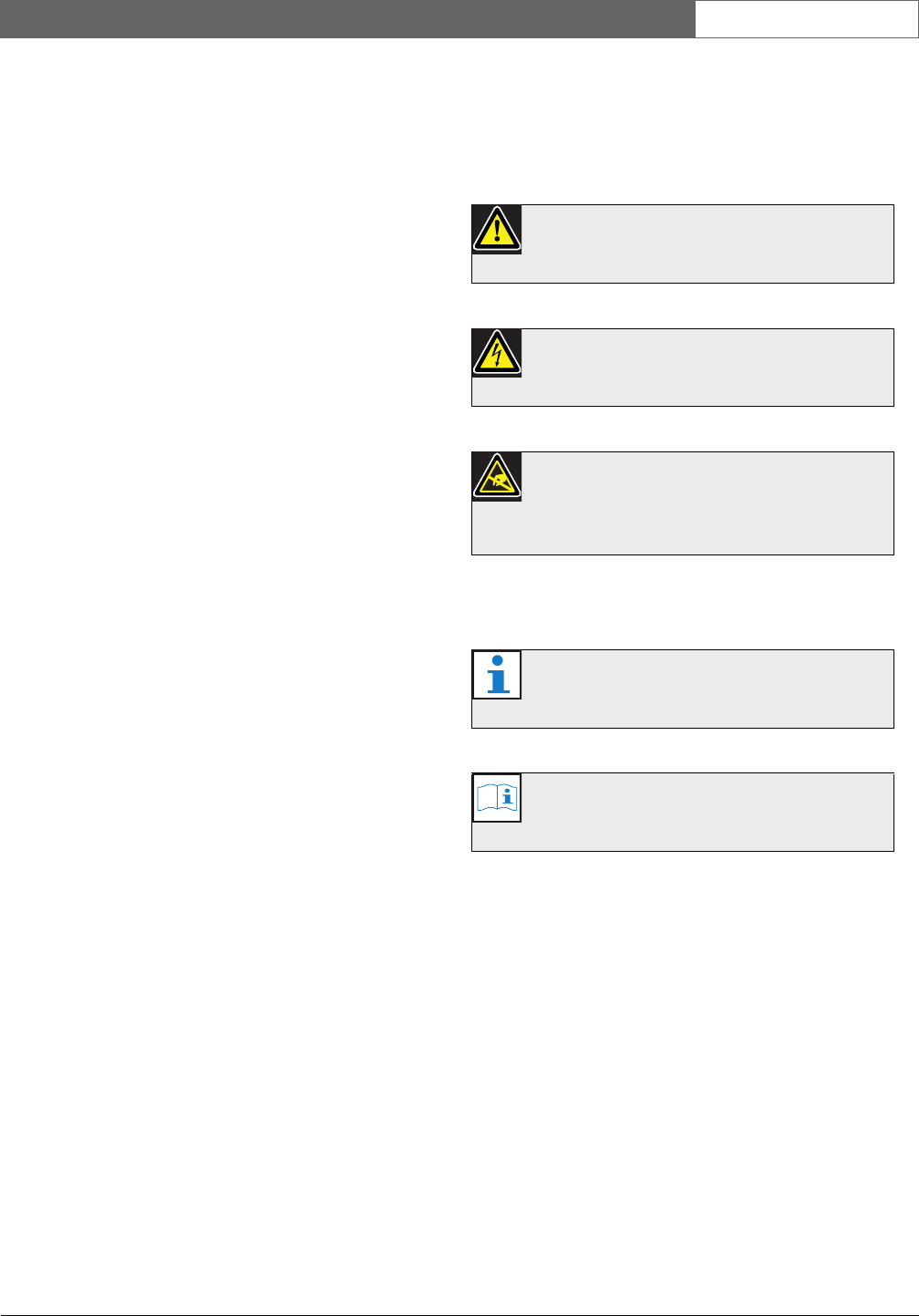
Bosch Security Systems | 2007-11 | 9922 141 70691 en
DCN Wireless | Installation and User Instructions | About this manual en | 5
About this manual
Function
The Installation and User Instructions gives the
installers and the operators the necessary data to install,
configure and operate a basic DCN Wireless Discussion
System.
When you want to make a more advanced DCN
Wireless Discussion System, you also need information
from the DCN Next Generation Installation and User
Instructions.
The product index (refer to appendix B) tells you where
you can find more data about devices that can be
connected to DCN Wireless.
Digital version
The Installation and User Instructions is available as a
digital file (Portable Document File, PDF).
When the PDF refers you to a location that contains
more data, you can click the text to go there. The text
contains hyperlinks.
Admonitions and notes
The Installation and User Instructions uses admonitions
and notes. The admonition gives the effect if you do not
obey the instructions. These are the types:
•Caution
If you do not obey the caution, you can cause
damage to the equipment.
•Warning
If you do not obey the warning, you can cause
personal injury or death.
Signs
The Installation and User Instructions shows each
admonition with a sign. The sign shows the effect if you
do not obey the instruction.
The sign that is shown along with a note gives more
data about the note itself.
Admonition
General sign for cautions and warnings.
Admonition
Risk of electric shock.
Admonition
Risk of electro-static discharges (refer to the
section ’Electro-static discharges’).
Note
General sign for notes.
Note
Refer to another information source.
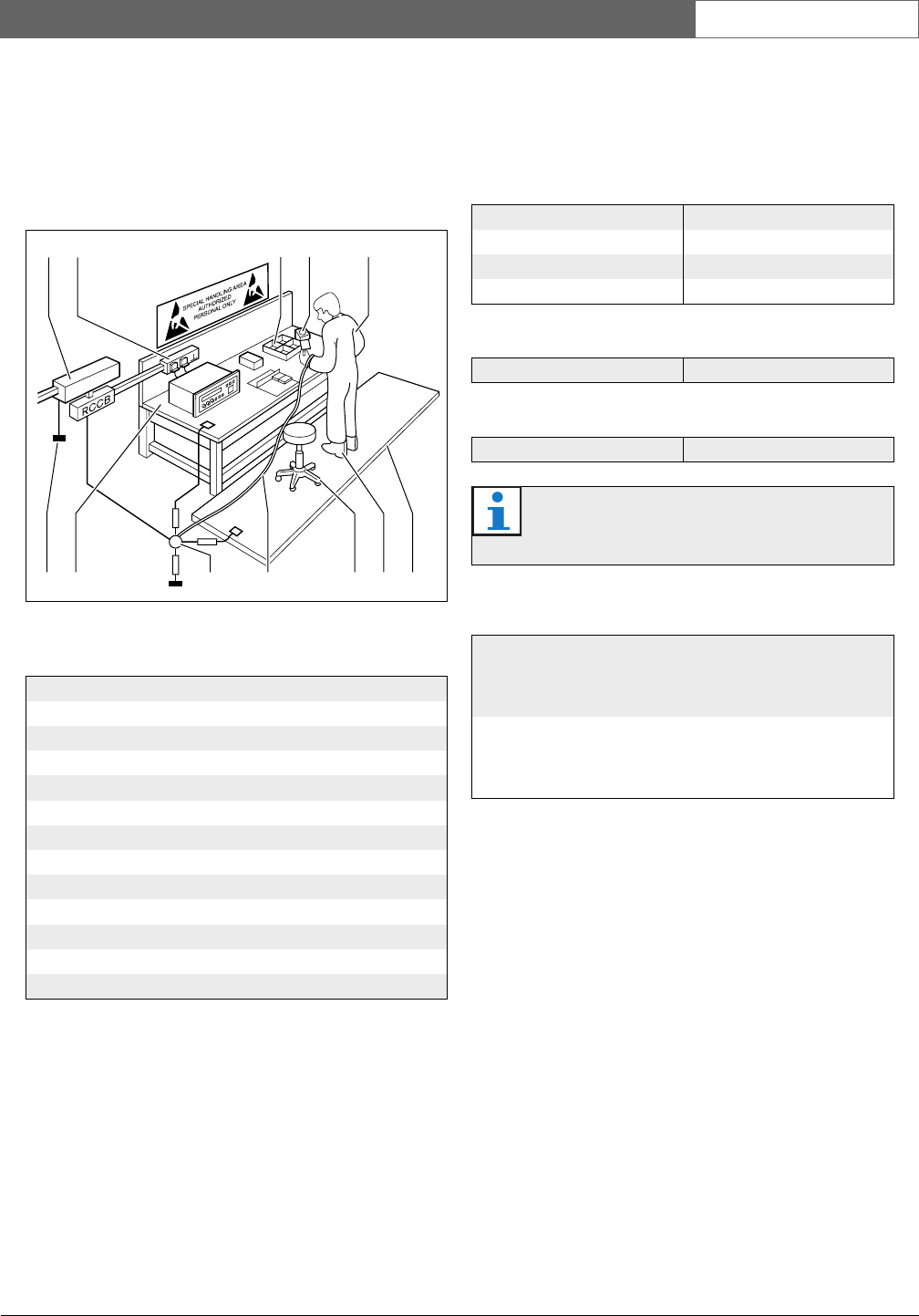
Bosch Security Systems | 2007-11 | 9922 141 70691 en
DCN Wireless | Installation and User Instructions | About this manual en | 6
Electro-static discharges
Electro-static discharges can damage electric
components. You must take measures to prevent
electro-static discharges when you touch PCBs (refer to
figure 1).
Conversion tables
Length, mass and temperature are in SI units. Refer to
the data below to change SI units to imperial units.
figure 1: ESD prevention
table 1: ESD prevention
No. Description
1 Safety isolating transformer
2Distribution supply box
3 Conductive compartment trays
4Electro-static voltage sensor
5 Cotton overall
6Conductive floor mat
7 Conductive boots/heel grounding protectors
8Conductive stool
9 Strap (resistance 0.5 to 1.0 MΩ)
10 Common reference point
11 Conductive bench top
12 Supply ground
312
12 11 10 9 8 7 6
4 5
table 2: Conversion of units of length
1 in = 25.4 mm 1 mm = 0.03937 in
1 in = 2.54 cm 1 cm = 0.3937 in
1 ft = 0.3048 m 1 m = 3.281 ft
1 mi = 1.609 km 1 km = 0.622 mi
table 3: Conversion of units of mass
1 lb = 0.4536 kg 1 kg = 2.2046 lb
table 4: Conversion of units of pressure
1 psi = 68.95 hPa 1 hPa = 0.0145 psi
Note
1 hPa = 1 mbar.
table 5: Conversion of units of temperature
°F9
5
--- °C32+⋅=
°C5
9
--- °F32–()⋅=

Bosch Security Systems | 2007-11 | 9922 141 70691 en
DCN Wireless | Installation and User Instructions | Table of Contents en | 7
Table of Contents
Important Safeguards ..................................................................................................................................................3
Disclaimers ......................................................................................................................................................................4
About this manual .........................................................................................................................................................5
Table of Contents ..........................................................................................................................................................7
Section 1 - System Design and Planning............................................................................................................. 11
1. Wireless network design ........................................................................................................................................................... 12
1.1 Introduction ............................................................................................................................................................................ 12
1.2 Limits ....................................................................................................................................................................................... 12
1.3 Frequency band .................................................................................................................................................................... 13
2. DCN design .................................................................................................................................................................................. 15
2.1 Introduction ............................................................................................................................................................................ 15
2.2 Limits ....................................................................................................................................................................................... 15
3. Optical network design .............................................................................................................................................................. 16
3.1 Introduction ............................................................................................................................................................................ 16
3.2 Calculation tool ..................................................................................................................................................................... 16
3.3 Limits ....................................................................................................................................................................................... 16
3.4 Control capacity ................................................................................................................................................................... 16
3.5 Power capacity ..................................................................................................................................................................... 16
3.6 Cabling ................................................................................................................................................................................... 17
3.7 Example layouts .................................................................................................................................................................... 19
4. Camera control ............................................................................................................................................................................. 22
4.1 Introduction ............................................................................................................................................................................ 22
4.2 Scenarios ............................................................................................................................................................................... 22
5. Infra-red wireless language distribution .................................................................................................................................. 22
6. CobraNet ....................................................................................................................................................................................... 23
7. User set-up .................................................................................................................................................................................... 23
7.1 Public areas and walkways ................................................................................................................................................ 23
7.2 Headphones/headsets ........................................................................................................................................................ 23
7.3 Speaking distance ............................................................................................................................................................... 23
7.4 Interpreter booths ................................................................................................................................................................. 23
8. Device set-up ................................................................................................................................................................................ 24
8.1 General ................................................................................................................................................................................... 24
8.2 Cables ..................................................................................................................................................................................... 24
8.3 Temperature .......................................................................................................................................................................... 24
8.4 Ventilation .............................................................................................................................................................................. 24
8.5 Cleaning ................................................................................................................................................................................. 24
8.6 Storage ................................................................................................................................................................................... 24
8.7 Acoustic feedback ............................................................................................................................................................... 25
9. Technical data .............................................................................................................................................................................. 26
9.1 System electrical and electro-acoustic characteristics ............................................................................................... 26
9.2 Environmental conditions ................................................................................................................................................... 27
9.3 Safety ...................................................................................................................................................................................... 27
9.4 Electro-magnetic compatibility .......................................................................................................................................... 28
9.5 Wireless devices .................................................................................................................................................................. 28
9.6 Miscellaneous ....................................................................................................................................................................... 29
Section 2 - Central Devices ...................................................................................................................................... 31

Bosch Security Systems | 2007-11 | 9922 141 70691 en
DCN Wireless | Installation and User Instructions | Table of Contents en | 8
10. DCN-WCCU Wireless Central Control Unit ......................................................................................................................... 32
10.1 Introduction ............................................................................................................................................................................ 32
10.2 Controls, connectors and indicators ............................................................................................................................... 32
10.3 Internal settings .................................................................................................................................................................... 33
10.4 Installation .............................................................................................................................................................................. 37
10.5 External connections ........................................................................................................................................................... 37
10.6 Configuration menu ............................................................................................................................................................. 43
11. DCN-WAP Wireless Access Point ......................................................................................................................................... 54
11.1 Introduction ............................................................................................................................................................................ 54
11.2 Firmware ................................................................................................................................................................................. 54
11.3 Controls, connectors and indicators ............................................................................................................................... 54
11.4 Installation .............................................................................................................................................................................. 55
11.5 External connections ........................................................................................................................................................... 57
11.6 Configuration ......................................................................................................................................................................... 57
11.7 Operation ............................................................................................................................................................................... 59
12. System configuration .................................................................................................................................................................. 61
12.1 Introduction ............................................................................................................................................................................ 61
12.2 Initialization ............................................................................................................................................................................. 61
12.3 Wireless modes .................................................................................................................................................................... 62
12.4 Microphone modes .............................................................................................................................................................. 63
12.5 Repetition rate ....................................................................................................................................................................... 64
12.6 Audio routing modes ........................................................................................................................................................... 64
12.7 Attention chimes ................................................................................................................................................................... 66
12.8 Erase requests-to-speak and speakers ........................................................................................................................... 66
12.9 Floor distribution ................................................................................................................................................................... 66
12.10 Intercom .................................................................................................................................................................................. 67
13. System operation ......................................................................................................................................................................... 68
13.1 Start the system .................................................................................................................................................................... 68
13.2 Stop the system .................................................................................................................................................................... 68
Section 3 - Contribution Devices............................................................................................................................ 69
14. DCN-WDU Wireless Discussion Units .................................................................................................................................. 70
14.1 Introduction ............................................................................................................................................................................ 70
14.2 Controls, connectors and indicators ............................................................................................................................... 70
14.3 Internal settings .................................................................................................................................................................... 74
14.4 Modes ..................................................................................................................................................................................... 76
14.5 Installation .............................................................................................................................................................................. 78
14.6 Subscription .......................................................................................................................................................................... 80
14.7 External connections ........................................................................................................................................................... 82
14.8 Operation ............................................................................................................................................................................... 83
15. DCN-MICL, DCN-MICS Pluggable Microphones ................................................................................................................ 85
15.1 Introduction ............................................................................................................................................................................ 85
15.2 Controls, connectors and indicators ............................................................................................................................... 85
15.3 External connections ........................................................................................................................................................... 86
15.4 Operation ............................................................................................................................................................................... 86
16. DCN-WLIION Battery Pack ...................................................................................................................................................... 87
16.1 Introduction ............................................................................................................................................................................ 87
16.2Safety ...................................................................................................................................................................................... 87
16.3 Controls, connectors and indicators ............................................................................................................................... 88

Bosch Security Systems | 2007-11 | 9922 141 70691 en
DCN Wireless | Installation and User Instructions | Table of Contents en | 9
16.4 Installation .............................................................................................................................................................................. 88
16.5 Operation ............................................................................................................................................................................... 88
17. DCN-WCH05 Battery Charger ................................................................................................................................................ 89
17.1 Introduction ............................................................................................................................................................................ 89
17.2 Controls, connectors and indicators ............................................................................................................................... 89
17.3 Installation .............................................................................................................................................................................. 90
17.4 External connections ........................................................................................................................................................... 91
17.5 Operation ............................................................................................................................................................................... 92
18. DCN-WPS Power Supply Adapter ......................................................................................................................................... 93
18.1 Introduction ............................................................................................................................................................................ 93
18.2 Installation .............................................................................................................................................................................. 93
18.3 External connections ........................................................................................................................................................... 93
19. DCN-FCWD10 Flight Case for Wireless Discussion Units .............................................................................................. 94
20. DCN-WFCCU Flight Case for DCN-WCCU and DCN-WAP .......................................................................................... 94
21. DDCN-RCWD10 Roller Case for 10 Wireless Discussion .............................................................................................. 95
Section 4 - Appendices ............................................................................................................................................. 97
A Audio levels ................................................................................................................................................................................... 98
B Product index ..............................................................................................................................................................................100
C Statements for FCC & Industry Canada ..............................................................................................................................102
D Declarations ................................................................................................................................................................................103

Bosch Security Systems | 2007-11 | 9922 141 70691 en
DCN Wireless | Installation and User Instructions | Table of Contents en | 10

Bosch Security Systems | 2007-11 | 9922 141 70691 en
DCN Wireless | Installation and User Instructions | System Design and Planning en | 11
Section 1 - System Design and Planning
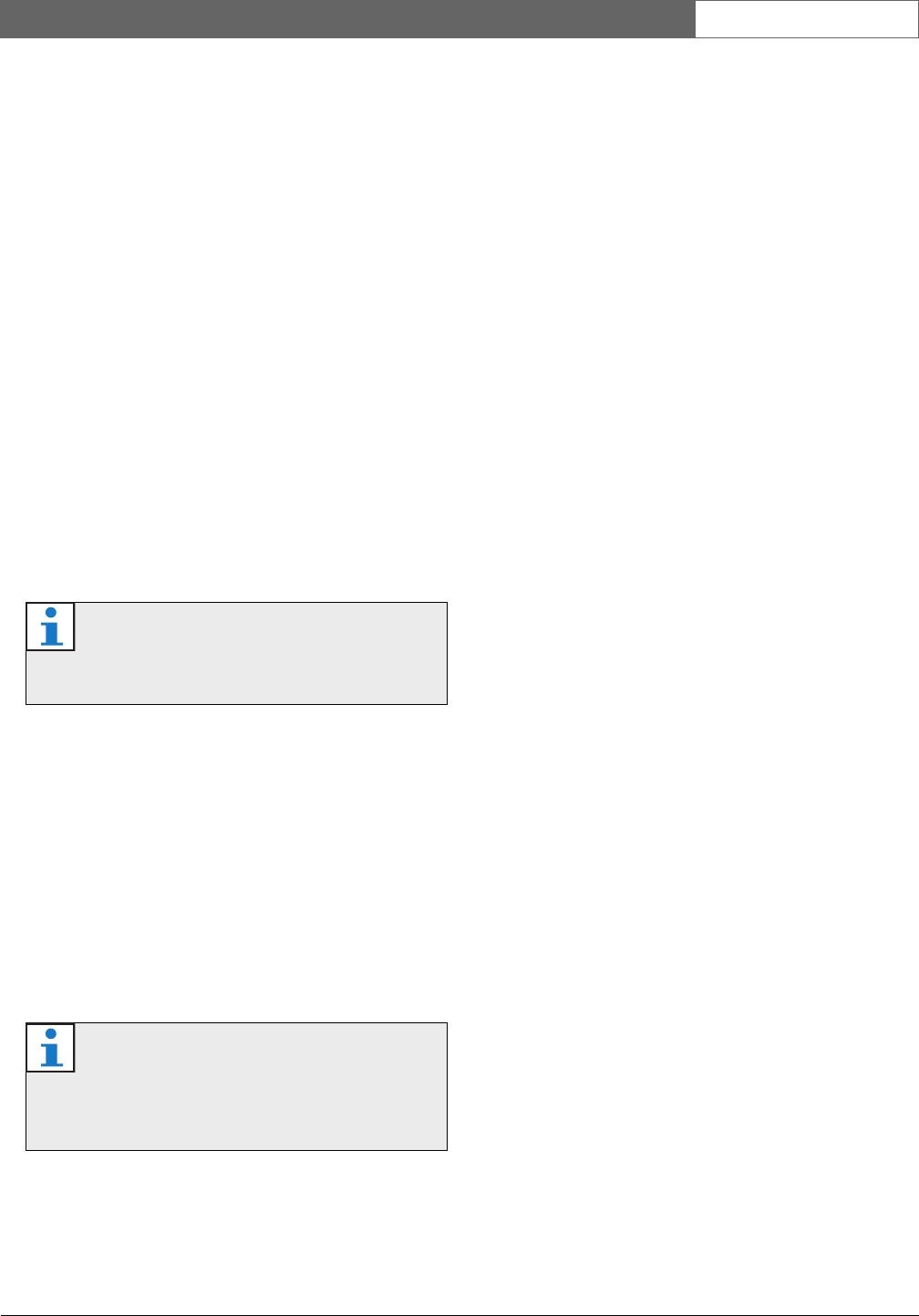
Bosch Security Systems | 2007-11 | 9922 141 70691 en
DCN Wireless | Installation and User Instructions | System Design and Planning en | 12
1 Wireless network design
1.1 Introduction
The DCN Wireless has three parts: the wireless
network, the DCN and the optical network. This
chapter tells how to design the wireless network.
1.2 Limits
Limit 1: Control capacity
The maximum number of devices in the wireless
network that the central control unit can control is 150.
Limit 2: Coverage area
For a good operation of the wireless part, all wireless
discussion units need to be in range of the wireless
access point. The wireless access point has a typical
maximum coverage area of 30 m by 30 m. To
determine the exact coverage area the coverage test kit
can be used.
Limit 3: Frequency
The wireless network must operate in a different
frequency band than adjacent wireless (computer)
networks (refer to section 1.3).
Limit 4: Language Distribution enabled or
disabled
If all wireless discussion units have software version 2.35
or higher, language distribution in the wireless network
can either be enabled or disabled. This system setting
will affect all units.
For information on how to enable or disable language
distribution in the wireless network, refer to section
10.6.11.
Wireless discussion units that have software version 2.35
or higher have improved signaling and behavior with
respect to subscription and connection, which is more in
line with the wired DCN units (refer to section 14.6).
The difference in signaling can be used to detect the
software version of the unit. This can be 2.35, or a
higher or lower version.
If the wireless discussion unit has an integrated channel
selector, the software version is shown on the channel
selector display when:
• the unit is switched on but is not subscribed to a
wireless network (refer to section 14.6 for
information on subscription).
• the unit is in programming mode (refer to section
14.3.1).
For information on how to enable or disable language
distribution in the wireless network, refer to section
10.6.11.
Limit 5: Number of Language Distribution
Channels
The wireless network has a maximum of 10 language
distribution channels, excluding the channel for the
floor. The total number of language distribution
channels in the system, is set via the interpreter desk
(refer to section 33.6.6.4 in the DCN Next Generation
Installation & User Instructions).
If there are more than 10 Language Distribution
Channels, only the first 10 channels will be available for
the wireless network. All higher channels will only be
available for the (wired) DCN network and/or the
infrared Integrus network.
Note
You can change the power value of the wireless
access point (refer to section 11.6.4).
Note
Wireless discussion units that have a software
version lower than 2.35 will only work when
language distribution is disabled.

Bosch Security Systems | 2007-11 | 9922 141 70691 en
DCN Wireless | Installation and User Instructions | System Design and Planning en | 13
1.3 Frequency band
1.3.1 802.11g specification
The wireless network is based on the 802.11g
specification for WiFi technology. Devices that comply
to the 802.11g specification operate in frequency bands
between 2.4000 and 2.4835 GHz.
1.3.2 Wireless computer networks
Wireless (computer) networks can also be based on the
802.11g specification for WiFi technology. In the
wireless computer networks, 13 overlapping channels
are available (refer to figure 1.1).
1.3.3 Carriers
In the wireless network of DCN Wireless, three
non-overlapping wireless carriers are available (refer to
figure 1.2).
1.3.4 Interference
The wireless network of DCN Wireless can cause
interference on wireless computer networks. You must
make sure the DCN wireless carrier does not overlap
the WLAN channel.
Refer to figure 1.3. In the example, the WLAN channel
is 3. WLAN channel 3 overlaps DCN wireless carriers 0
and 1. Therefore, use DCN wireless carrier 2.
Note
Although the system operates on frequencies
which are license free world wide, you must be
aware of country specific limitations and follow
them.
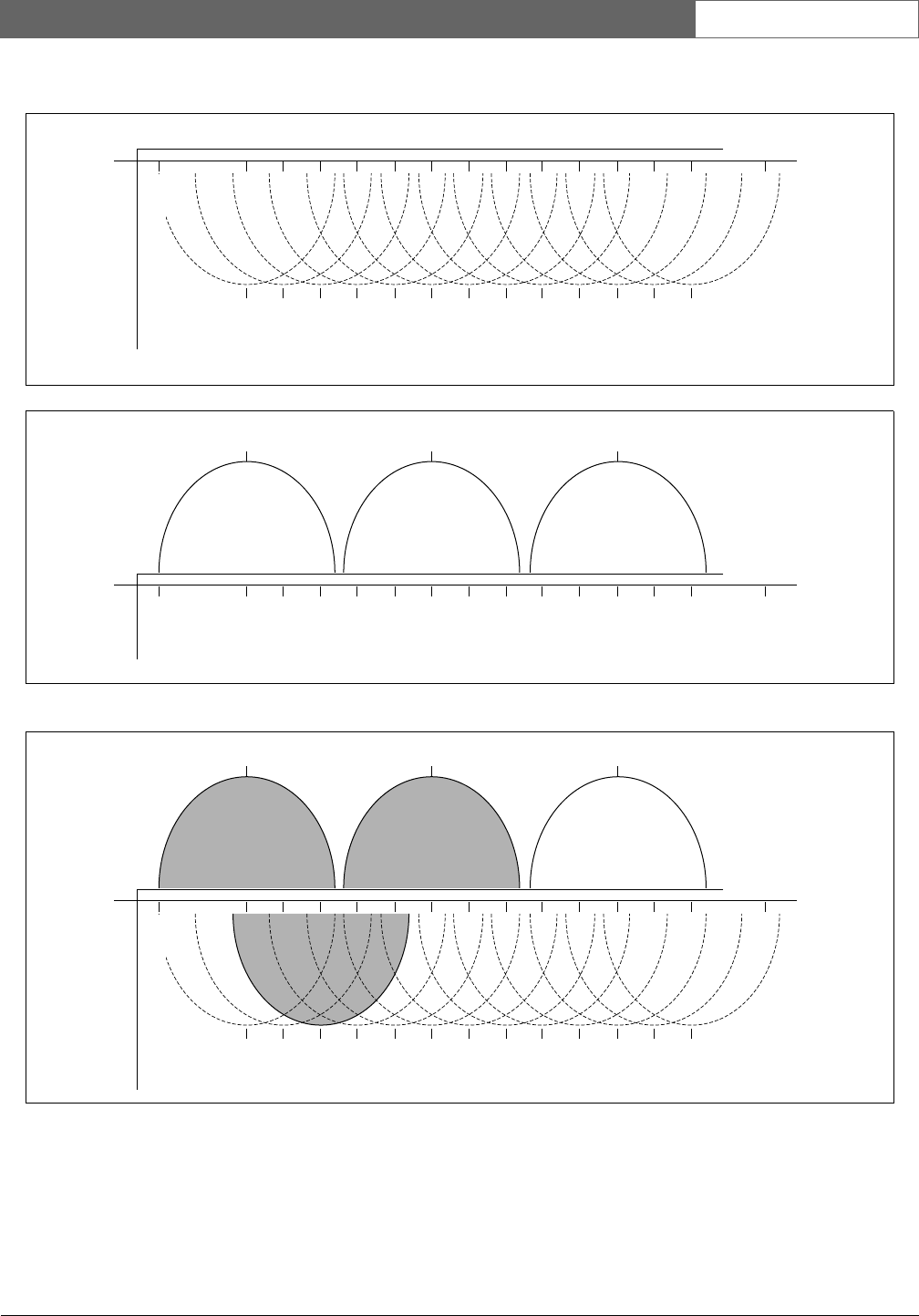
Bosch Security Systems | 2007-11 | 9922 141 70691 en
DCN Wireless | Installation and User Instructions | System Design and Planning en | 14
figure 1.1: WLAN channels
figure 1.2: DCN wireless carriers
1
2
3
4
5
6
7
8
9
10
11
12
13
2.412
GHz
GHz
2.417
2.422
2.427
2.432
2.437
2.442
2.447
2.452
2.457
2.462
2.467
2.472
2.484
2.400
012
2.412
GHz
2.417
2.422
2.427
2.432
2.437
2.442
2.447
2.452
2.457
2.462
2.467
2.472
2.484
GHz
2.400
figure 1.3: Example of interference
1
012
2
3
4
5
6
7
8
9
10
11
12
13
2.412
GHz
2.417
2.422
2.427
2.432
2.437
2.442
2.447
2.452
2.457
2.462
2.467
2.472
2.484
GHz
2.400

Bosch Security Systems | 2007-11 | 9922 141 70691 en
DCN Wireless | Installation and User Instructions | System Design and Planning en | 15
2DCN design
2.1 Introduction
The DCN Wireless has three parts: the wireless
network, the DCN, and the optical network. This
chapter tells how to design the DCN.
2.2 Limits
For the DCN limits, refer to chapter 1 in the “DCN
Next Generation, Installation & User Instructions”. The
DCN-WCCU has the same limitations with the
following deviations.
Make sure the following limits are not exceeded when
you design the DCN:
Limit 1: Control capacity
The DCN-WCCU wireless central control unit can
control a maximum of 95 active wired devices. The
number of passive devices is without limit. The
following wired active devices can be connected in any
combination:
• DCN-DIS Discussion Units
• DCN-CON Concentus Delegate Units
• DCN-DDI Dual Delegate Interface
• DCN-IDESK Interpreter Desks
• DCN-DDB Data Distribution Board
• DCN-FVU Voting Unit
The connected wired active devices have the same
limitations as the wireless devices with respect to the
number of audio channels (refer to section 12.4.1).
Limit 2: Single CCU only
The DCN-WCCU Wireless Central Control Unit
cannot be used in a multi CCU system.
Limit 3: Software Packages
Only use the following software packages in
combination with the DCN-WCCU Wireless Central
Control Unit:
• LBB4162/00 Standalone Automatic Camera Control
Software
• LBB4187/00 Open Interface Software
• DCN-SWSMV Synoptic Microphone & Voting
Control Software
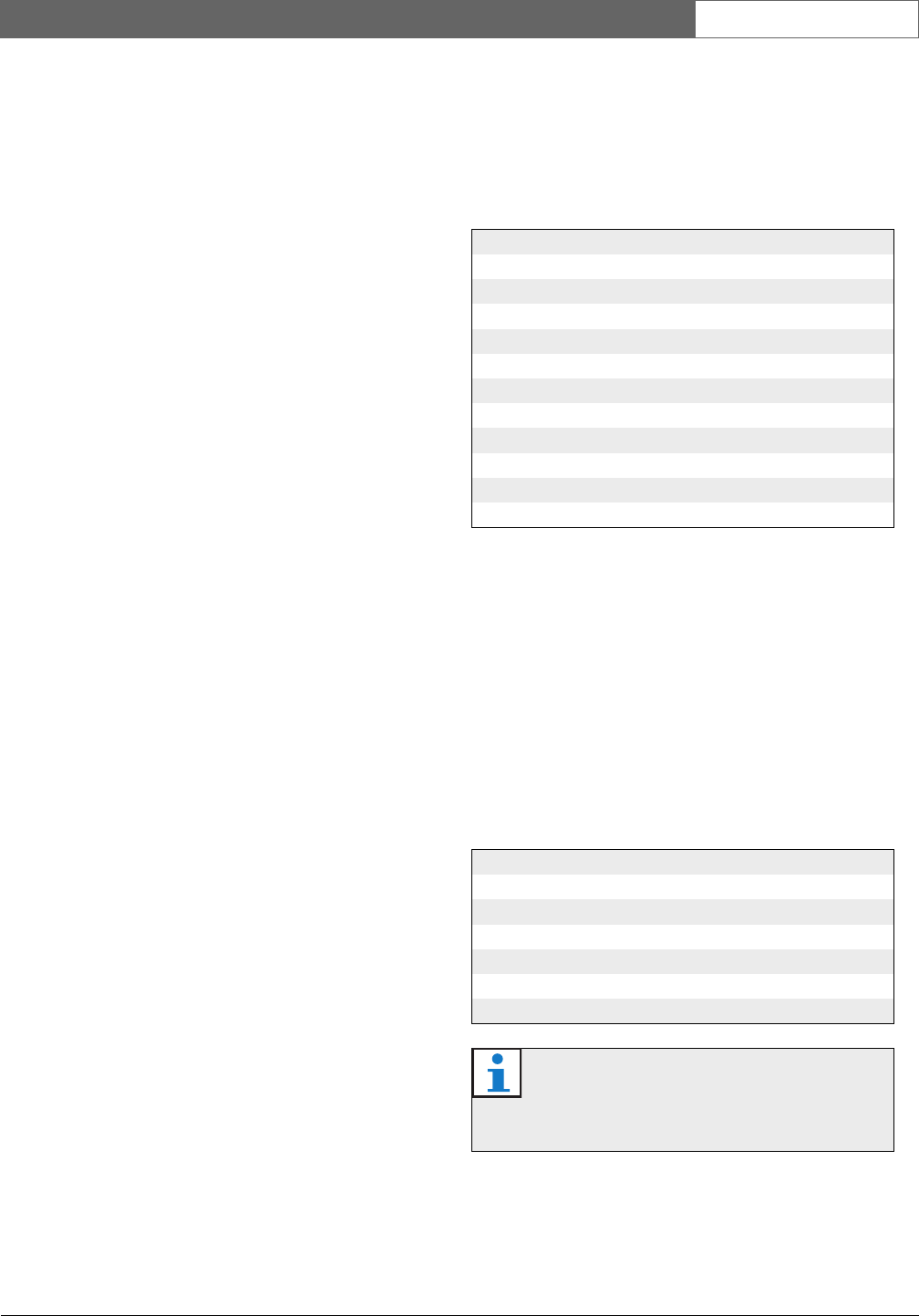
Bosch Security Systems | 2007-11 | 9922 141 70691 en
DCN Wireless | Installation and User Instructions | System Design and Planning en | 16
3 Optical network design
3.1 Introduction
The DCN Wireless has three parts: the wireless
network, the DCN and the optical network. This
chapter tells how to design the optical network.
3.2 Calculation tool
The calculation tool makes the planning and design of
the optical network easier. You can find the calculation
tool on the CD-ROM that is supplied with your system.
3.3 Limits
Make sure that these limits are not exceeded when you
make the optical network:
Limit 1: Control capacity
The maximum number of nodes in the optical network
is 63 (refer to section 3.4).
Limit 2: Number of devices
The maximum number of devices that you can connect
to the optical network of the central control unit is 16.
The maximum number of DCN-WAP Wireless Access
Points in the optical network is 1.
Limit 3: Power capacity
The maximum power that the optical network sockets
of the central control unit can supply is 65 W (refer to
section 3.5).
Limit 4: Cables
Refer to section 3.6:
• The maximum length of a POF cable is 50 m.
• The maximum cable length (POF and GOF) of the
optical network is dependent on the number of
nodes in the optical network.
• The minimum bend radius of a 90 degree bend in a
POF cable is 110 mm.
• The minimum coiling radius of a POF cable is
110 mm.
3.4 Control capacity
Each device in the optical network has a number of
nodes (refer to table 3.1). The maximum number of
nodes in the optical network is 63.
3.5 Power capacity
3.5.1 Introduction
Each device uses power and most devices do not have
an independent power supply.
3.5.2 Power consumption
The table shows the power each device in the optical
network uses.
table 3.1: Nodes
Device Nodes
DCN-CCU 2
DCN-WAP 1
LBB4402/00 1
LBB4404/00 1
LBB4410/00 1
LBB4414/10 0
INT-TX04 1
INT-TX08 2
INT-TX16 4
INT-TX32 8
PRS-4DEX4 1
table 3.2: Power consumption
Device Watt
DCN-WAP 4
LBB4402/00 7. 6
LBB4404/00 10.5
LBB4410/00 3.9
LBB4414/10 4.6
PRS-4DEX4 6.0
Note
The Integrus transmitters do not use power from
the system.
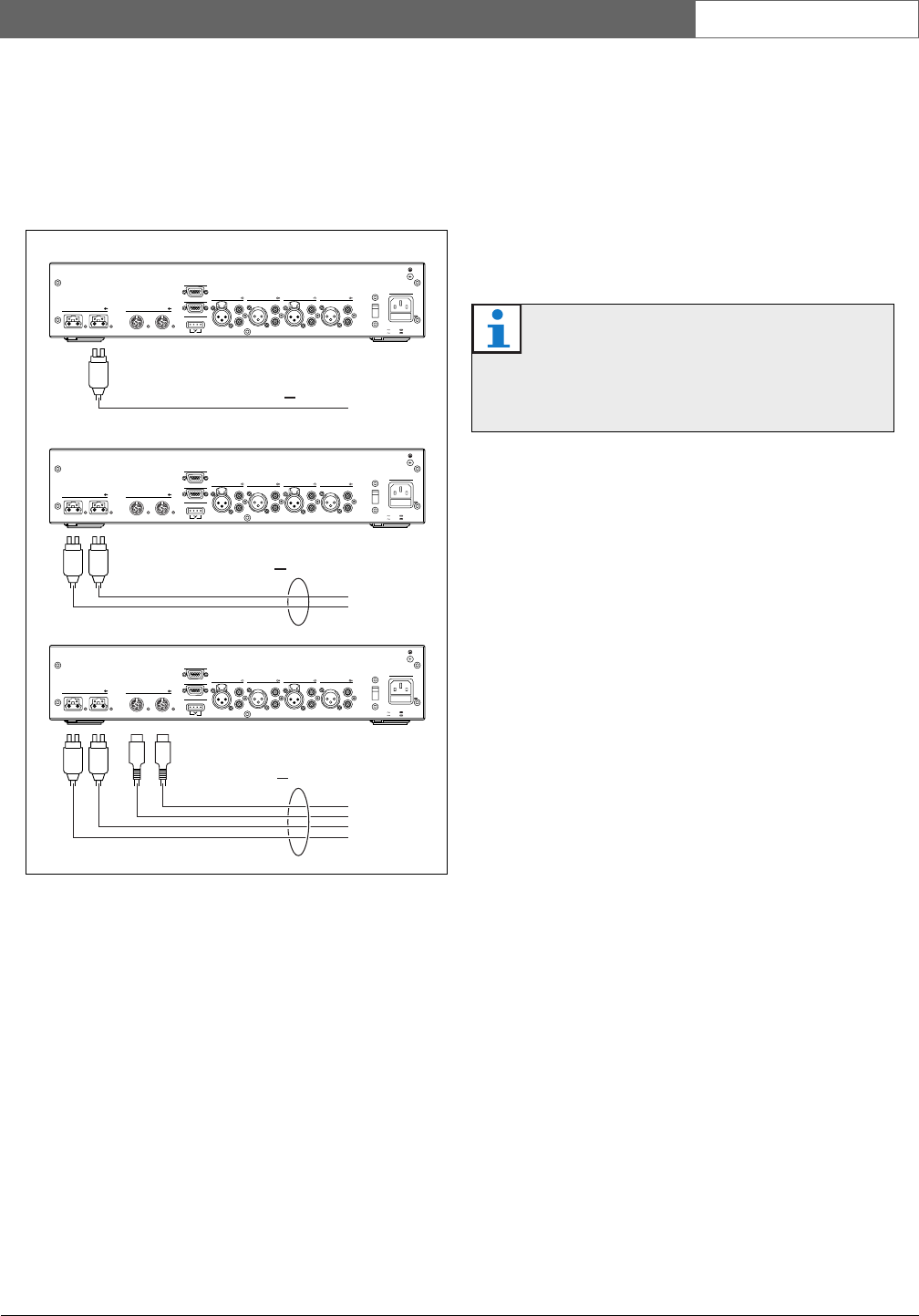
Bosch Security Systems | 2007-11 | 9922 141 70691 en
DCN Wireless | Installation and User Instructions | System Design and Planning en | 17
3.5.3 Power supply
The CCU supplies power for:
• the optical network, and
• the units connected via the DCN cables.
Refer to figure 3.1.
If more power is necessary, you must install external
power supplies in the optical network. The devices
below can connect to external power supplies:
• LBB4410/00 Network Splitter (refer to the DCN
Next Generation Installation and User Instructions).
• LBB4414/10 Fiber Interface (refer to the DCN Next
Generation Installation and User Instruction).
3.5.4 Overload indication
Each optical network socket of the central control unit
has a red LED that comes on to show that there is a
power overload. An overload occurs when the
necessary power for the devices is greater than that
supplied. The sockets are deactivated and the devices
connected to the central control unit do not operate.
The socket checks every 8 seconds for power overloads.
3.6 Cabling
3.6.1 Introduction
Many devices in the optical network have two optical
network sockets that are interchangeable. You can use
the two optical network sockets to make a redundant
ring.
3.6.2 Definitions
The optical network uses two types of cable:
•POF
Plastic Optical Fiber.
•GOF
Glass Optical Fiber.
figure 3.1: Optical network power supply
OK Fault
Fault
RS 232
Network
12
Audio In 1 Audio Out 1 Audio In 2 Audio Out 2
Mains
Port 2
115:100-120V 50-60Hz T2.5A 250V
230:220-240V 50-60Hz T2A H 250V
RS 232 Port 1
Trunk
12
230
P<65W
DCN-WCCU
DCN-WCCU
DCN-WCCU
P<65W
P<130W
OK Fault
Fault
RS 232
Network
12
Audio In 1 Audio Out 1 Audio In 2 Audio Out 2
Mains
Port 2
115:100-120V 50-60Hz T2.5A 250V
230:220-240V 50-60Hz T2A H 250V
RS 232 Port 1
Trunk
12
230
OK Fault
Fault
RS 232
Network
12
Audio In 1 Audio Out 1 Audio In 2 Audio Out 2
Mains
Port 2
115:100-120V 50-60Hz T2.5A 250V
230:220-240V 50-60Hz T2A H 250V
RS 232 Port 1
Trunk
12
230
Note
If only one of the optical network sockets has a
power overload, the two overload LEDs come
on.
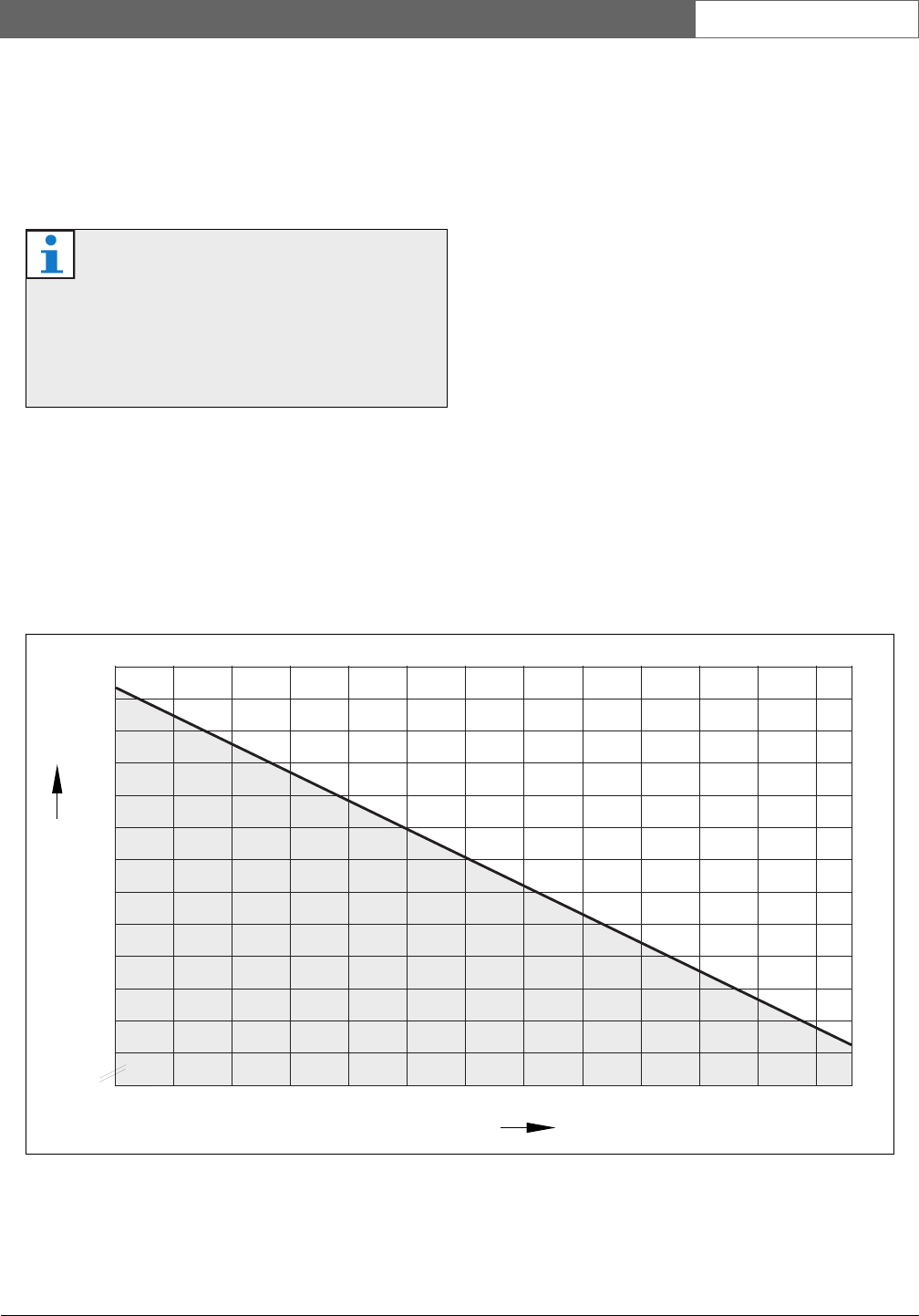
Bosch Security Systems | 2007-11 | 9922 141 70691 en
DCN Wireless | Installation and User Instructions | System Design and Planning en | 18
3.6.3 Optical fiber length
Because of optical attenuation, the maximum length of
optical network cables (LBB4416) is 50 m. You can use
GOF and fiber interfaces to increase the distance
between devices to a maximum of 1500 m.
3.6.4 Cable couplers
You can use the LBB4419/00 Cable Couplers to
connect optical network cables to each other. A cable
coupler causes optical attenuation. Each cable coupler
decreases the maximum distance between two devices
in the optical network (normally 50 meters) with
20 meters.
3.6.5 Maximum cable length
The maximum cable length (LBB4416 and GOF) of the
optical network is dependent on:
• The number of nodes
• The number of LBB4414/10 Fiber Interfaces
Do as follows:
1 Find the number of nodes of each device from the
node value table (refer to table 3.1). Add together the
nodes of all devices.
2 With the value of step 1, use the graph (refer to
figure 3.2) to find the maximum cable length without
LBB4414/10 Fiber Interfaces.
3 Count the number of LBB4414/10 Fiber Interfaces.
Each fiber interface decreases the maximum cable
length from step 2 with 18 m.
Note
If the distance between two devices is less than
100 m, use a network splitter between devices
to remove the use of fiber interfaces. Use only
the trunk sockets of the network splitter in this
case.
figure 3.2: Cable correction graph
950
5010152025
Nodes
30 35 40 45 50 55 60 63
1050
115 0
1250
1350
1450
1550
1650
175 0
1850
1950
2050
2150
Max. cable length (m)
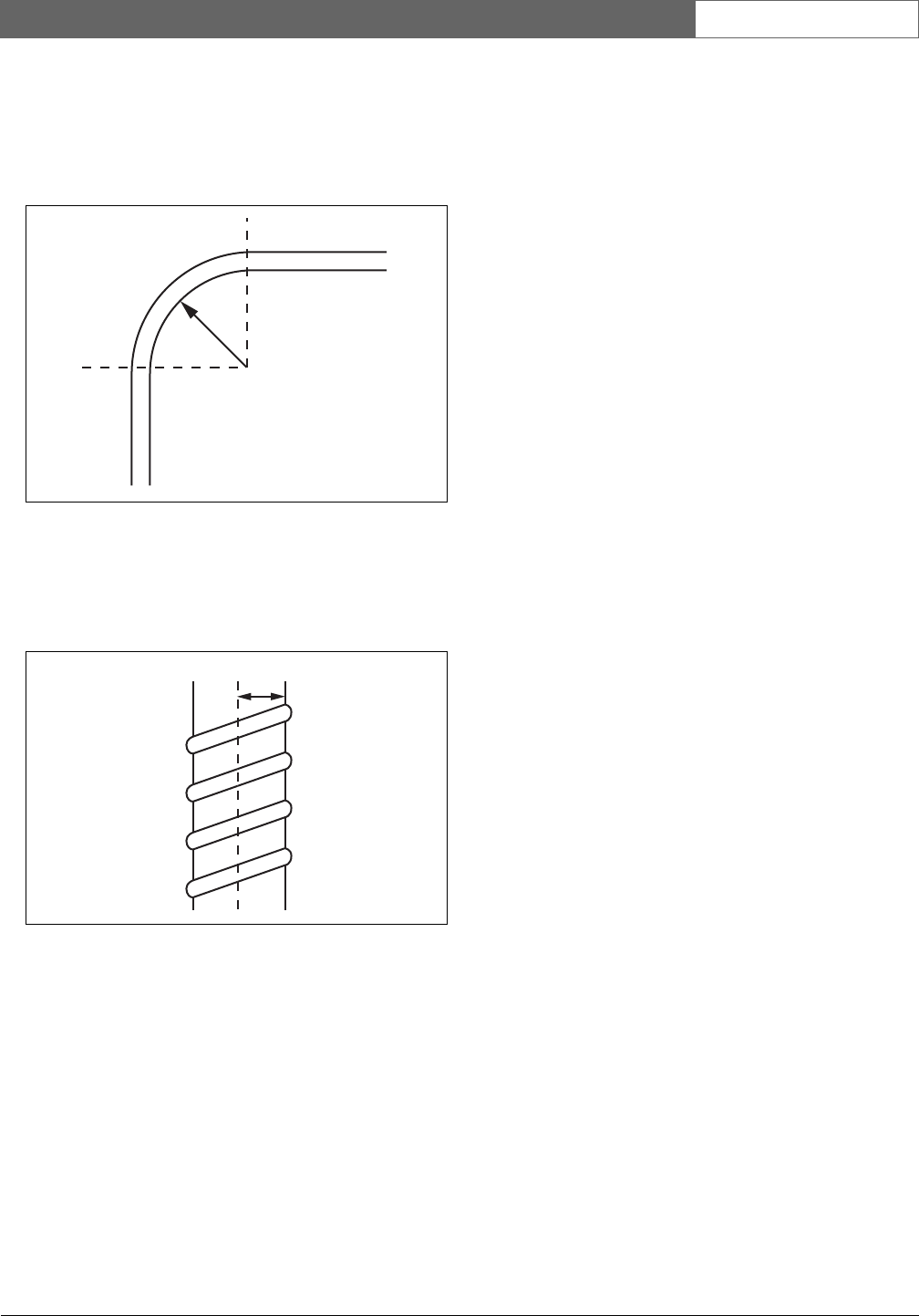
Bosch Security Systems | 2007-11 | 9922 141 70691 en
DCN Wireless | Installation and User Instructions | System Design and Planning en | 19
3.6.6 Bending
The minimum bend radius of a 90 degree bend in an
LBB4416 cable is 110 mm (refer to figure 3.3). A
180 degree bend is the same as two 90 degree bends.
3.6.7 Coiling
The minimum coiling radius of an LBB4416 cable is
110 mm (refer to figure 3.4).
3.7 Example layouts
3.7.1 Introduction
The number and type of devices that make the optical
network give the layout of the optical network. This
chapter shows examples of the possible layouts of
optical networks.
figure 3.3: Bend radius
figure 3.4: Coiling radius
R=110 mm
R=110 mm
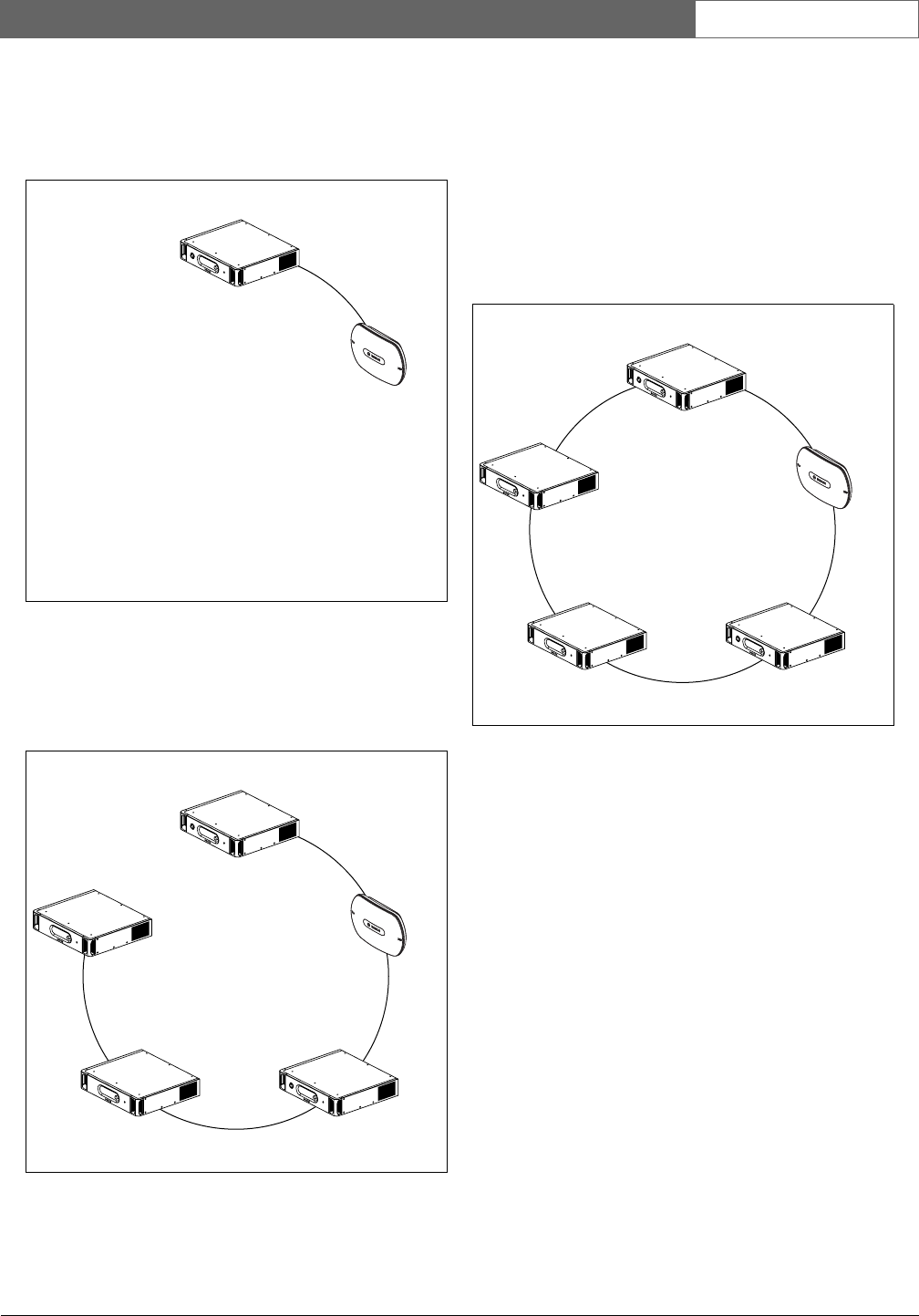
Bosch Security Systems | 2007-11 | 9922 141 70691 en
DCN Wireless | Installation and User Instructions | System Design and Planning en | 20
3.7.2 Basic optical network
Refer to figure 3.5 for an example of a basic optical
network.
3.7.3 Extended optical network
Refer to figure 3.6 for an example of an extended
optical network.
3.7.4 Redundant cables
The example of the extended optical network (refer to
figure 3.6) has no redundant cable. If the cable between
the central control unit (DCN-WCCU) and the wireless
access point (DCN-WAP) breaks, the central control
unit cannot transmit data to the wireless access point. A
solution for this problem is to use redundant cable (refer
to figure 3.7 for an example).
The example of the system without redundant cable
(refer to figure 3.6) has no connection between the
cobranet interface (LBB4404/00) and the central control
unit (DCN-WCCU). The example of the system with
redundant cable has a connection between the Cobranet
Interface and the central control unit. This connection
makes a ring. If a cable breaks, the optical network
continues to operate.
The total power of all devices in the redundant optical
network is 65 W. If the optical network is defective near
the central control unit, the other socket can supply
power to all of the optical network.
figure 3.5: Basic optical network
figure 3.6: Extended optical network
DCN-WCCU
DCN-WAP
DCN-WCCU
DCN-WAP
LBB4404/00
INT-TX
PRS-4DEX4
figure 3.7: Redundant optical network
DCN-WCCU
DCN-WAP
LBB4404/00
INT-TX
PRS-4DEX4
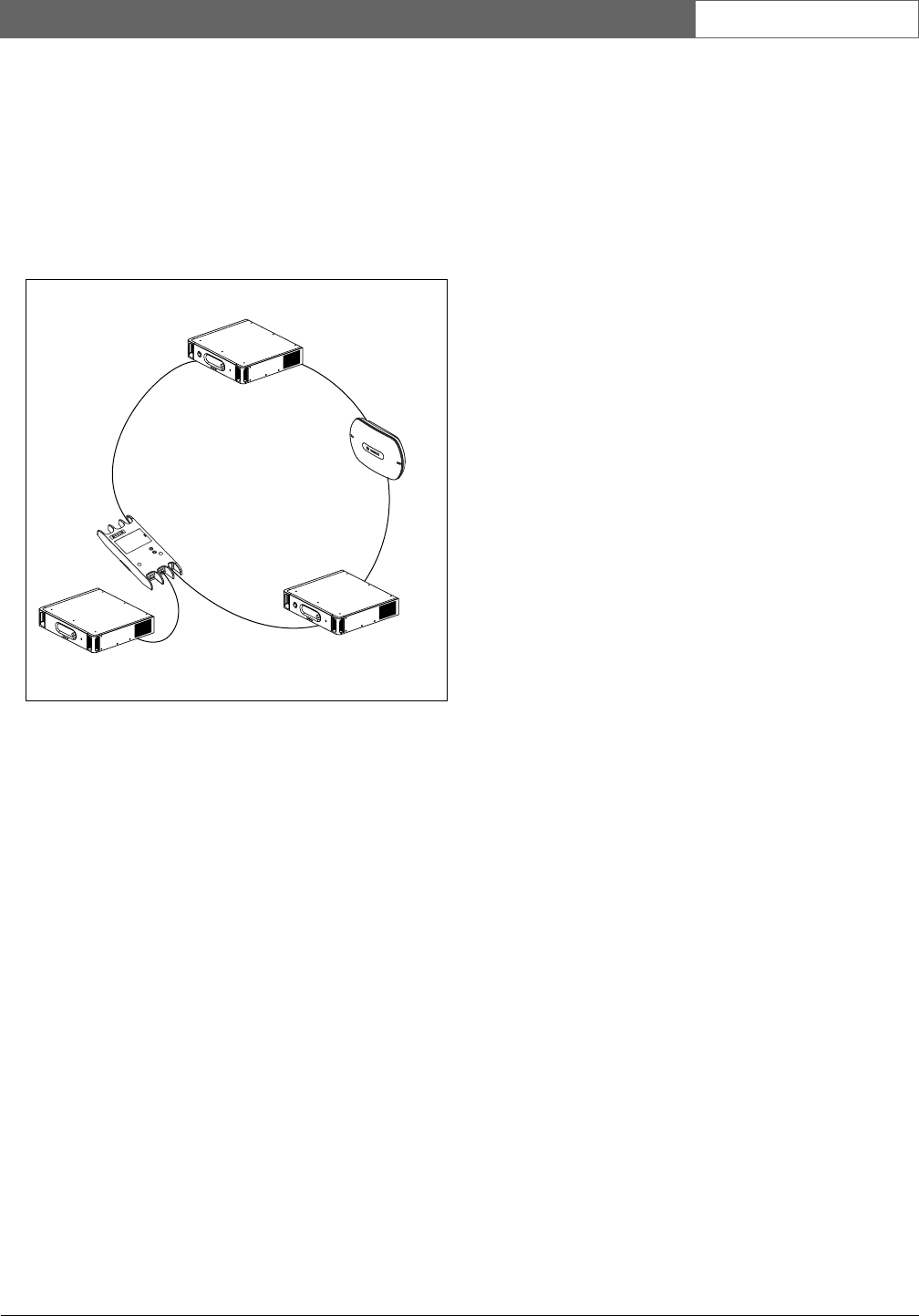
Bosch Security Systems | 2007-11 | 9922 141 70691 en
DCN Wireless | Installation and User Instructions | System Design and Planning en | 21
3.7.5 Tap-offs
The network splitter (LBB4410/00) lets you make
tap-offs (refer to figure 3.8 for an example). Tap-offs
cannot be redundant. If the cable between the network
splitter and the digital audio expander (PRS-4DEX4)
becomes defective, the digital audio expander has no
connection to the central control unit.
figure 3.8: Redundant optical network with tap-off
DCN-WCCU
DCN-WAP
PRS-4DEX4 INT-TX
LBB4410/00
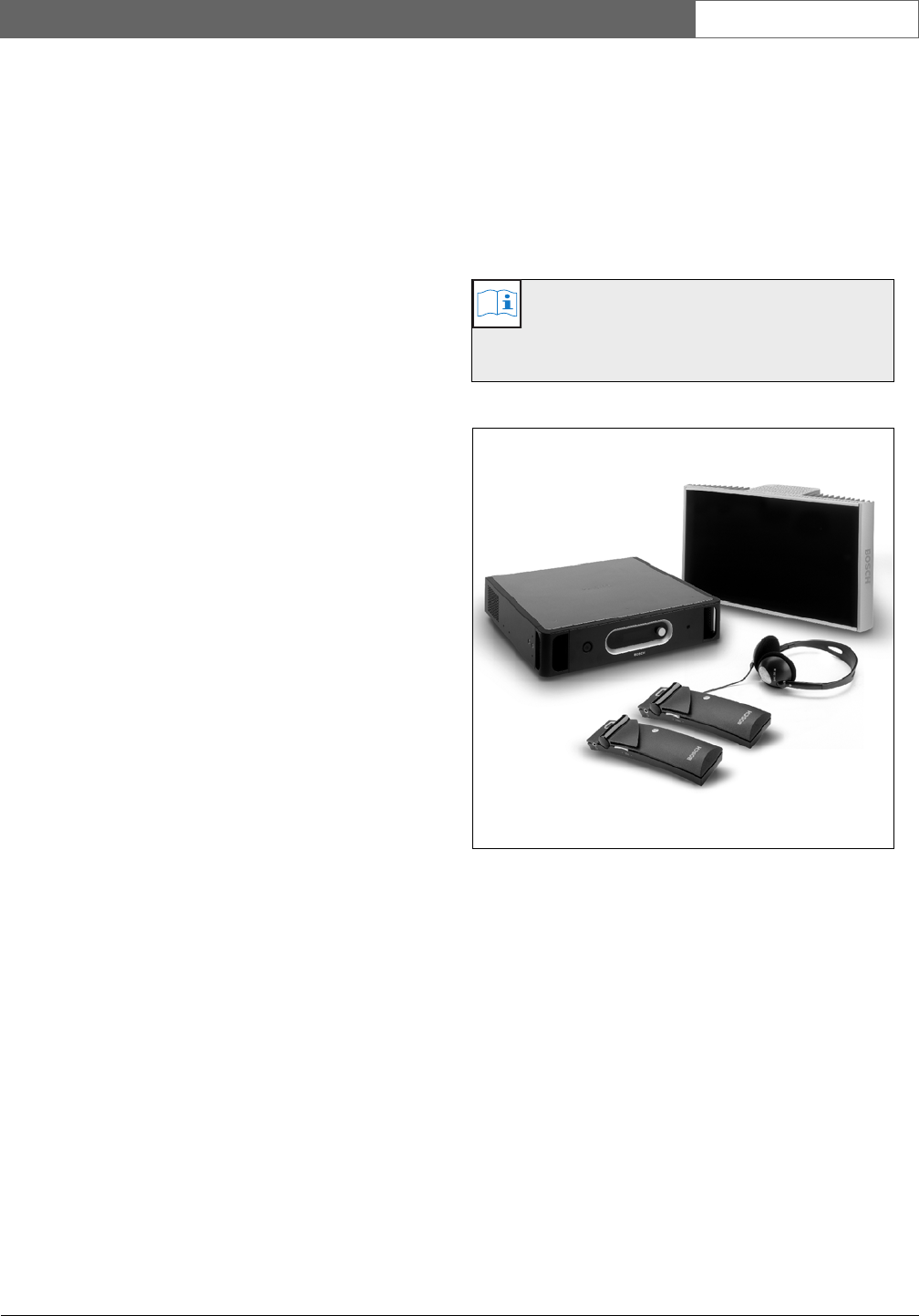
Bosch Security Systems | 2007-11 | 9922 141 70691 en
DCN Wireless | Installation and User Instructions | System Design and Planning en | 22
4 Camera control
4.1 Introduction
The central control unit can automatically point video
cameras in the direction of the delegate or chairman
who speaks. You can connect video cameras to the
central control unit through a video switcher or directly
to the central control unit. Use a video switcher to
connect more that one video camera and video display
to the central control unit.
4.2 Scenarios
These scenarios are possible:
• Direct camera control in a system without a DCN
control PC. Refer to the DCN Next Generation
Installation and User Instructions.
• Camera control through a video switcher in a system
without a DCN control PC. Refer to the DCN Next
Generation Installation and User Instructions.
5 Infra-red wireless
language distribution
You can connect the system to an Integrus digital
infra-red language distribution system. This system has a
transmitter, radiators and receivers.
Note
Refer to the Integrus Installation and User
Instructions for more data.
figure 5.1: Integrus
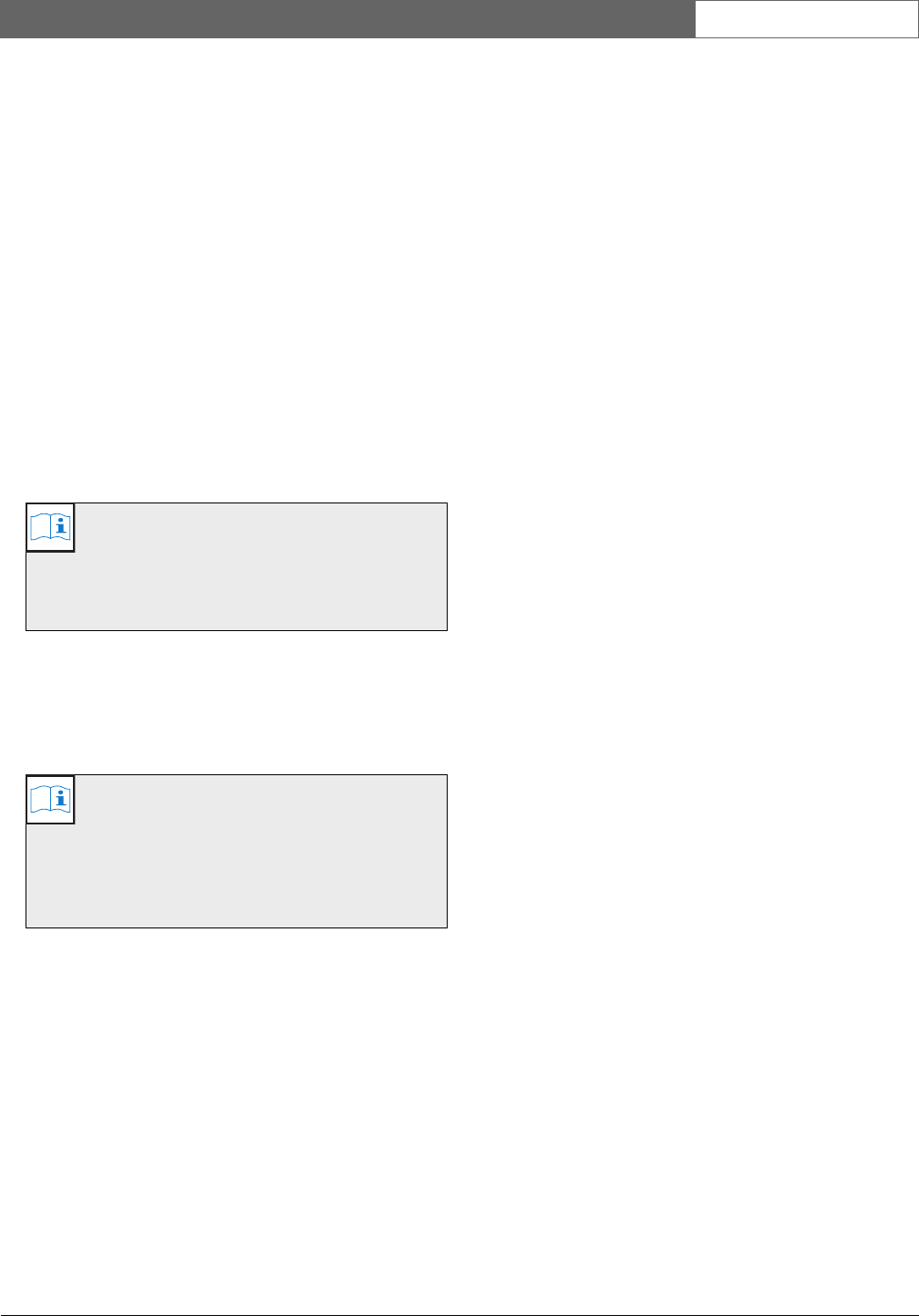
Bosch Security Systems | 2007-11 | 9922 141 70691 en
DCN Wireless | Installation and User Instructions | System Design and Planning en | 23
6 CobraNet
CobraNet is a standard for the transport of real-time
digital audio and control data through an Ethernet
network. A CobraNet network can transport a
maximum of 64 channels of 48 kHz, 20-bit audio
through a 100 Mbit link connection in each direction.
Many manufacturers of professional audio devices
support the CobraNet standard.
The DCN Wireless digital congress network can
connect to CobraNet networks with the LBB4404/00
Cobranet Interface. For example, you can use the
LBB4404/00 Cobranet Interface to:
• Benefit from Ethernet infrastructure
• Transport audio signals over large distances
PC data, for example data from the DCN Wireless
Central Control Unit can co-exist with CobraNet data
on the same Ethernet network when you use managed
Ethernet switches that are approved by Peak Audio.
7User set-up
7.1 Public areas and walkways
Keep public areas clear of system and extension cables
and connections.
7.2 Headphones/headsets
Connect headphones or headsets to:
• the Wireless discussion units.
• the Interpreter desks.
• the Channel selector.
• the Integrus receivers.
Acoustic feedback between the connected headphones
or headsets and the microphone occurs when:
• The volume level is set too high.
• The headphones are too close to the activated
microphones (refer to section 8.7).
7.3 Speaking distance
The recommended speaking distance from the
microphone is 0.2 m to 0.4 m.
7.4 Interpreter booths
Make sure each interpreter booth has sufficient
dimensions. The International Organization for
Standardization (ISO) gives the specification for
interpreter booths. Refer to standard ISO 2603 ‘Booths
for simultaneous interpretation - General characteristics
and equipment’ for more data.
Note
Refer to the DCN Next Generation Installation
and User Instructions for the LBB4404/00
Cobranet Interface.
Note
Refer to the website of Peak Audio
(www.peakaudio.com) for:
• More data about CobraNet networks.
• A list of approved Ethernet switches.
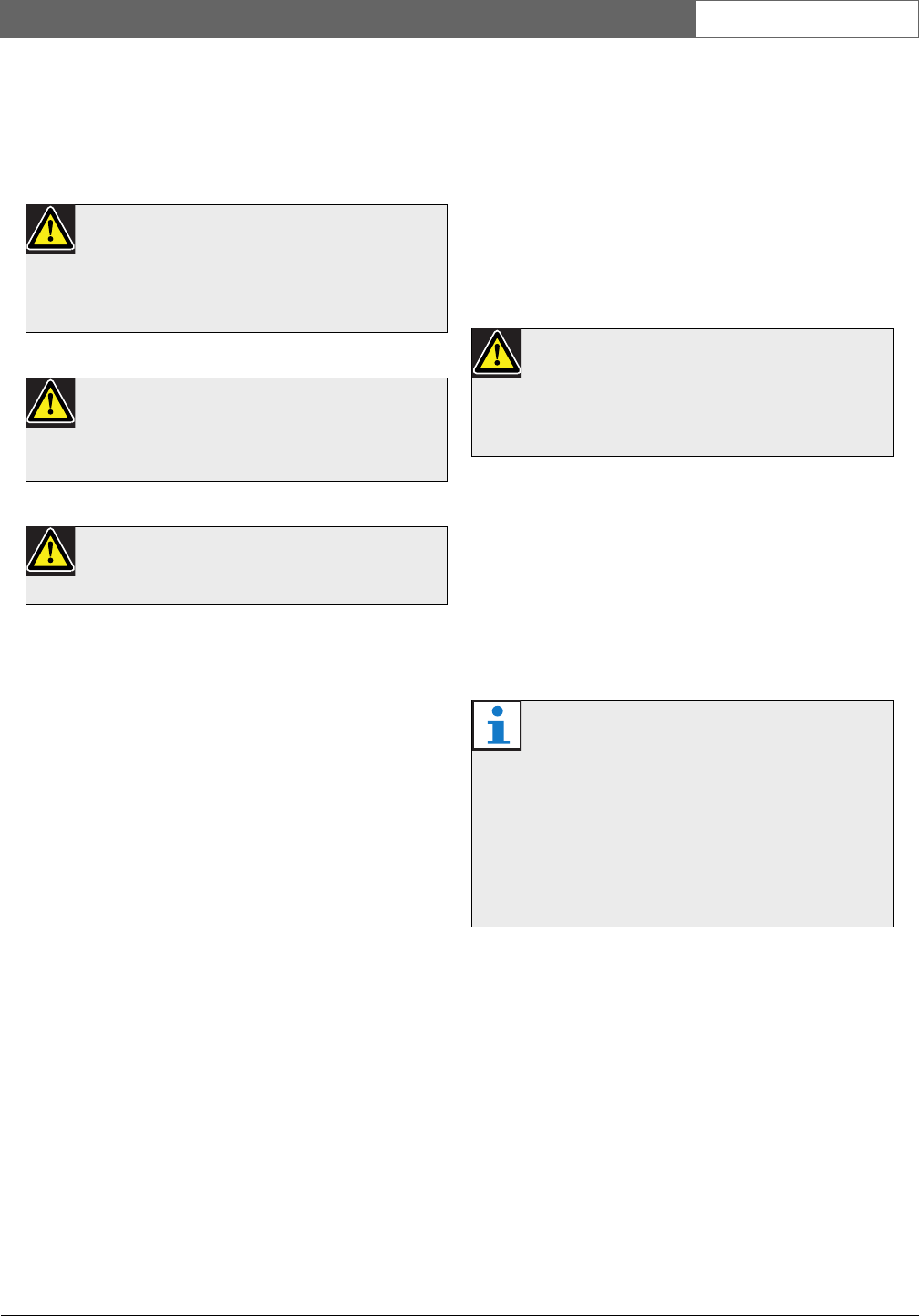
Bosch Security Systems | 2007-11 | 9922 141 70691 en
DCN Wireless | Installation and User Instructions | System Design and Planning en | 24
8 Device set-up
8.1 General
• Make sure that the area is clean.
• Make sure that the air is sufficiently cool.
• Make sure that there is sufficient lighting.
8.2 Cables
Use different cable ducts for the extension and mains
cables. Identify each cable with a label and divide
trunks to manageable geographic locations. In public
areas where people can touch or move above the
connectors and cables, use metal protection covers.
Refer to the applicable protection specification of the
protection covers.
8.3 Temperature
When devices are in a 19-inch rack, make sure there is
rack space between the devices to let sufficient air flow.
Forced airflow may be necessary to keep the
temperature of the devices below the maximum
temperature (refer to section 9.2). This extends the
lifetime of the devices.
8.4 Ventilation
Keep a good airflow. Airflow holes are in the front, right
and left sides of all 19-inch devices (for example, the
central control unit and the audio expander).
• Put the devices on a hard and level surface.
• Put the central control unit at minimum distance of
0.10 m from walls to let sufficient air flow.
8.5 Cleaning
1 Disconnect the mains power supply from the
devices, if you want to clean the devices.
2 Use a soft cloth that is not fully moist with a weak
soap and water solution.
3 Let the device fully dry before you operate the
device again.
8.6 Storage
1 Disconnect the mains power supply from the
devices, if you do not use the devices for a long time.
2 Keep the devices in a clean and dry area with a
sufficient airflow.
3 Remove the batteries of the wireless discussion units.
Caution
Do not put objects on top of devices. Objects
can fall through the airflow holes. A blockage of
the airflow holes can cause a risk of fire.
Caution
Do not put the devices near or above a radiator,
heat grill or in direct sunlight.
Caution
Do not cause vibration of the devices.
Caution
Do not use alcohol, ammonia or petroleum
solvents or abrasive cleaners to clean the
devices.
Note
If the central control unit is stopped or
disconnected from the mains power supply for
more than 100 days, the values of all system
parameter are erased. This includes all the
values of the parameters of the interpreter desks
and the wireless access point. This does not
include the subscription list.

Bosch Security Systems | 2007-11 | 9922 141 70691 en
DCN Wireless | Installation and User Instructions | System Design and Planning en | 25
8.7 Acoustic feedback
Acoustic feedback (‘howling’) occurs when the sound of
the loudspeakers or headphones in the system is sent to
the system again by activated microphones.
table 8.1: Acoustic feedback
Source Quick solution Structural solution
The acoustic feedback is caused by
the loudspeakers of the contribution
devices.
Decrease the volume level of the
system. For example, with the knob
on the front of the central control
unit (refer to section 10.6.3).
Do as follows:
1 Install a feedback suppressor
between audio input 2 and audio
output 2 of the central control
unit.
2 Set the audio routing mode of
the system to Insertion (refer to
section 12.6).
The acoustic feedback is caused by
an external public address system
that is connected to the DCN
Wireless digital congress network.
Decrease the volume level of the
public address system or the DCN
Wireless digital congress network.
Install a feedback suppressor
between audio output 1 and the
input of the external public address
system.
The acoustic feedback is caused by
the headphones that are connected
to the contribution devices.
Tell the chairmen and the delegates
to decrease the volume level of their
headphones with their contribution
devices.
Install and configure the
headphones level reduction of the
contribution devices. (Refer to the
section about the contribution
devices.)

Bosch Security Systems | 2007-11 | 9922 141 70691 en
DCN Wireless | Installation and User Instructions | System Design and Planning en | 26
9 Technical data 9.1 System electrical and
electro-acoustic
characteristics
9.1.1 General
9.1.2 Routing links
• From delegate microphone to interpreter
headphones
• From delegate microphone to delegate headphones
• From interpreter microphone to delegate
headphones
• From interpreter microphone to interpreter
headphones
• From auxiliary input to delegate headphones
• From auxiliary input to interpreter headphones
• From delegate microphone to auxiliary output
• From interpreter microphone to auxiliary output
table 9.1: Electro-acoustic characteristics
Nominal input level:
85 dB SPL
Maximum input level:
110 d B S P L
Automatic gain reduction (not for PA-floor output):
• 24 dB (interpretation channels)
• 12 dB (delegate loudspeaker channel)
Automatic gain reduction with:
• 3 dB (2 microphones on)
• 6 dB (4 or more microphones on)
Loudspeaker volume control:
24 steps of 1 dB and off (mute)
table 9.2: Transmission links
Frequency response:
• 125 Hz to 20 kHz (General)
• 125 Hz to 3.5 kHz (Intercom links)
Harmonic distortion:
< 0.5%
Harmonic distortion @ overload:
< 1%
Crosstalk attenuation @ 4 kHz:
> 80 dB
Dynamic range:
> 90 dB

Bosch Security Systems | 2007-11 | 9922 141 70691 en
DCN Wireless | Installation and User Instructions | System Design and Planning en | 27
9.1.3 Combined devices from input to
output
• Delegate microphone with transmission link to
interpreter headphones
• Delegate microphone with transmission link to
delegate headphones
• Delegate microphone with transmission link to
auxiliary output
• Interpreter microphone with transmission link to
interpreter headphones
• Interpreter microphone with transmission link to
delegate headphones
• Interpreter microphone with transmission link to
auxiliary output
9.2 Environmental conditions
9.3 Safety
According Low-Voltage Directive (LVD) 2006/95/EC.
• For European countries: according EN60065.
Marking: CE
• For international countries: IEC 60065 according
CB-Scheme.
• For North America:
• USA: ANSI/UL 60065
• Canada: CAN/CSA no. 60065
• Marking c-CSA-us.
table 9.3: Combined devices from input to output
Typical frequency response:
125 Hz to 20 kHz
Front-to-random sensitivity index:
> 4.6 dB
Rated equivalent sound pressure level due to inherent noise:
< 25 dB(A)
Total harmonic distortion @ overload:
< 1%
Crosstalk attenuation:
> 80 dB
table 9.4: Environmental conditions
Working conditions:
Fixed, stationary, transportable
Temperature range:
• -20 to +70 °C (transport)
• +5 to +45 °C (operation)
• For EPS and contribution devices with an LCD, the maximum temperature is +40 °C.
Relative humidity:
< 95%
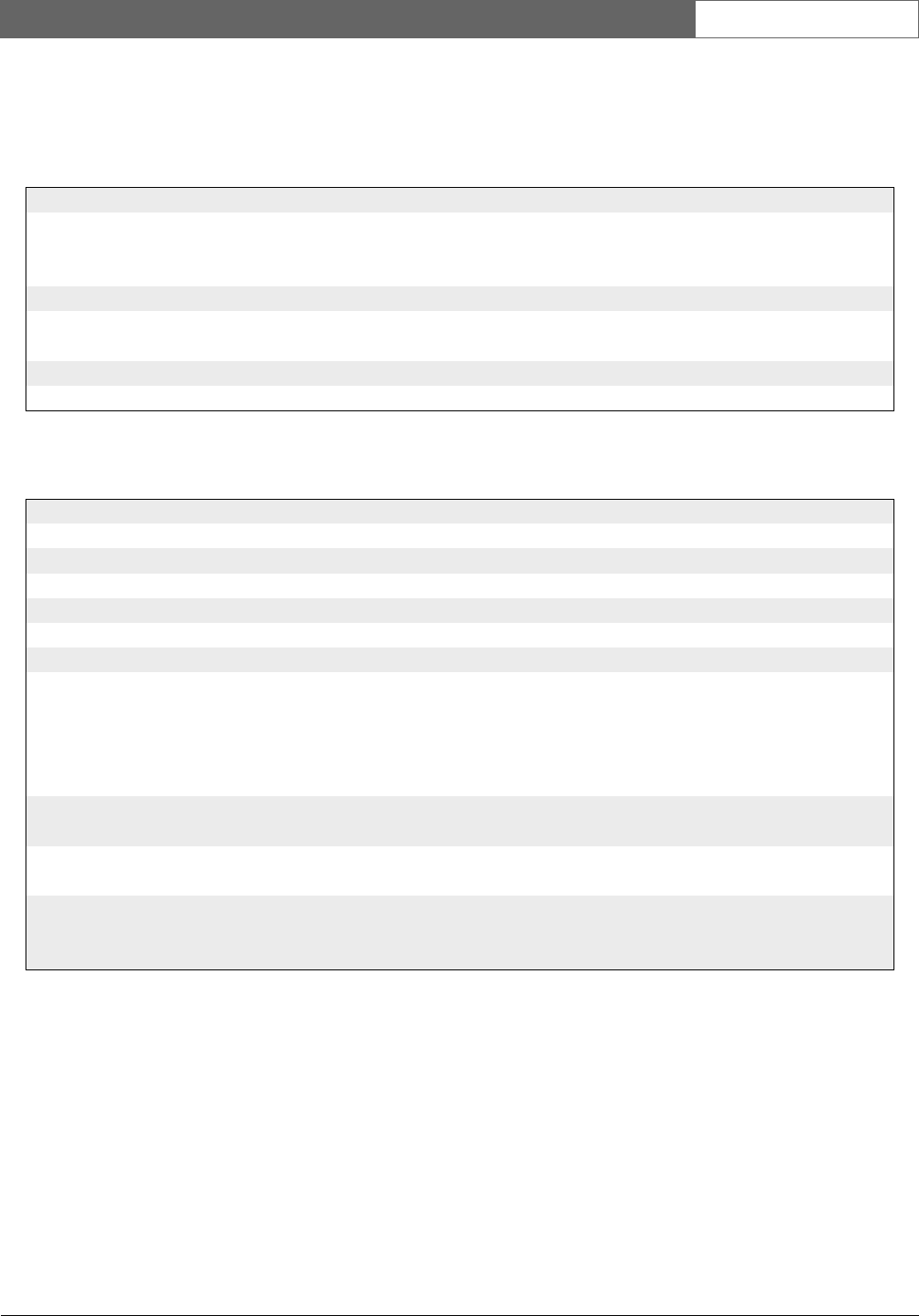
Bosch Security Systems | 2007-11 | 9922 141 70691 en
DCN Wireless | Installation and User Instructions | System Design and Planning en | 28
9.4 Electro-magnetic
compatibility
9.5 Wireless devices
table 9.5: Electromagnetic compatibility
EMC compatibility:
According EMC Directive 2004/108/EC
European approvals: CE marking
EMC environment: for commercial or professional use
EMC emission:
According harmonized standard EN 55103-1 (E3) (prof. audio/video equipment)
According FCC rules (FCC part 15) complying to limits for class A digital devices
EMC immunity:
According harmonized standard EN 55103-2 (E3) (prof. audio/video equipment)
table 9.6: Wireless devices
Frequency
2400 - 2483.5 MHz
Max. transmitting power:
100 mW e.i.r.p.
Bandwidth:
22 MHz
Leading listed and certified country approvals:
Europe CE
Standard Telecom
EMC
Safety
EN 300 328
EN 301 489-1
EN 301 489-17
EN 60950-1
USA Standard Telecom, EMC
Safety
FCC part 15.247
ANSI / UL 60950-1
Canada Standard Telecom, EMC
Safety
RSS 210
CSA 22.2 no. 60950-1
Japan Standard Telecom, EMC Ordinance regulating
radio equipment: Item 19
Article 2

Bosch Security Systems | 2007-11 | 9922 141 70691 en
DCN Wireless | Installation and User Instructions | System Design and Planning en | 29
9.6 Miscellaneous
table 9.7: Miscellaneous
Basic standard ESD:
According EN 61000-4-2.
Contact discharge: 4 kV and air discharge: 8 kV
Basic standard mains harmonics and voltage fluctuations, flicker:
According EN 61000-3-2 and EN 61000-3-3
Basic standard RF electromagnetic fields:
According EN 61000-4-3
RF conducted: 150 kHz - 80 MHz: 3 Vrms
RF radiated 80 - 1000 MHz: 3 V/m
Cellular telephone (GSM) dummy test: at 20 cm speech distance
Criteria: not effecting normal operation.
Magnetic immunity:
Rack mounting: 50 Hz - 10 kHz: 4 - 0.4 A/m
No rack mounting: 50 Hz - 10 kHz: 3 - 0.03 A/m
Basic standard low energy electrical fast transients, bursts:
According EN 61000-4-4
Mains: fast transients: 1 kV; signal and control data lines: 0.5 kV
Basic standard high energy surges:
According EN 61000-4-5
Mains: surges: 1 kV CM and 0.5 kV DM.
Basic standard voltage dips, short interruptions, variations:
According EN 61000-4-11
Mains: voltage dips 100% for 1 period, 60% for 5 periods, > 95% for 5 seconds.

Bosch Security Systems | 2007-11 | 9922 141 70691 en
DCN Wireless | Installation and User Instructions | System Design and Planning en | 30
Intentionally left blank.

Bosch Security Systems | 2007-11 | 9922 141 70691 en
DCN Wireless | Installation and User Instructions | Central Devices en | 31
Section 2 - Central Devices
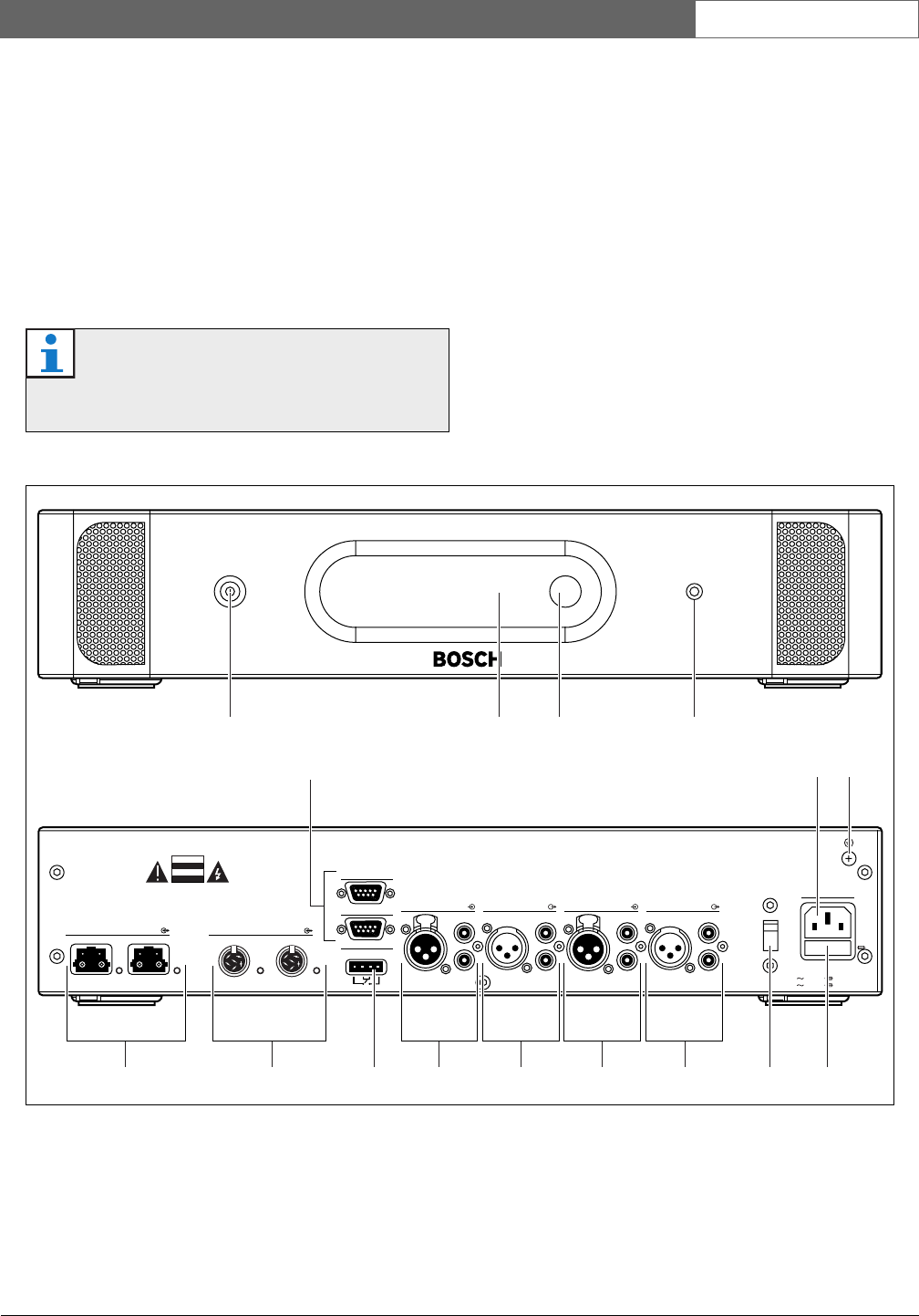
Bosch Security Systems | 2007-11 | 9922 141 70691 en
DCN Wireless | Installation and User Instructions | Central Devices en | 32
10 DCN-WCCU Wireless
Central Control Unit
10.1 Introduction
The DCN-WCCU Wireless Central Control Unit
controls the system. The central control unit can operate
with or without a control PC.
10.2 Controls, connectors and
indicators
10.2.1 Front view
The front of the central control unit (refer to figure 10.1)
contains:
1On/off switch - Starts and stops the central control
unit.
2Display - Shows the configuration menu (refer to
10.6).
3Knob - Operates the configuration menu (refer to
10.6). You can also change the volume level of the
system with the knob.
4Headphones socket - Connects headphones to
the central control unit (refer to 10.5.4).
Note
The DCN-WCCU-UL is the CSA/UL approved
version of the DCN-WCCU.
figure 10.1: Front and rear views
23 41
OK Fail
Fault
RS 232
Network
12
Audio In 1 Audio Out 1 Audio In 2 Audio Out 2
Mains
Port 2
115:100-120V 50-60Hz T2.5A 250V
230: 220-240V 50-60Hz T2A H 250V
RS 232 Port 1
Trunk
12
Avis
Caution
Riskof electric shock.
Do not open.
Riskof electric shock.
Do not open.
230
6 7
8 9
5
10 13 1411 12 11 12
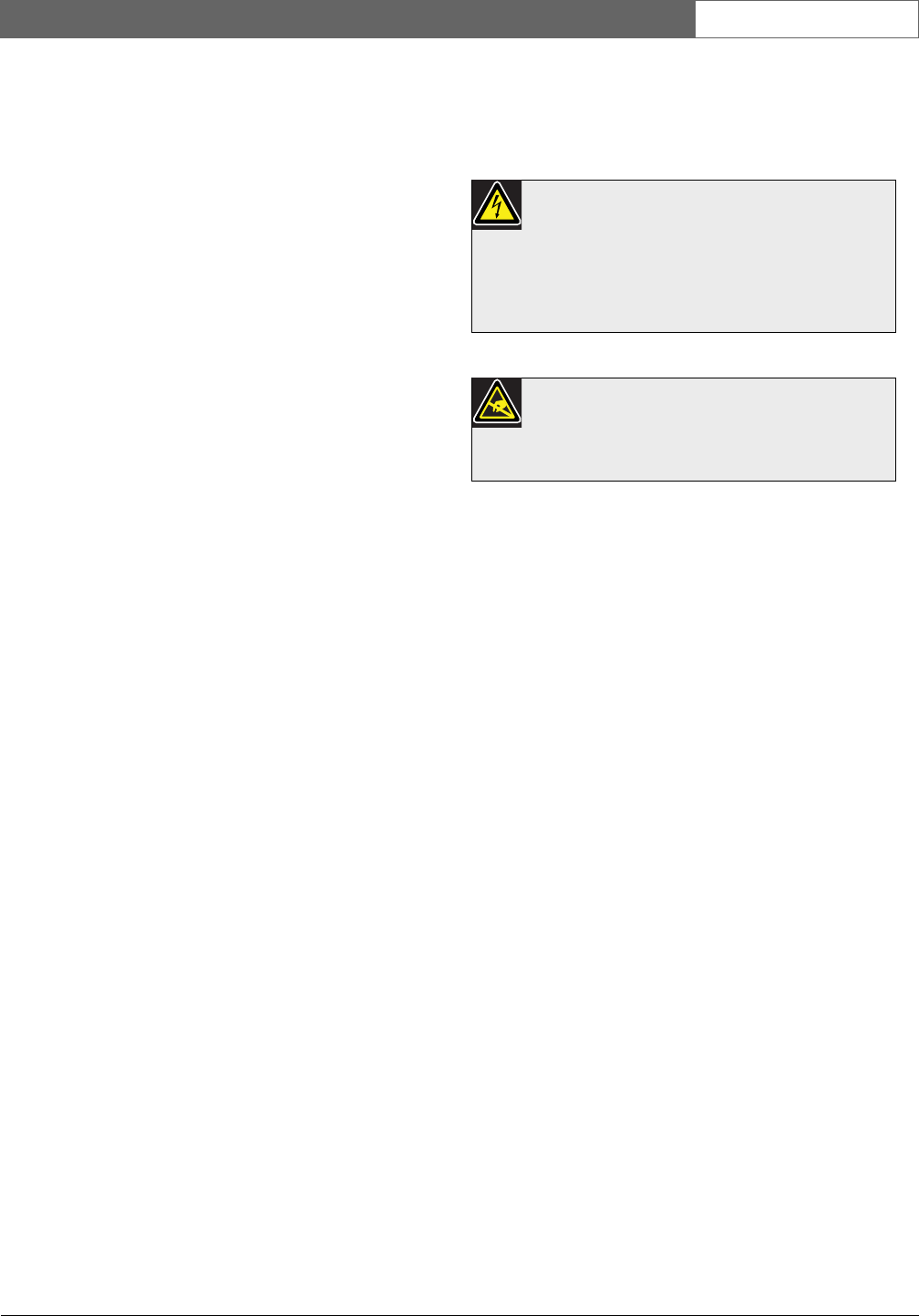
Bosch Security Systems | 2007-11 | 9922 141 70691 en
DCN Wireless | Installation and User Instructions | Central Devices en | 33
10.2.2 Rear view
The rear of the central control unit (refer to figure 10.1)
contains:
5RS232 ports - Connects a PC, remote controllers or
video cameras to the central control unit (refer to
10.5.8).
6Power inlet - Connects the central control unit to
the mains power supply with a power cable (refer to
10.5.1).
7Ground screw - Connects the central control unit
to ground.
8Optical network sockets - Connects the central
control unit to the optical network (refer to 10.5.3).
9DCN sockets - Connect the central control unit to
the DCN (refer to 10.5.2).
10 Fault contact - Connects the central control unit to
devices to sense the condition of the central control
unit (refer to 10.5.7).
11 Audio inputs - Connect the central control unit to
external analog audio sources (refer to 10.5.5).
12 Audio outputs - Connect the central control unit
to external analog audio devices (refer to 10.5.6).
13 Voltage selector - Selects the voltage on which the
central control unit must operate (refer to 10.5.1).
14 Fuse holder - Prevents damage to the internal
power supply unit of the central control unit (refer to
10.5.1).
10.3 Internal settings
10.3.1 Overview
The PCBs of the central control unit (refer to figure
10.2) contain:
15 Software LEDs - Show the condition of the
software of the central control unit. When the
software runs correctly, the yellow and green LEDs
flash.
16 S600 switches - Reserved (refer to 10.3.2).
17 X605 jumper block - Enables or disables the
watchdog (refer to 10.3.5).
18 Reset switch - Starts the central control unit again.
19 Optical network processor indicator - Comes
on when the optical network processor operates
correctly.
20 S500 switches - Configure the RS232 ports of the
central control unit (refer to 10.3.3).
21 X600 jumper block - Connects and disconnects
the internal back-up battery of the central control
unit (refer to 10.3.4).
22 X104 jumper block - Connects and disconnects
the mechanical ground and the electrical ground
(refer to 10.3.6).
23 Fuse - Prevents damage to the electronic
components in the central control unit.
Warning
Before you open the central control unit, discon-
nect it from the mains power supply. Electrical
discharges from the mains power supply can kill
you.
Caution
Before you open the central control unit, take
measures to prevent electro-static discharges.
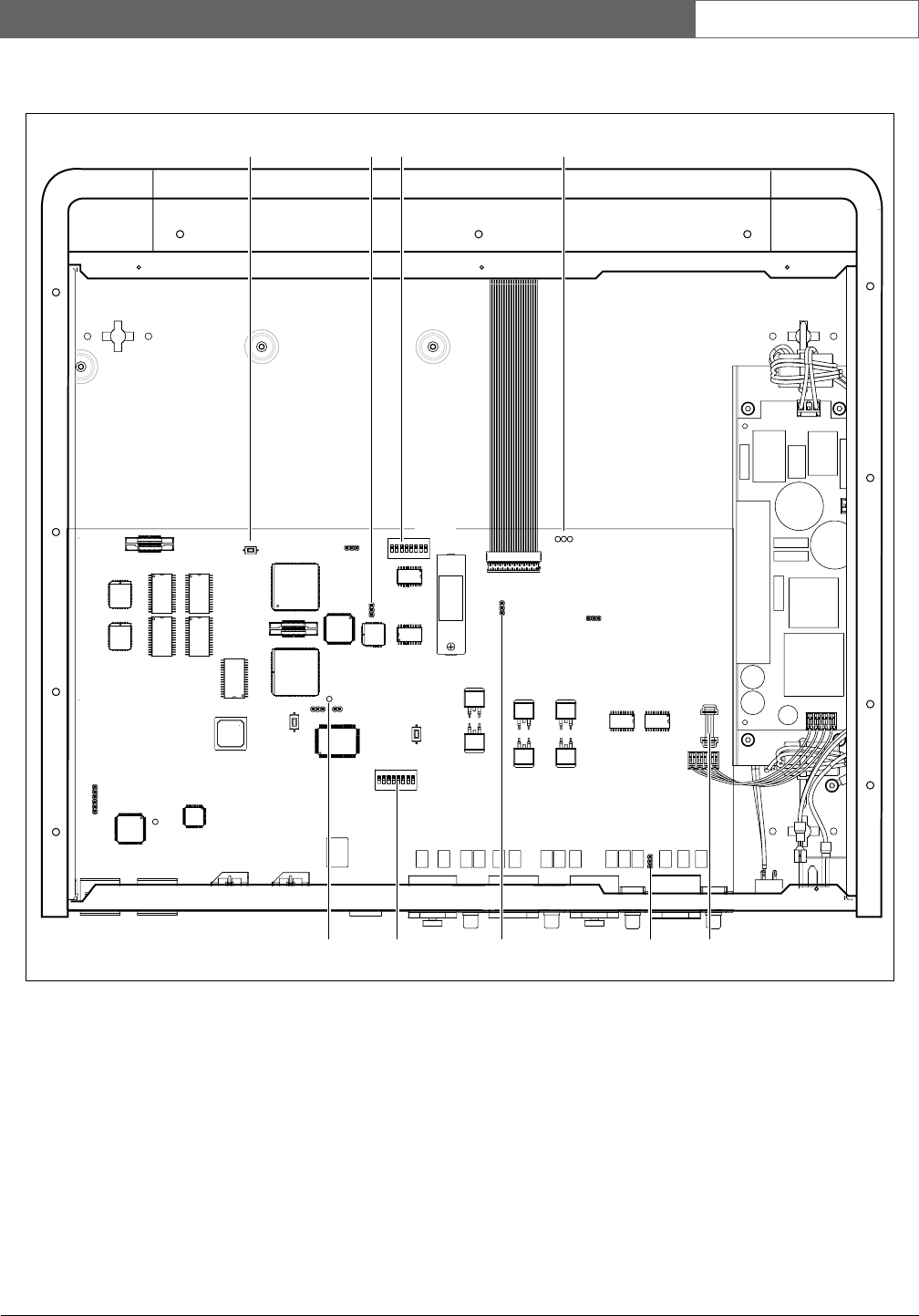
Bosch Security Systems | 2007-11 | 9922 141 70691 en
DCN Wireless | Installation and User Instructions | Central Devices en | 34
figure 10.2: Internal settings
57
ON
31 864
2
57
ON
31864
2
E3
E4
E1
E2
E8
E5
E9
E6
E7
E12
E10
E11
E13
E14
E15
E16
T3 R3
R2
T4
K3
T1
K4
K1R1
K2T2
R4
R7
T5
R6
R9
T6
K5
K6
R5
T7 K7
T8 K8
T9 K9
R8
K12
K13
K10
K14
K11
K15
K16
B1
B2
D3
C1
A3
C4
C2
B4 A4
D1
A2
C3
D2
D4
A1
B3
B7D7
C5 A5
D8
B5
C6 A6
D9
B8
C7 A7
C9
C8 A8
B9
D5
A9
B6D6
B13
D11
B14 A14
D12
A10C10
A11
A13
C11
A12
B10
C12
D14
B11
C13
C14
B12
D10
D13
B16C16D16
D15 A15
A16
B15C15
H1
J4 F4
H2
G3
J1 F1
G4
J2 F2
H3
G1
H4
G2
J3 F3
G8
G5J5
J9 G9
J6
H7
F6
F8H8
F7
F9H9
G6
H5
G7
F5
H6
J8
J12
G13
J10
F13
G14
F10
H13
F11
H14
H11
F12
G10
J13
H12
F14
G11
J14
J11
G12
H10
F15
F16
H15J15 G15
H16 G16J16
L1N1
L3
L2M2
L4
M1
N2
P4
N3 M3
N4 M4
P2
P3
P1
P5
M6P6
L8
M7P7
L9
N5 M5
P8 M8
N6 L6
P9 M9
N7 L7
N8
N9
L5
N12R12
M10
P14 N14
R11 M11
L10P10R10
M13
L11P11
R13
M14
L12P12
R14
N10
L13P13
M12
N11
L14
N13
N16P16R16
P15R15 N15 L15
L16
M15
T10
T11
T12
T13
T14
T16
T15
2322
21
15
17 1618
20
19
B601
B602
B604
X14
F100
X600 X103
G600
X155
S600
X605
S800
S601
B1000
X1000
X1001
X104
S500
S1000
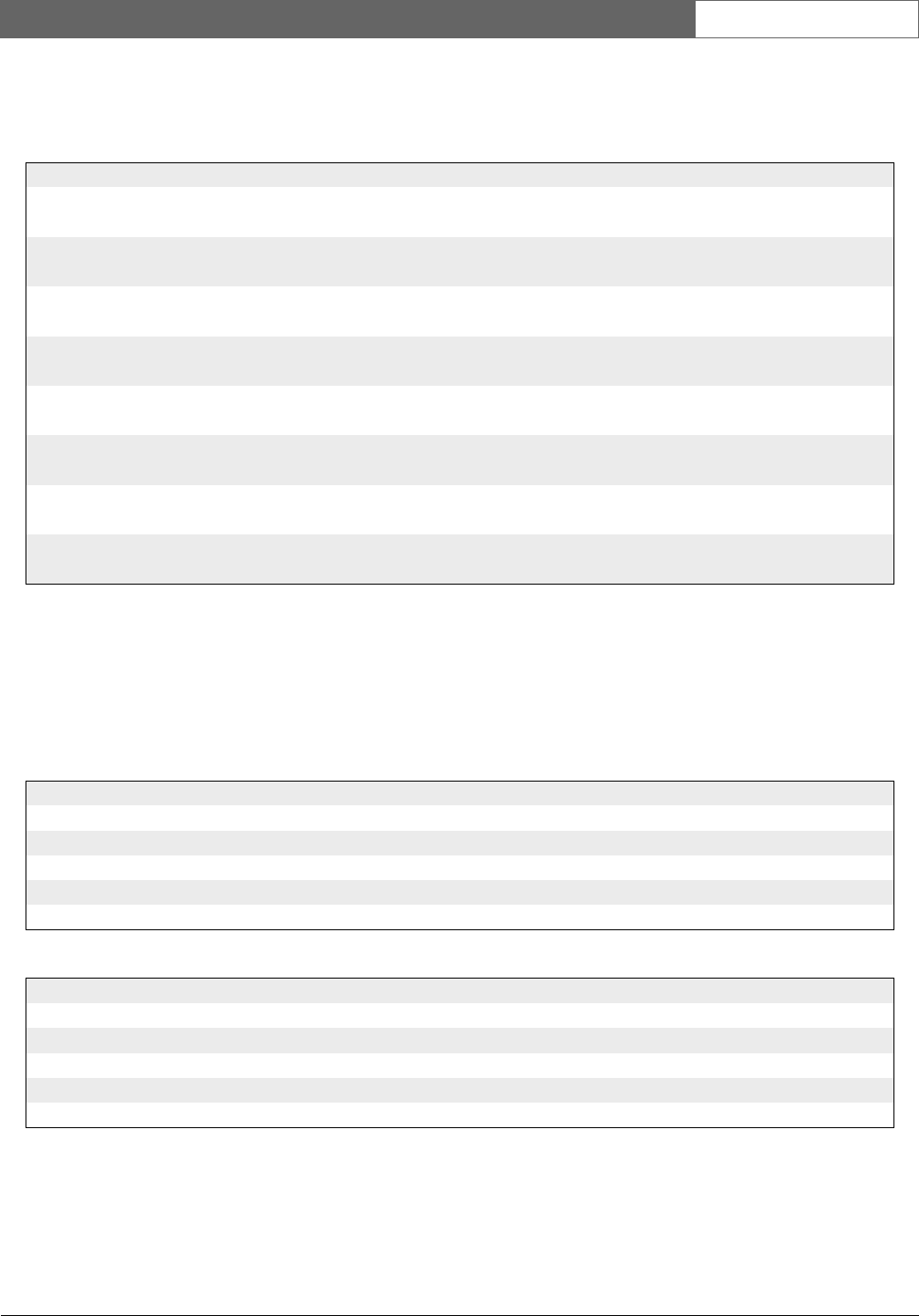
Bosch Security Systems | 2007-11 | 9922 141 70691 en
DCN Wireless | Installation and User Instructions | Central Devices en | 35
10.3.2 S600 switches
10.3.3 RS232 configuration
Use the S500 switches to configure the RS232 ports of
the central control unit (refer to table 10.2 and table
10.3).
table 10.1: S600 switches (* = default)
Switch Position Description
S600-1 ON*
OFF
Reserved. Do not change the position of this switch.
S600-2 ON
OFF*
Reserved. Do not change the position of this switch.
S600-3 ON
OFF*
Reserved. Do not change the position of this switch.
S600-4 ON
OFF*
Reserved. Do not change the position of this switch.
S600-5 ON
OFF*
Reserved. Do not change the position of this switch.
S600-6 ON
OFF*
Reserved. Do not change the position of this switch.
S600-7 ON
OFF*
Reserved. Do not change the position of this switch.
S600-8 ON
OFF*
Boot mode. Enables the download of new firmware (in case a download failed).
Normal operation.
table 10.2: RS232 protocol (* = default)
Protocol Port 1 Port 2
S500-1 S500-2 S500-5 S500-6
Open interface Off Off Off Off
Terminal Off On Off On
Full On* Off* On Off
Camera control On On On* On*
table 10.3: RS232 baudrate (* = default)
Baudrate Port 1 Port 2
S500-3 S500-4 S500-7 S500-8
9.6k Off Off Off Off
19.2k Off On Off* On*
57.6k On Off On Off
115.2k On* On* On On
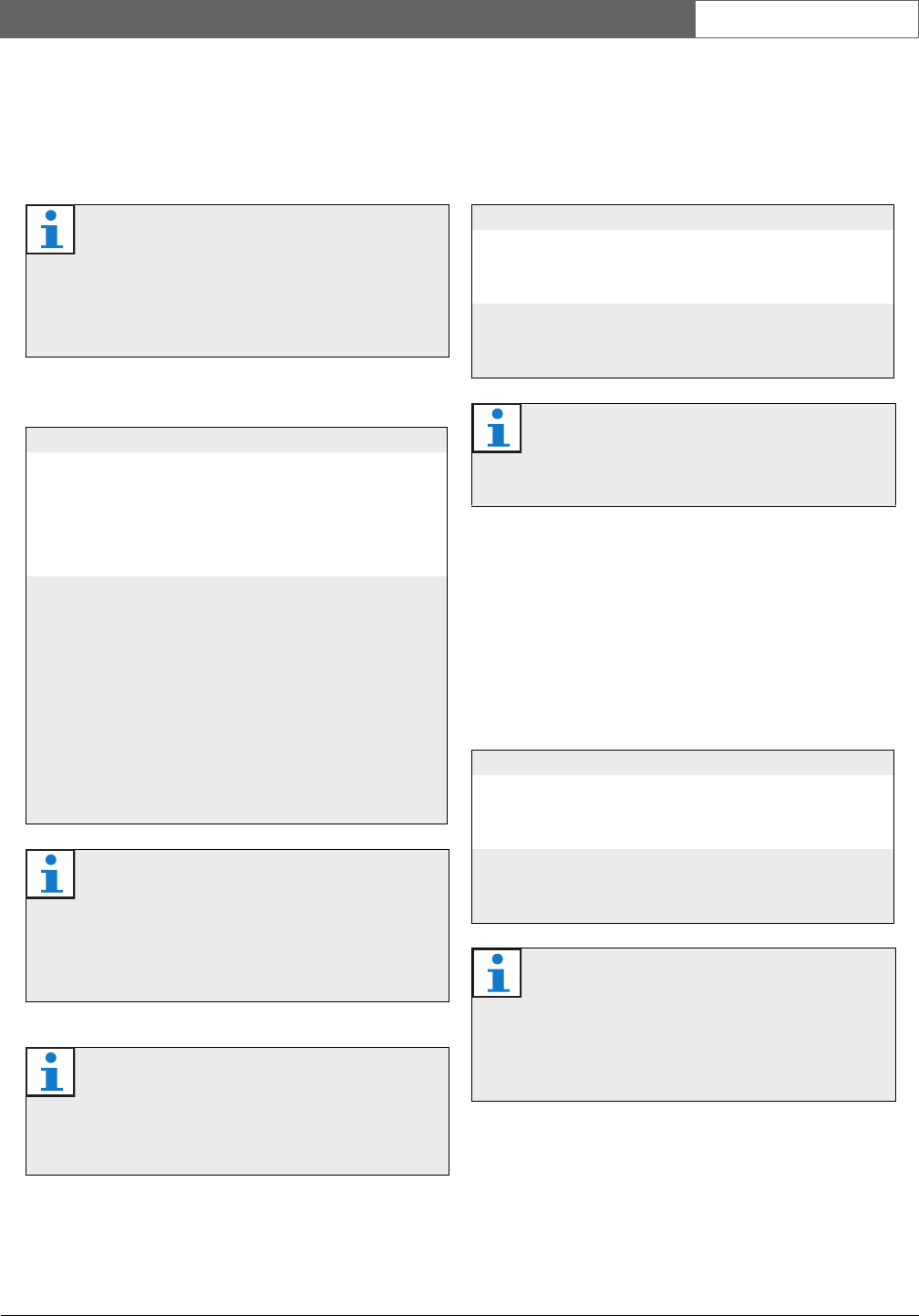
Bosch Security Systems | 2007-11 | 9922 141 70691 en
DCN Wireless | Installation and User Instructions | Central Devices en | 36
10.3.4 Internal back-up battery
Use the X600 jumper block to connect and disconnect
the internal back-up battery of the central control unit
(refer to table 10.4).
10.3.5 Watchdog
Use the X605 jumper to enable or disable the watchdog
of the central control unit (refer to table 10.5).
10.3.6 Ground
Use the X104 jumper block to connect and disconnect
the system ground and the ground of the central control
unit (refer to table 10.6). For example, you can connect
the system ground and the ground of the central control
unit to prevent hum.
Note
When your central control unit is new, you must
energize the central control unit to charge the
internal back-up battery. The internal back-up
battery is fully charged after 24 hours.
table 10.4: X600 jumper block (* = default)
Jumper shunt Description
1 and 2 * Connects the internal back-up
battery. When you stop the
central control unit, the memory
of the central control unit is not
erased.
2 and 3 Disconnects the internal
back-up battery. When you stop
the central control unit, the
memory of the central control
unit is immediately erased. The
memory of the central control
unit contains:
• The license code
• The settings of the
interpreter desks.
Note
You only have a license code when you use the
system in combination with:
• The PC Control Software
• A remote controller
Note
The subscription list is not erased when the
internal back-up battery is empty. The
subscription list is stored in another location.
table 10.5: X605 jumper block (* = default)
Jumper shunt Description
Present The watchdog is disabled. The
central control unit does not
start again after an error.
Not present* Enables the watchdog. The
central control unit starts again
after an error.
Note
When you disable the watchdog, the system
can operate incorrectly.
table 10.6: X104 jumper block (* = default)
Jumper shunt Description
1 and 2 Connects the system ground
and the ground of the central
control unit.
2 and 3 * Disconnects the system ground
and the ground of the central
control unit.
Note
When you connect the system ground to the
ground of more than one device in the system,
you can create ground loops. Ground loops can
cause hum.
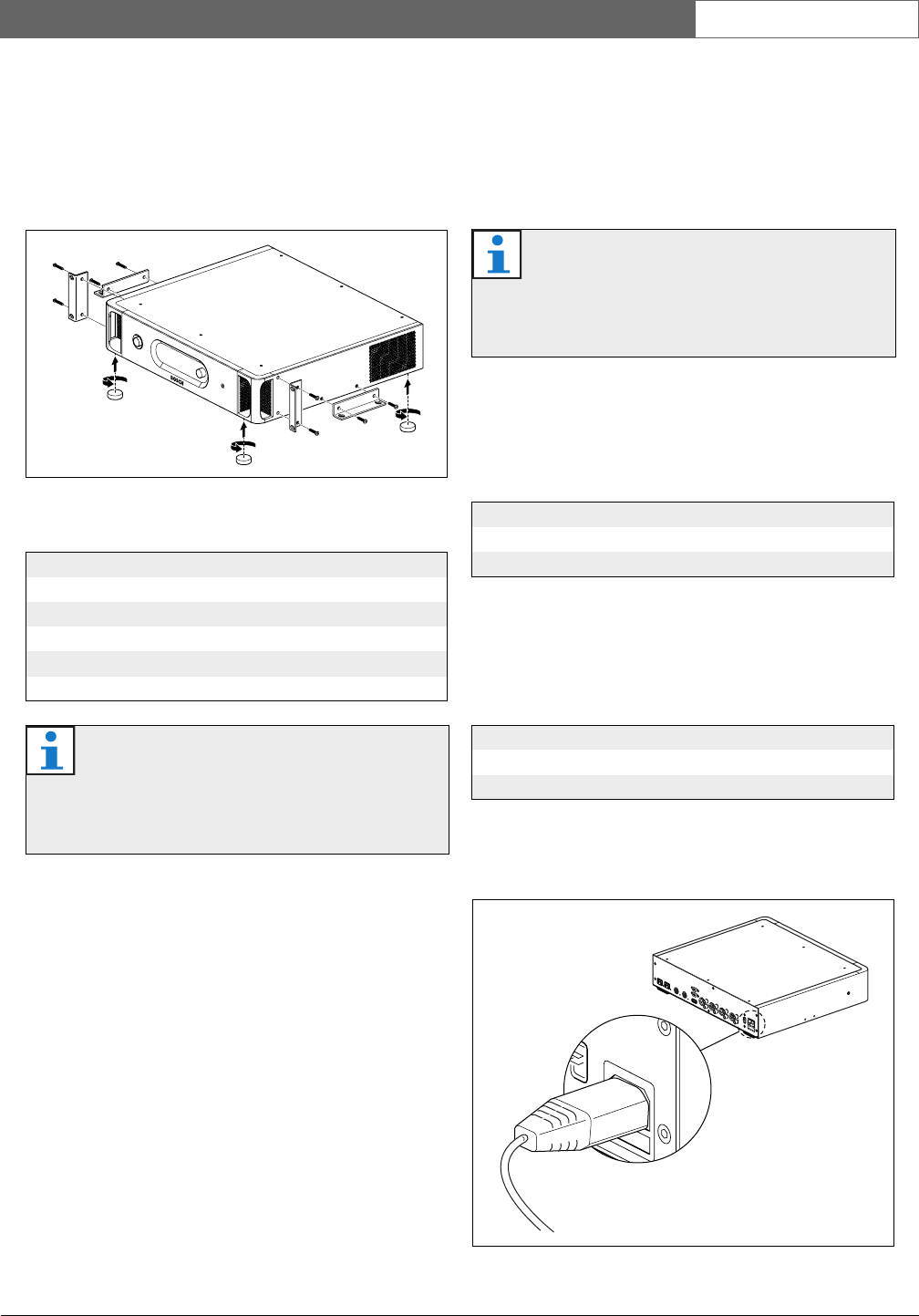
Bosch Security Systems | 2007-11 | 9922 141 70691 en
DCN Wireless | Installation and User Instructions | Central Devices en | 37
10.4 Installation
Install the central control unit in a 19-inch rack system
or on a flat surface. Four feet and two brackets are
supplied with the central control unit (refer to figure
10.3).
10.5 External connections
10.5.1 Power supply
Use the following procedure to connect the central
control unit to a mains power supply:
1 Set the voltage selector on the rear of the central
control unit to the correct position (refer to table
10.8).
2 Make sure that the fuse holder in the rear of the
central control unit contains the correct fuse (refer to
table 10.9).
3 Connect a locally approved power cable to the
central control unit (refer to figure 10.4).
figure 10.3: Installation
table 10.7: Physical characteristics
Dimensions (h x w x d), flat surface:
92 x 440 x 400 mm (without brackets, with feet)
Dimensions (h x w x d), 19-inch rack system:
88 x 483 x 400 mm (with brackets, without feet)
Weight:
6.7 kg (without brackets, without feet)
Note
When you install the central control unit in a
19-inch rack system, the central control unit
extends 36 mm in front of the brackets.
Note
The DCN-WCCU is configured for a voltage of
220 - 240 V(AC). The DCN-WCCU-UL is
configured for a voltage of 100 - 120 V(AC).
table 10.8: Voltage selector
Power supply voltage Voltage selector
90 to 132 V(AC) 115
198 to 264 V(AC) 230
table 10.9: Fuses
Voltage selector Fuse
115 T2.5A 250 V (UL 248)
230 T2AH 250 V (IEC 60127)
figure 10.4: Power supply
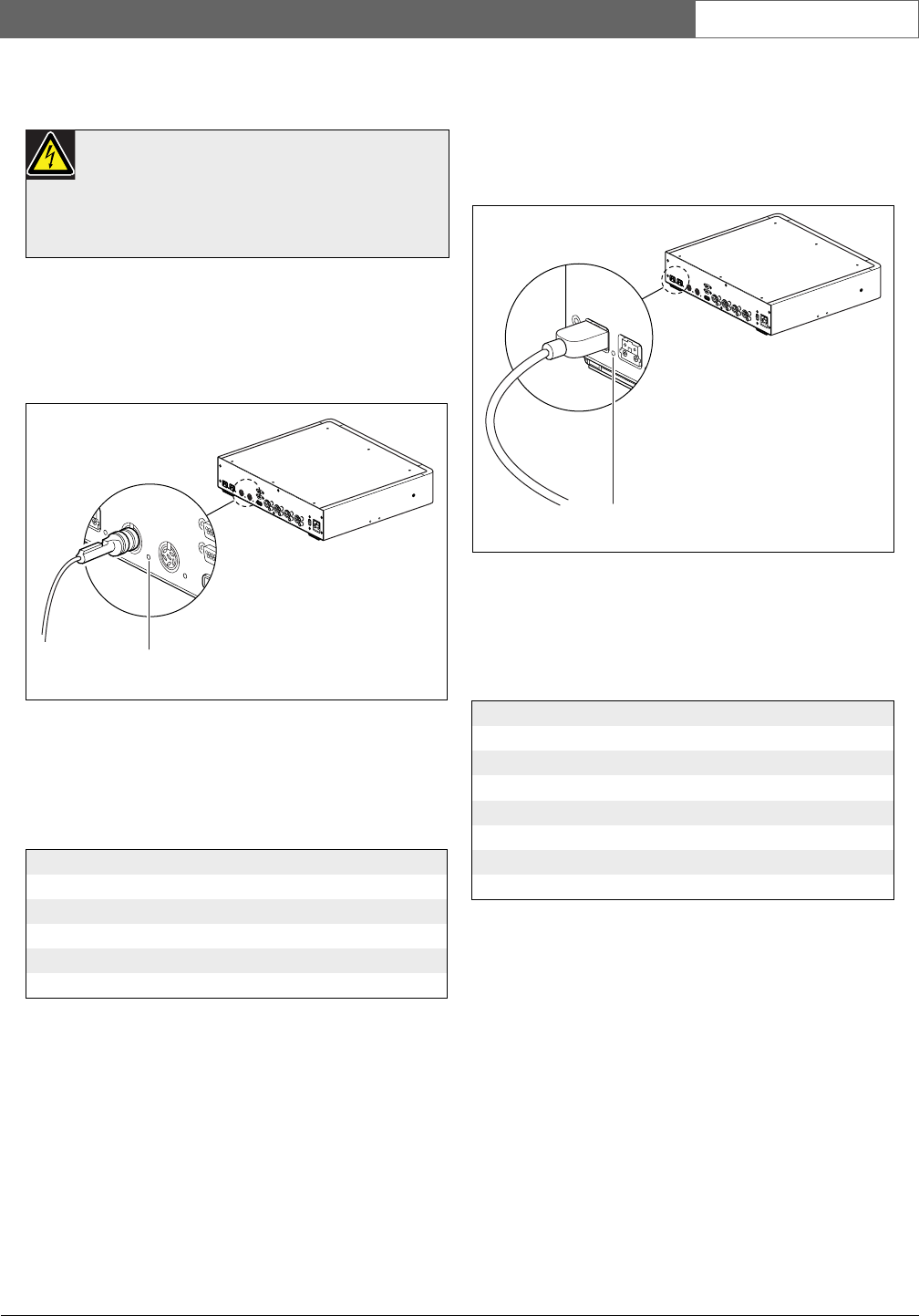
Bosch Security Systems | 2007-11 | 9922 141 70691 en
DCN Wireless | Installation and User Instructions | Central Devices en | 38
4 Connect the power cable to a power supply.
10.5.2 DCN
Connect the trunk of the DCN to the DCN sockets of
the central control unit (refer to figure 10.5).
Each DCN socket has a red LED that comes on if there
is an overload (refer to figure 10.5 and 3.5.4).
10.5.3 Optical network
Connect the trunk of the optical network to the optical
network sockets of the central control unit with optical
network cables (refer to figure 10.6).
Each optical network socket has a red LED that comes
on if there is an overload (refer to figure 10.6 and 3.5.4).
Warning
Make sure that the mains power supply is
grounded. Electrical discharges from the mains
power supply can kill you.
figure 10.5: DCN
table 10.10: DCN connection
Number of connections:
2x DCN socket
Location:
Rear side
Power supply:
max. 65 W
LED
figure 10.6: Optical network
table 10.11: Optical network connections
Number of connections:
2x proprietary sockets
Location:
Rear side
Nodes:
2
Power supply:
max. 65 W (refer to figure 3.1)
LED
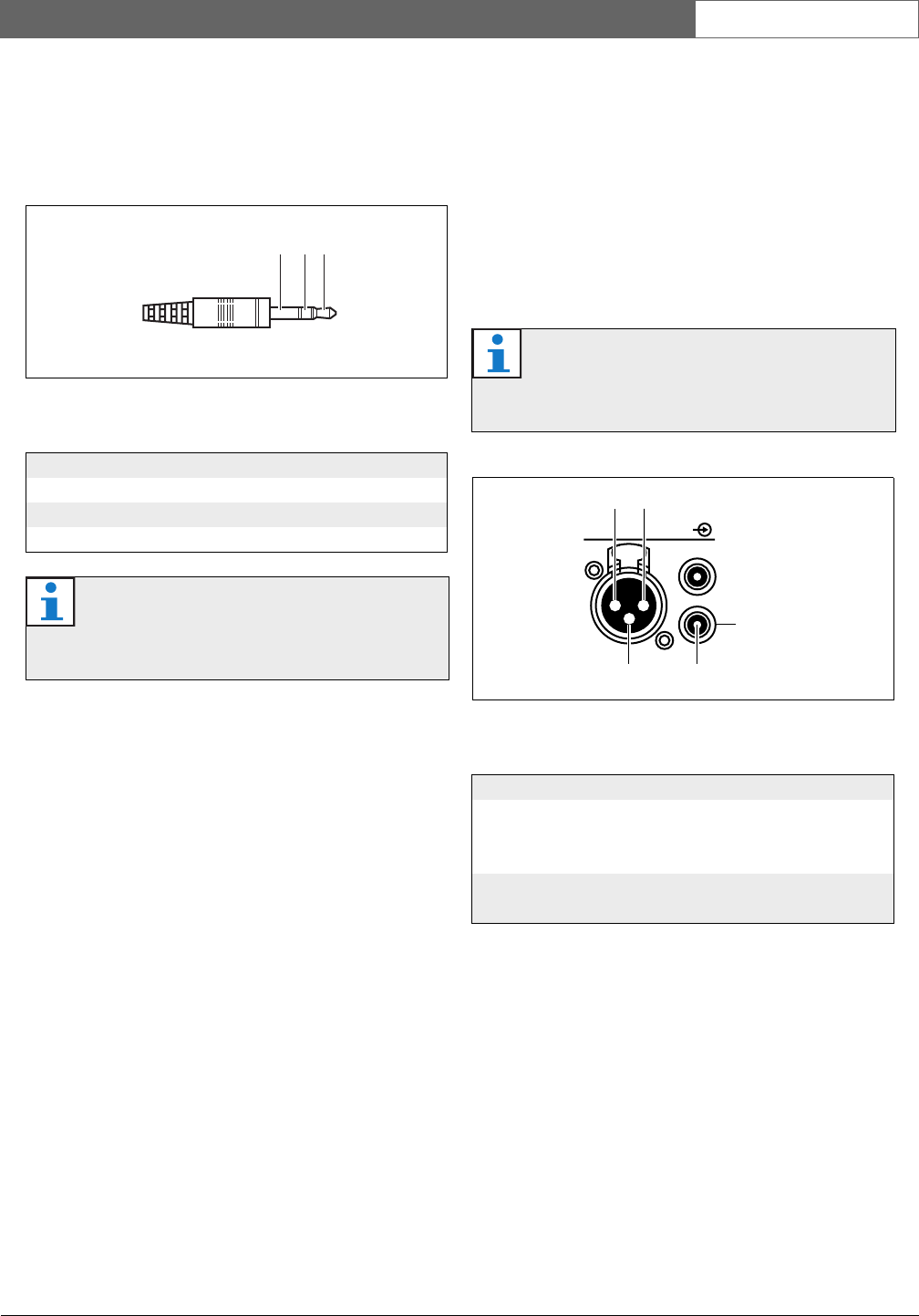
Bosch Security Systems | 2007-11 | 9922 141 70691 en
DCN Wireless | Installation and User Instructions | Central Devices en | 39
10.5.4 Headphones
You can connect headphones to the headphones socket
of the central control unit. The headphones must have a
3.5 mm plug (refer to figure 10.7).
You can select the signal that is available on the
headphones socket with the configuration menu (refer
to 10.6.5).
10.5.5 Audio inputs
You can connect an external analog audio source to the
audio inputs of the central control unit. The central
control unit has two audio inputs. Each audio input has
(refer to figure 10.8):
• 1 XLR socket for balanced signals. The electric
circuits behind the XLR sockets contain
transformers.
• 1 double cinch socket for unbalanced signals.
figure 10.7: 3.5 mm headphones plug, connection
table 10.12: 3.5 mm headphones plug, connection
Number Signal
1Left
2Common
3Right
Note
You can also connect mono headphones to the
headphones socket.
2 3 1
Note
The audio inputs change stereo signals in mono
signals.
figure 10.8: Audio input, connection
table 10.13: Audio input, connection
Pin Type Signal Description
1 XLR Xternal Shield/ground
2Live Positive
3 Return Negative
4Cinch Live Signal in
5Return Shield/ground
Audio In
2
34
1
5
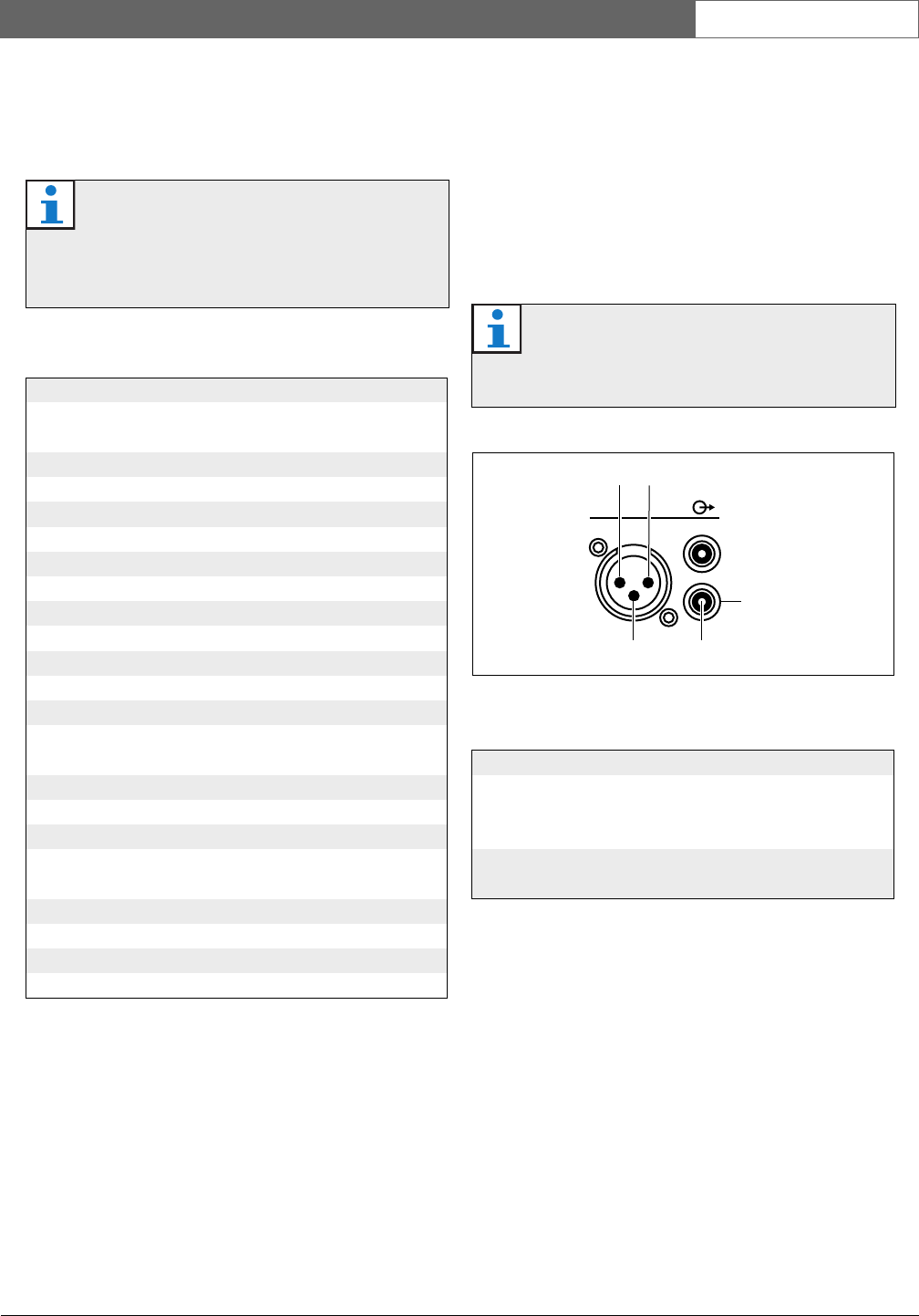
Bosch Security Systems | 2007-11 | 9922 141 70691 en
DCN Wireless | Installation and User Instructions | Central Devices en | 40
You can select the procedure that is used to send audio
signals through the central control unit with the audio
routing modes (refer to 10.6.8).
10.5.6 Audio outputs
You can connect an audio recording device or a public
address system to the audio outputs of the central
control unit. The central control unit has two audio
outputs. Each audio output has (refer to figure 10.9):
• 1 XLR plug for balanced signals. The electric circuits
behind the XLR plugs contain transformers.
• 1 double cinch socket for unbalanced signals.
Note
You can only connect line level sources to the
audio inputs of the central control unit. It is not
possible to connect microphone level sources.
table 10.14: Audio input details, line level signals
Number of connections:
• 1x XLR socket for each audio input
• 1x double cinch socket for each audio input
Location:
Rear side
Cable:
Shielded cable
Maximum level:
Refer to appendix A
Nominal level:
Refer to appendix A
Frequency response:
-3 dB @ 30 Hz and 20 kHz
Impedance:
• XLR: 22 kΩ
•Cinch: 12 kΩ
Signal-to-noise ratio:
> 85 dBA @ max. level
CMRR:
> 60 dB @ 100 Hz
> 50 dB @ 1 kHz
Crosstalk attenuation:
> 85 dB @ max. level
Distortion:
< 0.1% @ 100 Hz @ -3 dB of the max. input
Note
The two cinch sockets contain the same mono
signal.
figure 10.9: Audio output, connection
table 10.15: Audio output, connection
Pin Type Signal Description
1XLR Xternal Shield/ground
2Live Positive
3Return Negative
4Cinch Live Signal out
5Return Shield/Ground
Audio Out
1
34
2
5
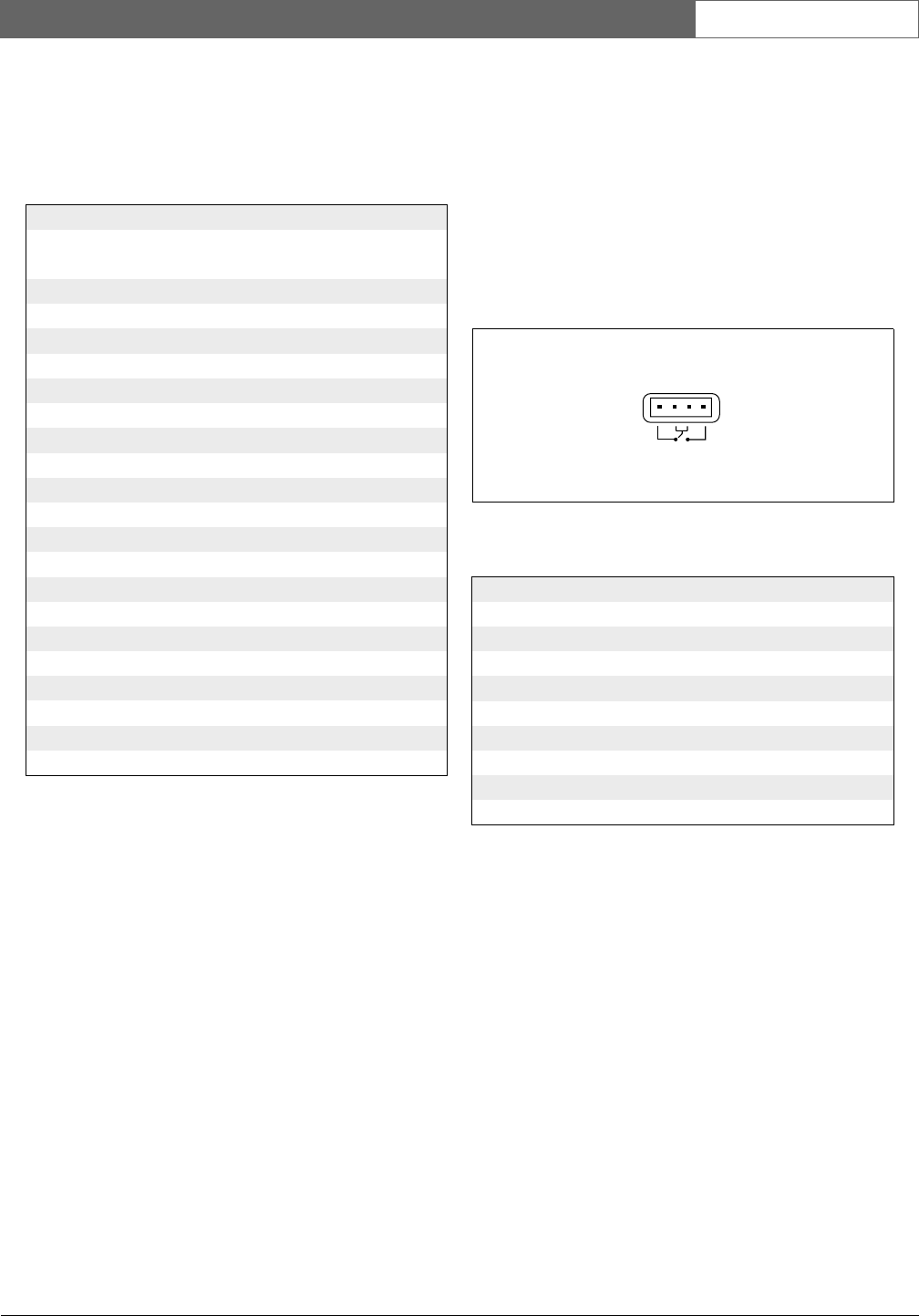
Bosch Security Systems | 2007-11 | 9922 141 70691 en
DCN Wireless | Installation and User Instructions | Central Devices en | 41
You can select the procedure that is used to send audio
signals through the central control unit with the
available audio routing modes (refer to 10.6.8).
10.5.7 Fault contact
Use the fault contact to send the condition of the central
control unit to external devices. If the central control
unit operates correctly, the OK pins are internally
connected. The central control unit internally connects
the Fail pins when:
• The central control unit is set to off.
• The internal power supply unit operates incorrectly.
• The central control unit does a reset.
table 10.16: Audio output details
Number of connections:
• 1x XLR plug for each audio output
• 1x double cinch socket for each audio output
Location:
Rear side
Cable:
Shielded cable
Maximum level:
Refer to appendix A
Nominal level (audio output 1):
Refer to appendix A
Nominal level (audio output 2):
Refer to appendix A
Frequency response:
-3 dB @ 30 Hz and 20 kHz
Impedance:
< 100 Ω
Signal-to-noise ratio:
> 89 dBA @ max. level
Crosstalk attenuation:
> 85 dB @ max. level
Distortion:
< 0.1% @ 100 Hz @ - 3 dB of the max. input
figure 10.10: Fault contact
table 10.17: Fault contact
Number of connections:
4-pole plug
Location:
Rear side
Signal:
Potential-free change-over relay
Voltage:
Max. 24 V(DC), 15 V(AC)
Current:
Max. 500 mA
OK Fail
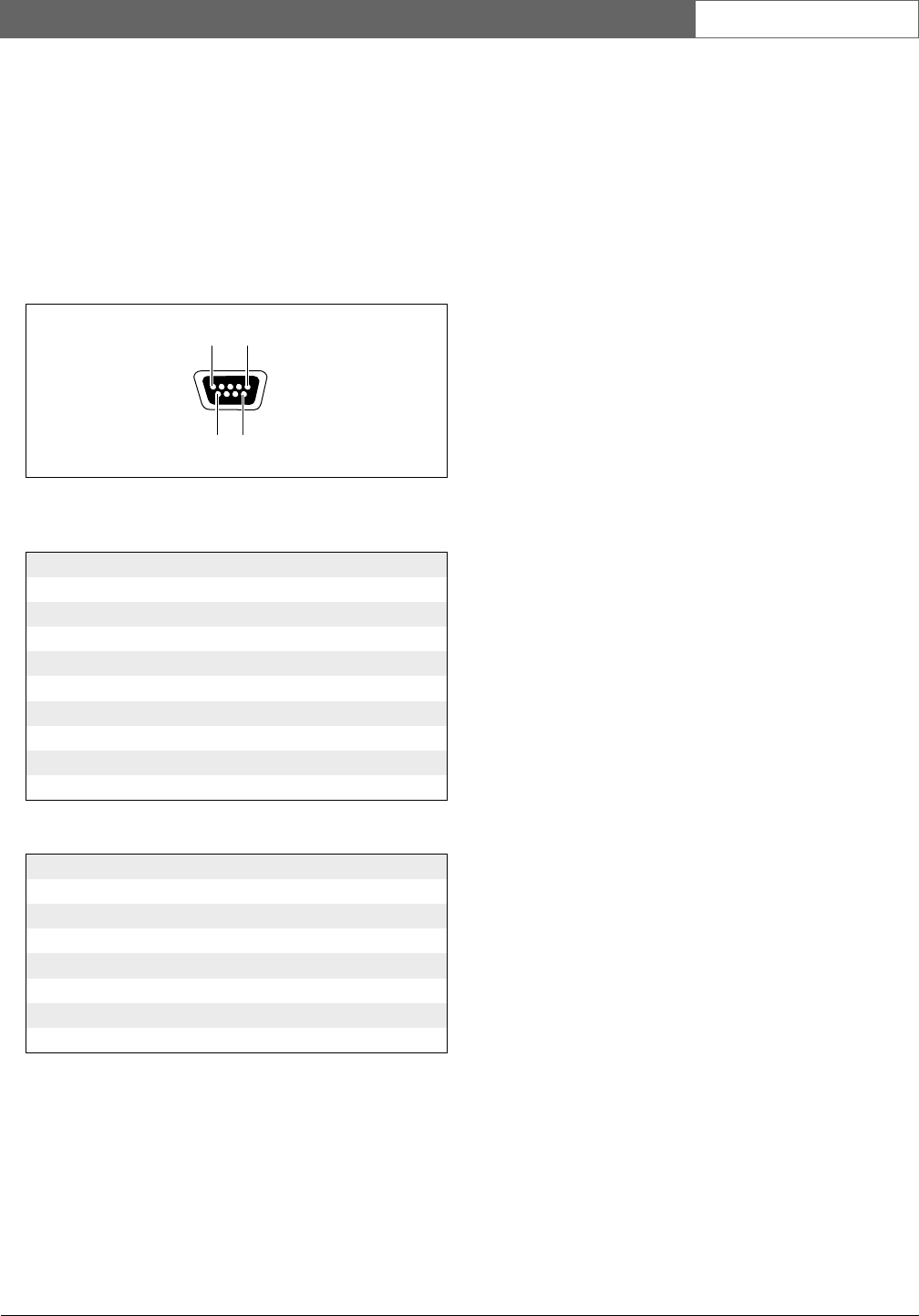
Bosch Security Systems | 2007-11 | 9922 141 70691 en
DCN Wireless | Installation and User Instructions | Central Devices en | 42
10.5.8 RS232 ports
You can connect a PC, remote controllers or video
cameras to the RS232 ports of the central control unit
(refer to the DCN Next Generation Installation and
User Instructions). The central control unit has 2 RS232
ports (refer to figure 10.11). You can set the protocol
and the baudrate of the RS232 ports with the S500
switches (refer to 10.3.3).
figure 10.11: RS232 port, connection
table 10.18: RS232 port, connection
Pin Definition Description
1 DCD Data Carrier Select
2RxD Receive Data
3TxDTransmit Data
4DTR Data Terminal Ready
5 SG Signal Ground
6DSR Data Set Ready
7 RTS Request To Send
8 CTS Clear To Send
9RI Ring Indicator
table 10.19: RS232 ports
Number of connections:
2x 9-pole SUB-D socket
Location:
Rear side
Maximum cable length:
9600 baud: 15 m, >9600 baud: 3 m
Signal levels:
EIA RS232-C interface specifications
9 6
15
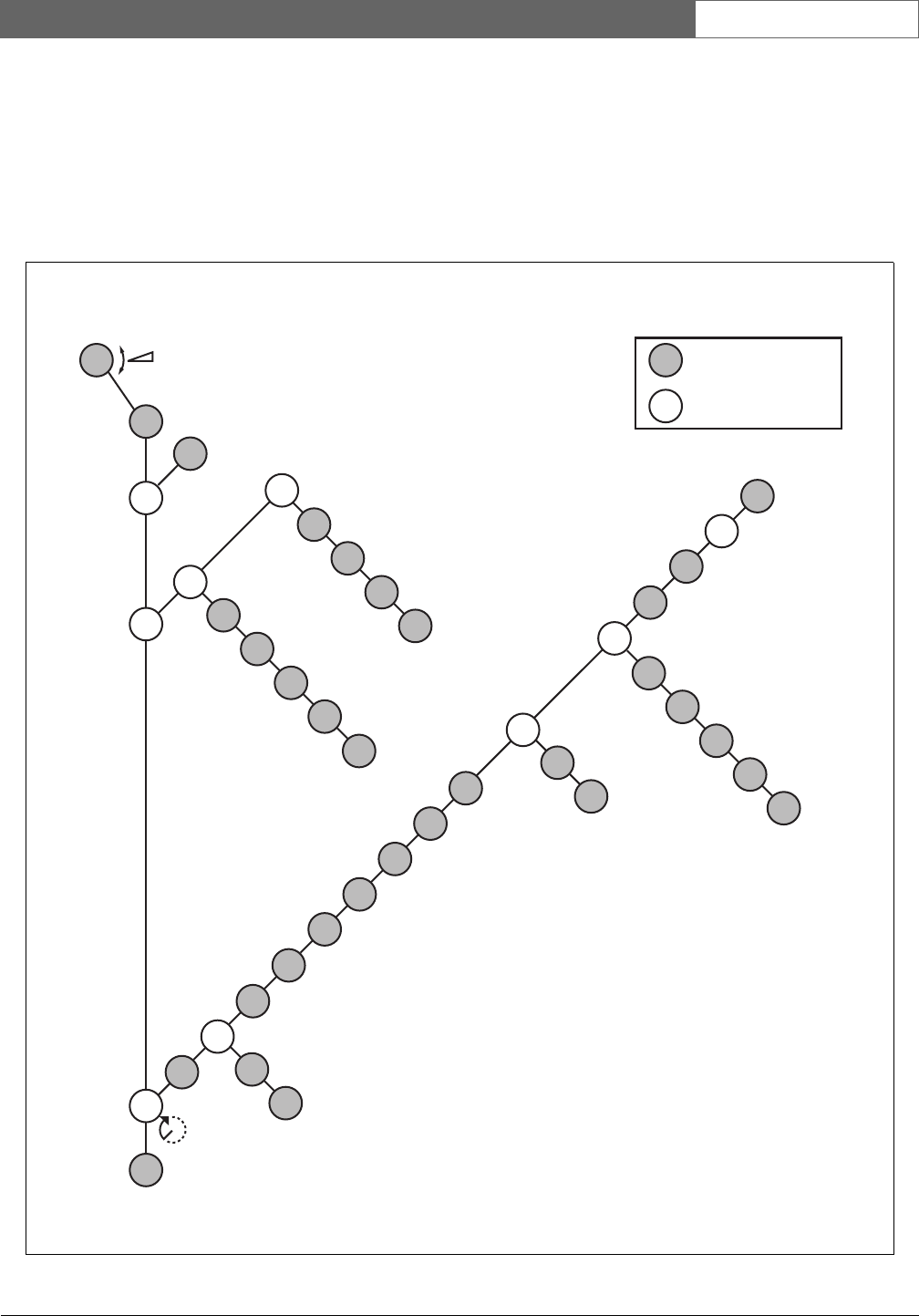
Bosch Security Systems | 2007-11 | 9922 141 70691 en
DCN Wireless | Installation and User Instructions | Central Devices en | 43
10.6 Configuration menu
10.6.1 Overview
Use the configuration menu of the central control unit to
configure the central control unit and the system (refer
to figure 10.12).
figure 10.12: Configuration menu
2Monitoring
2A Source/
Volume
4Ba Bass
4Bb Treble
3Aa Serial Number
3Ab HW Version
3Ac FPGA Version
3Ad SW Version
3Ae FW Version
3Ba Serial Number
3Bb HW Version
3Bc FPGA Version
3Bd SW Version
4Ka Auto mic off
4Kb System ID
4Kc Repetition
4Kd WAP
4Ke Lang. Distr.
3A CCU
3B WAP
3Enquiry
1
Menu item with sub-menu
Menu item
Fault status
Main
4Ja Assign Operator
4Jb Assign Chairman
4B
4A
4C
4D Level
Mic. Mode
Loudspkr
Wireless
Mode
4E Routing I/O2
4F Att. Tones
4G Mic. Priority
Request LED
4I
4H
Floor Distr.
4J
4K
4L De-init
Wireless
Intercom
4M Unit Name
4N Defaults
4O Del. Display
4
Setup
Back <
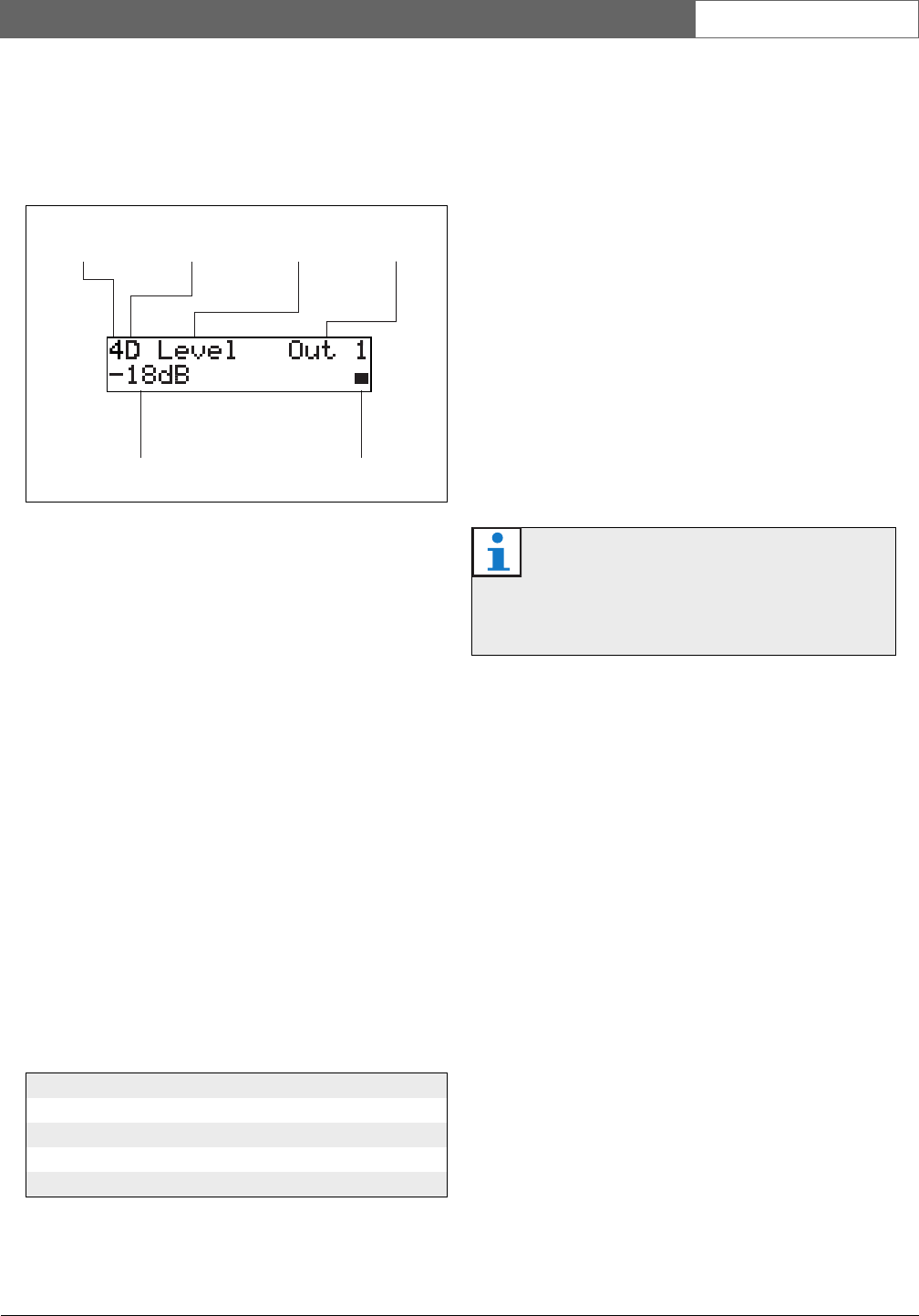
Bosch Security Systems | 2007-11 | 9922 141 70691 en
DCN Wireless | Installation and User Instructions | Central Devices en | 44
10.6.2 Navigation and operation
10.6.2.1 Menu items
The configuration menu consists of menu items. Refer
to figure 10.13 for the parts of a menu item.
10.6.2.2 Number and characters
Identify menu items by the main menu number
sub-menu character. The number identifies the main
menu to which the menu item is connected. The
characters identify the sub-menus to which the menu
item is connected.
10.6.2.3 Menu title
Each menu item has a title. The title gives a short
description of the function of the menu item.
10.6.2.4 Parameters and values
Most menu items have one or more parameters. To
make adjustments, change the values of the parameters.
10.6.2.5 VU meter
Some menu items have a VU meter. The VU meter
shows the volume levels of signals. The VU meter has
seven rows.
10.6.2.6 To open the main menu
To open the main menu, push the knob in the Main
menu item. The main menu number and the menu item
title flash.
10.6.2.7 To go through the main menu
• Turn the knob clockwise in the main menu to go to
the next menu item in the main menu.
• Turn the knob counterclockwise in the main menu to
go to the previous menu item in the main menu.
10.6.2.8 To open a sub-menu
When the display shows a menu item that has three dots
(...), the menu item gives access to a sub-menu. To open
the sub-menu, push the knob in a menu item that has
three dots. (The last sub-menu character and the menu
item title flash.)
10.6.2.9 To select menu items in a sub-menu
• Turn the knob clockwise in a sub-menu to go to the
next menu item in the sub-menu.
• Turn the knob counterclockwise in a sub-menu to go
to the previous menu item in the sub-menu.
10.6.2.10 To open a menu item
1 Turn the knob to select the applicable menu item.
2 When the display shows the correct menu item, push
the knob to open the menu item. The display shows
a cursor.
figure 10.13: Menu item parts
table 10.20: VU meter
VU meter Description
One row on No signal
Seven rows on Maximum signal
Triangle Clipped signal
Minus Muted by control input
Main menu
number Sub-menu
character
Parameter
Value VU meter
Menu item
title
Note
To open the Setup sub-menu, you must
push and hold the knob for more than 3
seconds.
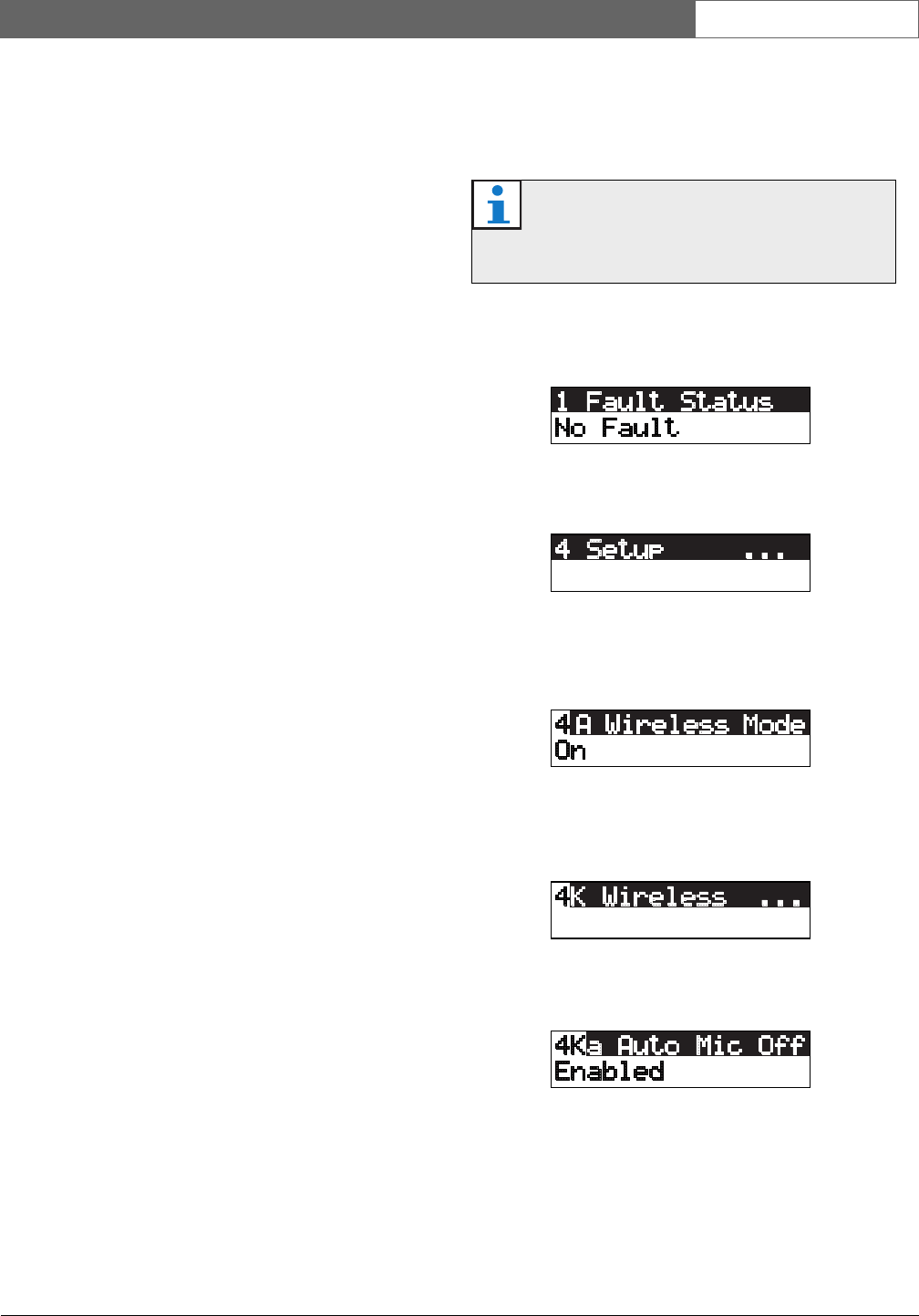
Bosch Security Systems | 2007-11 | 9922 141 70691 en
DCN Wireless | Installation and User Instructions | Central Devices en | 45
10.6.2.11 To select a parameter
1 Open the correct menu item (refer to 10.6.2.10).
2 Turn the knob to move the cursor to the parameter
that is shown.
3 On the parameter, push the knob. The parameter
flashes.
4 Turn the knob to go to the applicable parameter.
5 When the display shows the applicable parameter,
push the knob to select the parameter. The display
shows a cursor.
10.6.2.12 To change the value of a parameter
1 Select the applicable parameter (refer to 10.6.2.11).
2 Turn the knob to move the cursor to the value.
3 Push the knob. The value flashes.
4 Turn the knob to go to the value.
5 When the display shows the correct value, push the
knob to select the value. The display shows a cursor.
10.6.2.13 To close a menu item
1 Turn the cursor to the last character that identifies
the menu item.
2 Push the knob to close the menu item. The last
character and the menu item title flash.
10.6.2.14 To close a sub-menu
1 Turn the cursor to go to the second last character
that identifies the menu item.
2 Push the knob to close the sub-menu. The last
character and the menu item title flash.
10.6.2.15 To close the main menu
1 From the main menu, turn the primary knob
clockwise to go to the < Back menu item.
2From the < Back menu item, push the knob to go to
the Main menu item.
10.6.2.16 Example
For an example, do as follows to select the carrier of the
wireless access point:
1 Push the knob to open the Main menu.
2 Turn the knob clockwise until 4 Setup ... is reached.
3 Push-and-hold the knob for 3 seconds to open the
sub-menu.
4 Turn the knob clockwise until 4K Wireless is
reached.
5 Push the knob to open the sub-menu..
Note
Make sure that when you do this example, you
start from the Main menu item.
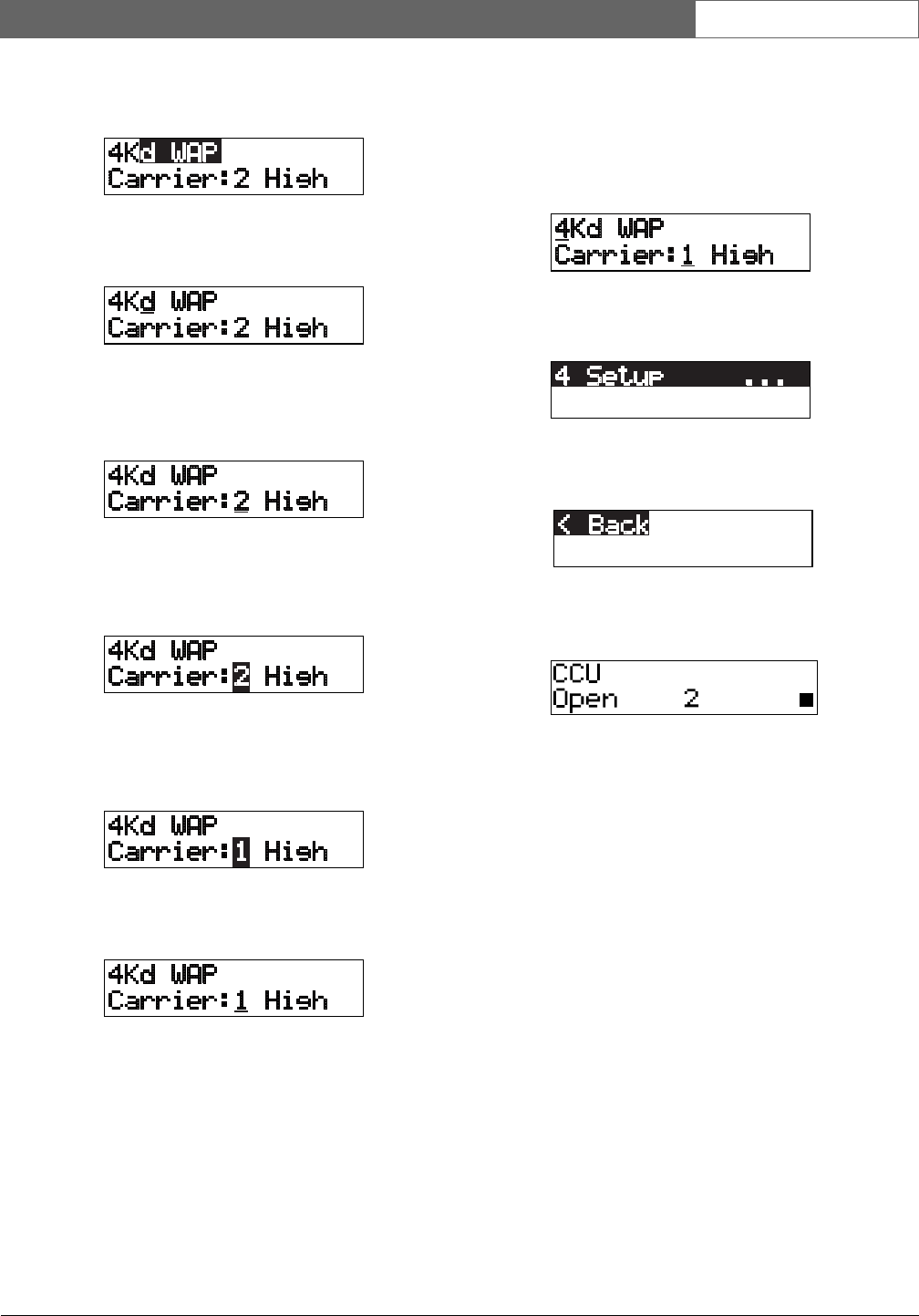
Bosch Security Systems | 2007-11 | 9922 141 70691 en
DCN Wireless | Installation and User Instructions | Central Devices en | 46
6 Turn the knob clockwise until 4Kd WAP is reached.
7 Push the knob to open the menu item.
8 Turn the knob to move the cursor to the currently
selected carrier, for example Carrier: 2.
9 Push the knob to select the carrier. The carrier
number will start to flash.
10 Turn the knob to change the carrier, for example
Carrier: 1.
11 Push the knob to select the carrier.
To return to the main menu:
1 Turn the knob to move the cursor to the main menu
number, for example 4.
2 Push the knob to go back to the Main menu.
3 Turn the knob clockwise until < Back is reached.
4 Push the knob to go back to the main screen.
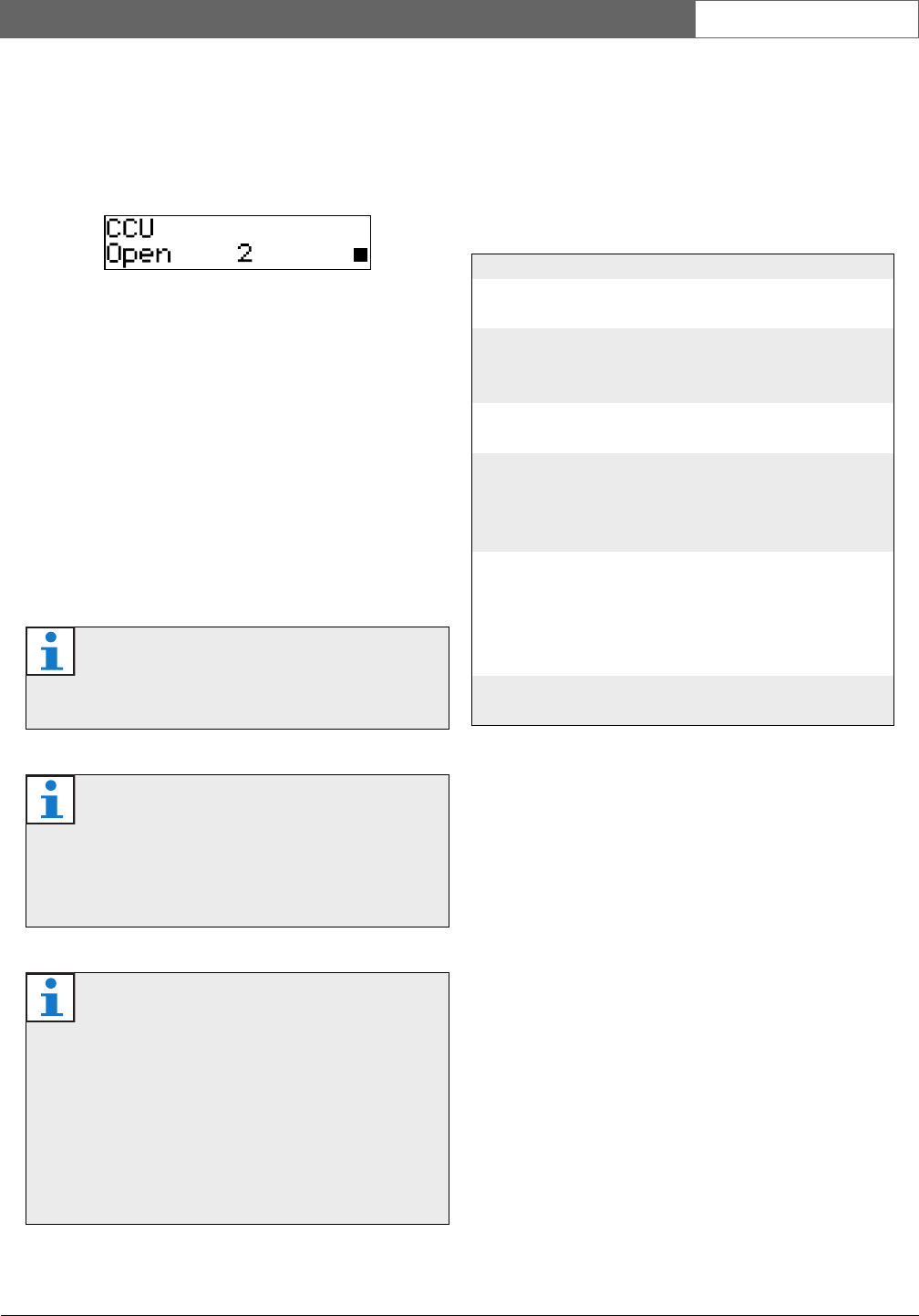
Bosch Security Systems | 2007-11 | 9922 141 70691 en
DCN Wireless | Installation and User Instructions | Central Devices en | 47
10.6.3 Main
When you start the central control unit, the display first
shows Starting. The display then shows the Main menu
item:
The Main menu item contains:
• An indicator that shows the volume level of the
loudspeakers of the contribution devices. Turn the
knob to change the volume level (refer to 12.6).
• The name of the central control unit. The default
name is CCU. You can change the name with the
4M Unit Name menu item (refer to 10.6.8).
• The microphone mode and the maximum number
of activated microphones. You can change the
microphone mode and the maximum number of
activated microphones with the 4C Mic. Mode menu
item (refer to 10.6.8).
10.6.4 Fault status
Use the 1 Fault Status menu item to see the condition
messages of the central control unit. If there is more
than one message, the display shows the most important
message (refer to table 10.21).
Note
When a PC is connected to the central control
unit, the Main menu item also shows PC.
Note
When the condition of the central control unit
changes, the Main menu item shows a message
(refer to table 10.21). Such a message goes out
of view when you push the knob.
Note
If you do not turn or push the knob for three
minutes, the display automatically goes back to
the Main menu item. The display does not
automatically go back to the Main menu item
from these menu items and their sub-menus:
•2ASource/Volume
• 4Ja Assign Operator
• 4Jb Assign Chairman
table 10.21: Messages (low to high importance)
Messages Description
No Fault The central control unit
operates correctly.
Low Battery The battery pack of a
wireless device is
empty within 1 hour.
Bad Signal A wireless device has a
bad signal reception.
Incompatible SW The wireless access
point has a
incompatible software
version.
Invalid Software The central control unit
cannot start. The
central control unit
does not contain the
correct software.
Downloading The central control unit
downloads software.
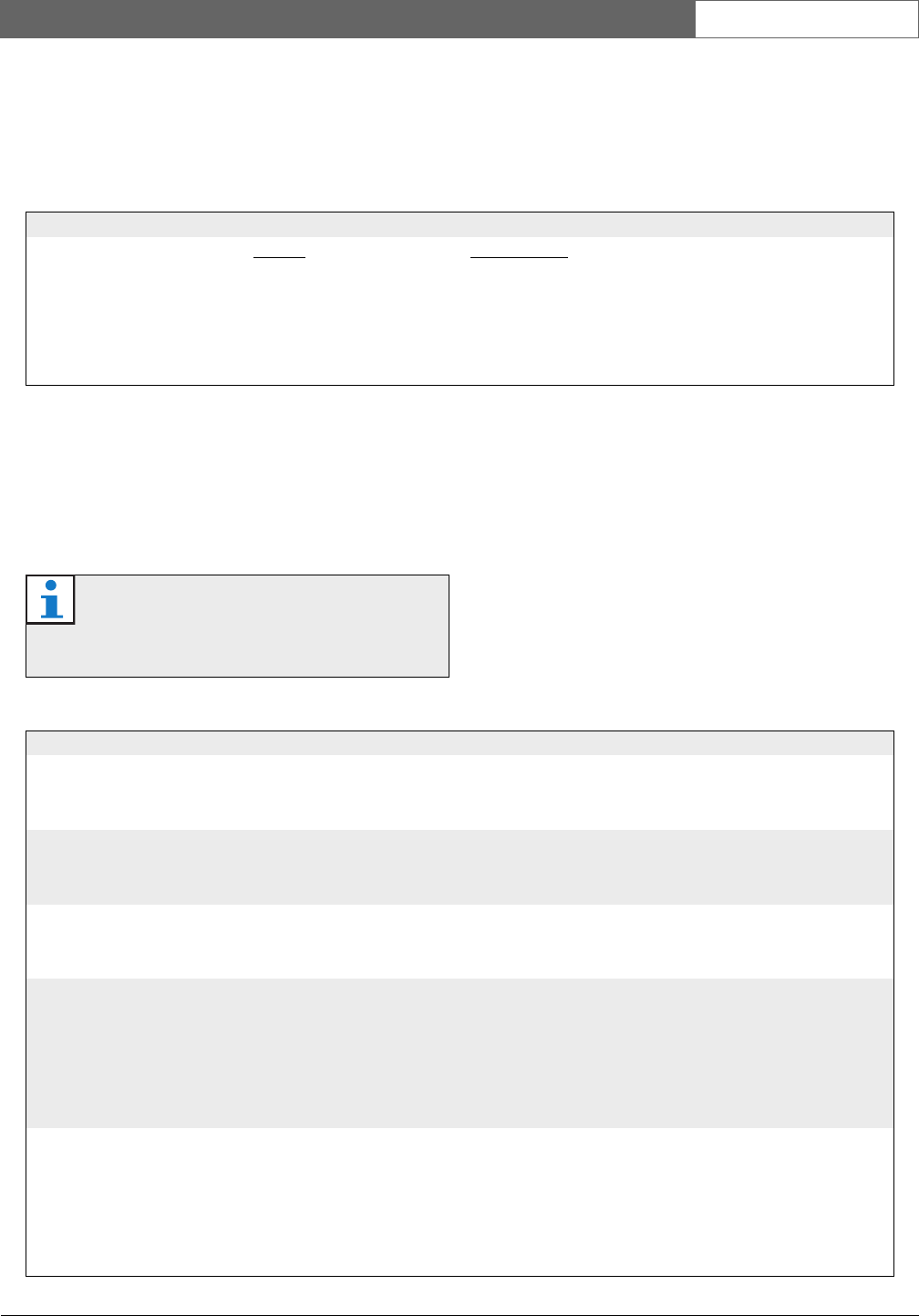
Bosch Security Systems | 2007-11 | 9922 141 70691 en
DCN Wireless | Installation and User Instructions | Central Devices en | 48
10.6.5 Monitoring
Use the 2 Monitoring menu item to open the Monitoring
sub-menu (refer to table 10.22).
10.6.6 DCN-WCCU Enquiry
Use the 3A CCU menu item to open the CCU
sub-menu. The menu items in this sub-menu give
general data about the central control unit (refer to table
10.23).
table 10.22: Monitoring sub-menu (* = default)
Menu item Parameter Value Description
2A Source/Volume Signal:
Floor
Input 1
Input 2
Output 1
Output 2
Volume level:
-31 to 0 dB (16 dB*)
-31 to 0 dB (16 dB*)
-31 to 0 dB (16 dB*)
-31 to 0 dB (16 dB*)
-31 to 0 dB (16 dB*)
The signal that is available
on the headphones
socket of the central
control unit and its volume
level.
Note
This data must be mentioned in all service
requests and failure reports.
table 10.23: DCN-WCCU Enquiry sub-menu (* = default)
Menu item Parameter Value (read-only) Description
3Aa Serial Nr --- e.g. 20.0.00362 The hexadecimal serial
number of the central
control unit.
3Ab HW Version --- e.g. 3.0 The version number of the
hardware of the central
control unit.
3Ac FPGA Version --- e.g. 1.06 The version number of the
FPGA firmware of the
central control unit.
3Ad SW Version --- MM.mm.bbbb
e.g. 2.20.1234
The version number of the
software of the central
control unit.
• MM: Major release no.
• mm: Minor release no.
• bbbb: build no.
3Ae FW Version --- MM.mm.bbbb
e.g. 4.00.1234
The version number of the
firmware of the central
control unit.
• MM: Major release no.
• mm: Minor release no.
• bbbb: build no.
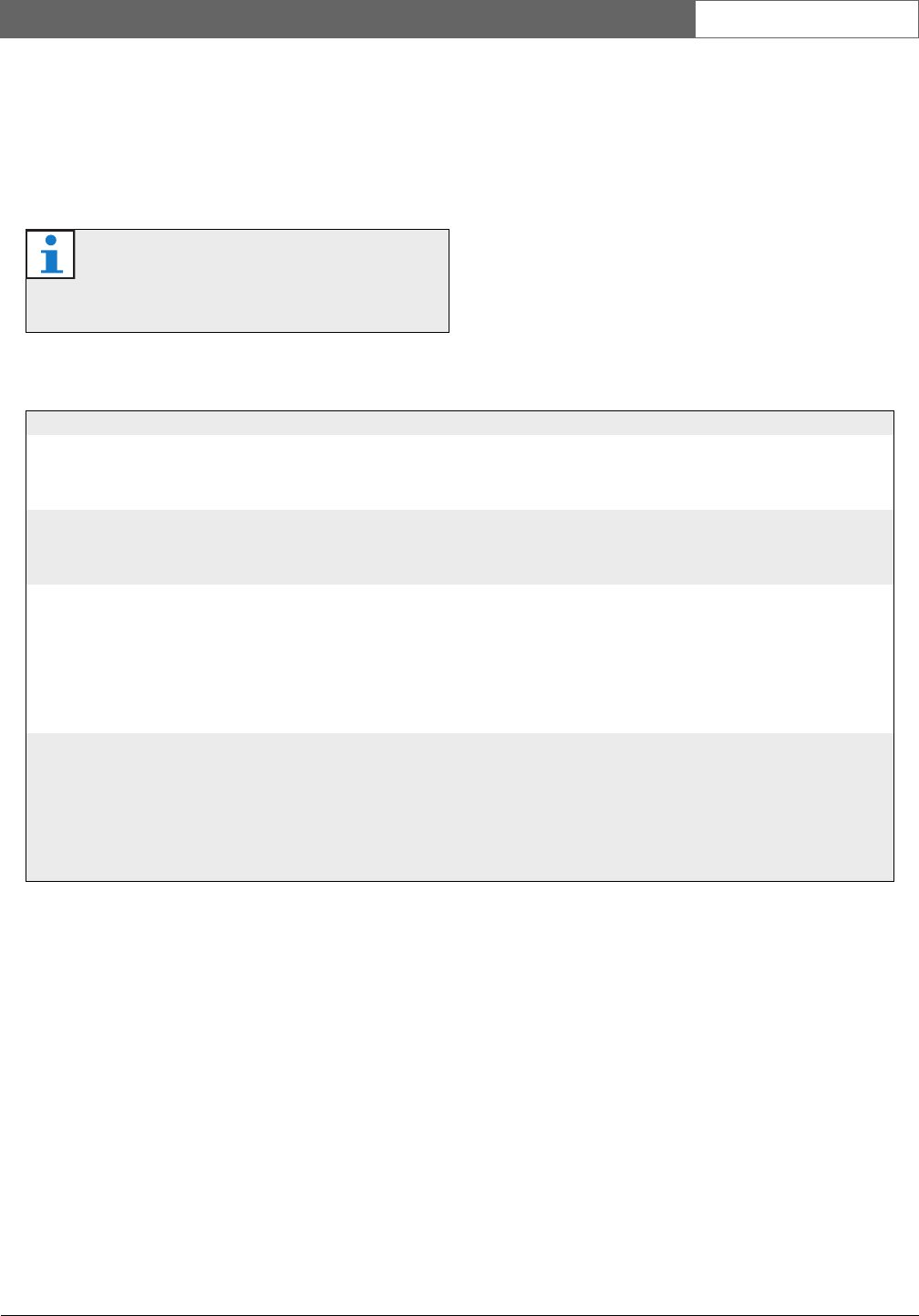
Bosch Security Systems | 2007-11 | 9922 141 70691 en
DCN Wireless | Installation and User Instructions | Central Devices en | 49
10.6.7 DCN-WAP Enquiry
Use the 3B WAP menu item to open the WAP
sub-menu. The menu items in this sub-menu give
general data about the wireless access point (refer to
table 10.23).
Note
This data must be mentioned in all service
requests and failure reports.
table 10.24: DCN-WAP Enquiry sub-menu (* = default)
Menu item Parameter Value (read-only) Description
3BA Serial Nr --- e.g. 1E.0.00001 The hexadecimal serial
number of the wireless
access point.
3Bb HW Version --- e.g. 01.00 The version number of the
hardware of the wireless
access point.
3Bc FPGA Version --- MM.mm.bbbb
e.g. 01.00
The version number of the
FPGA firmware of the
wireless access point.
• MM: Major release no.
• mm: Minor release no.
• bbbb: build no.
3Bd SW Version --- MM.mm.bbbb
e.g. 2.20.0055
The version number of the
software of the wireless
access point.
• MM: Major release no.
• mm: Minor release no.
• bbbb: build no.
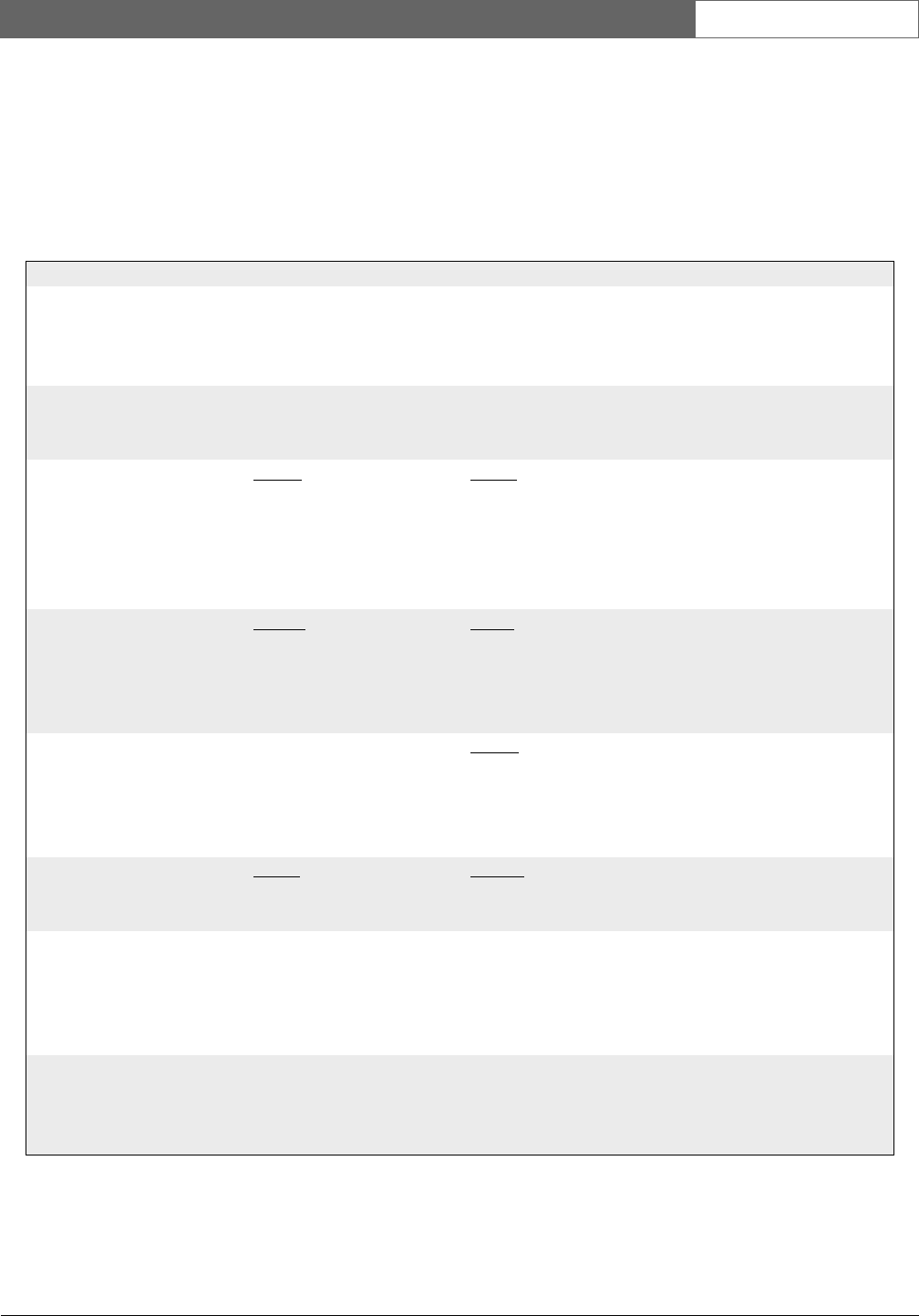
Bosch Security Systems | 2007-11 | 9922 141 70691 en
DCN Wireless | Installation and User Instructions | Central Devices en | 50
10.6.8 Setup
Use the 4 Setup menu item to open the Setup
sub-menu. You can use the menu items in this
sub-menu to configure the central control unit and the
system (refer to table 10.25 and table 10.26).
table 10.25: Setup sub-menu (* = default)
Menu item Parameter Value Description
4A Wireless Mode --- On*
Sleep
Off
Subscription
Sets the mode of the
wireless network (refer to
12.3).
4B Loudspkr --- --- Gives access to the
Loudspkr sub-menu (refer
to 10.6.9).
4C Mic. Mode Mode:
Open*
Override
PTT
NOM:
1, 2*, 3
1, 2*, 3
1, 2*, 3
The microphone mode of
the DCN and the
maximum number of
activated delegate
microphones (refer to
12.4).
4D Level Signal:
Input 1
Input 2
Output 1
Output 2
Level:
-6 to 6 dB (0 dB*)
-6 to 6 dB (0 dB*)
-24 to 6 dB (0 dB*)
-24 to 6 dB (0 dB*)
The nominal levels of the
audio inputs and the audio
outputs of the central
control unit.
4E Routing I/O 2 --- Mode:
Recorder*
Equalized PA
Mix-minus
Insertion
The audio routing mode of
the central control unit
(refer to 12.6).
4F Att. Tones Event:
Priority
Voting
Chime:
Off, 1*, 2, 3
Off*, 1, 2, 3
The attention chimes of
the system (refer to 12.7).
4G Mic. Priority --- Temporarily off*
Permanently off
The action taken by the
system when the
chairman releases the
priority button (refer to
12.8).
4H Request LED LED setting Flashing*, Continuous Sets the behaviour of the
request LED for the first
delegate in the request
list.
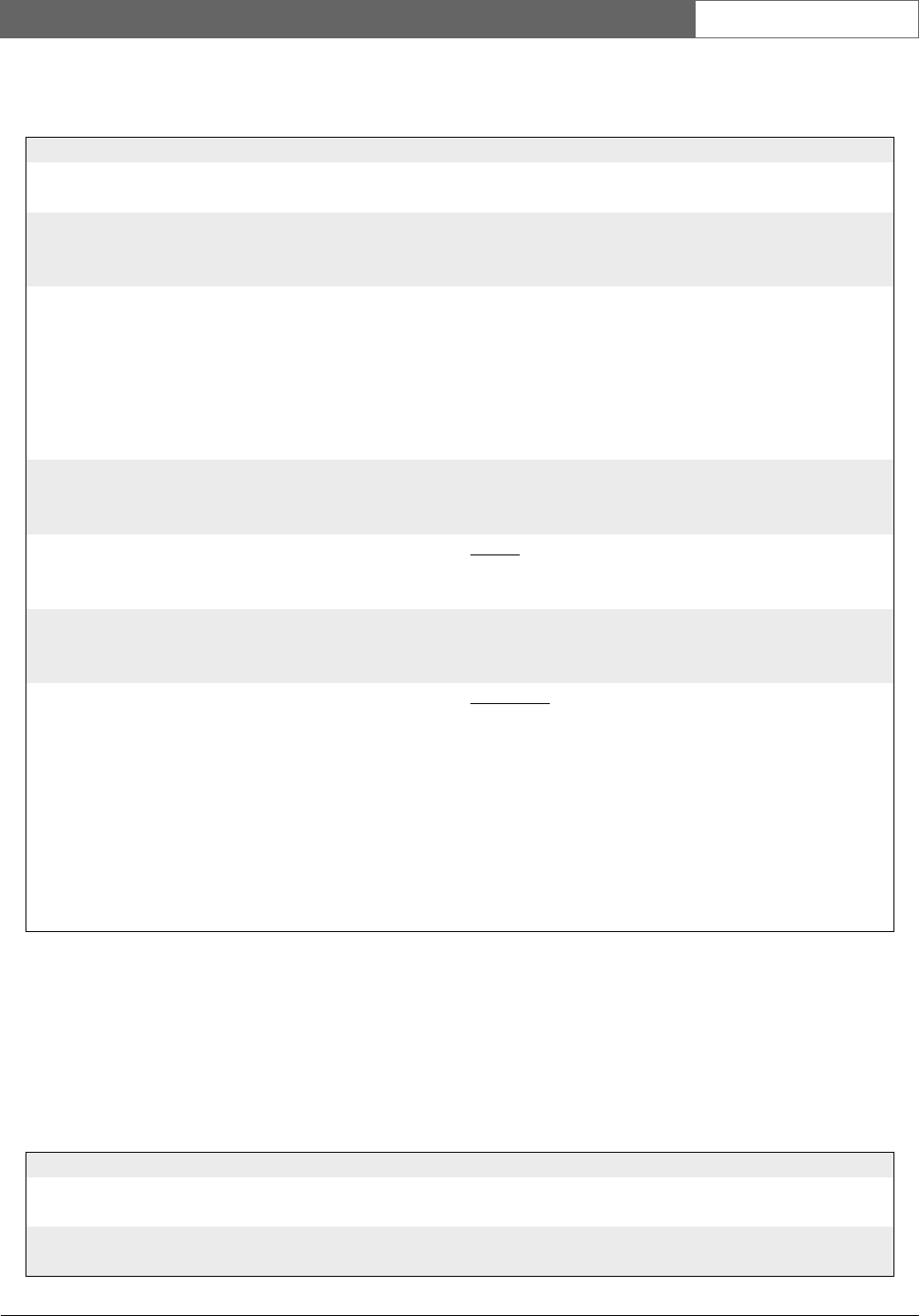
Bosch Security Systems | 2007-11 | 9922 141 70691 en
DCN Wireless | Installation and User Instructions | Central Devices en | 51
10.6.9 Loudspkr
Use the menu items in the 4B Loudspkr sub-menu to set
the levels of the bass and treble output to the
loudspeakers of the contribution devices (refer to table
10.27).
table 10.26: Setup sub-menu (* = default)
Menu item Parameter Value Description
4I Floor Distr. --- On*, Off Enables or disables floor
distribution (refer to 12.9).
4J Intercom ... --- --- Gives access to the
Intercom sub-menu (refer
to 10.6.10).
4K Wireless --- --- Gives access to the
Wireless sub-menu (refer
to 10.6.11). When the
wireless access point is
not connected, the central
control unit shows Not
Available.
4L De-Init ... --- --- Gives access to the
De-initialization menu item
(refer to 10.6.12).
4M Unit Name --- Name:
CCU*
Custom name
The name of the central
control unit (max. 16
characters).
4N Defaults ... --- --- Gives access to the Reset
menu item (refer to
10.6.13)
4O Del. Display --- Language:
English*
German
French
Italian
Dutch
Spanish
The language that is used
by the displays of the
contribution devices.
Other languages (e.g.
Chinese) can be
downloaded to the CCU,
but will overwrite the
default languages. The
English language cannot
be overwritten.
table 10.27: Loudspkr sub-menu (* = default)
Menu item Parameter Value Description
4Ba Bass --- -12 to 12 dB (0 dB*) The level of the bass
output.
4Bb Treble --- -12 to 12 dB (0 dB*) The level of the treble
output.
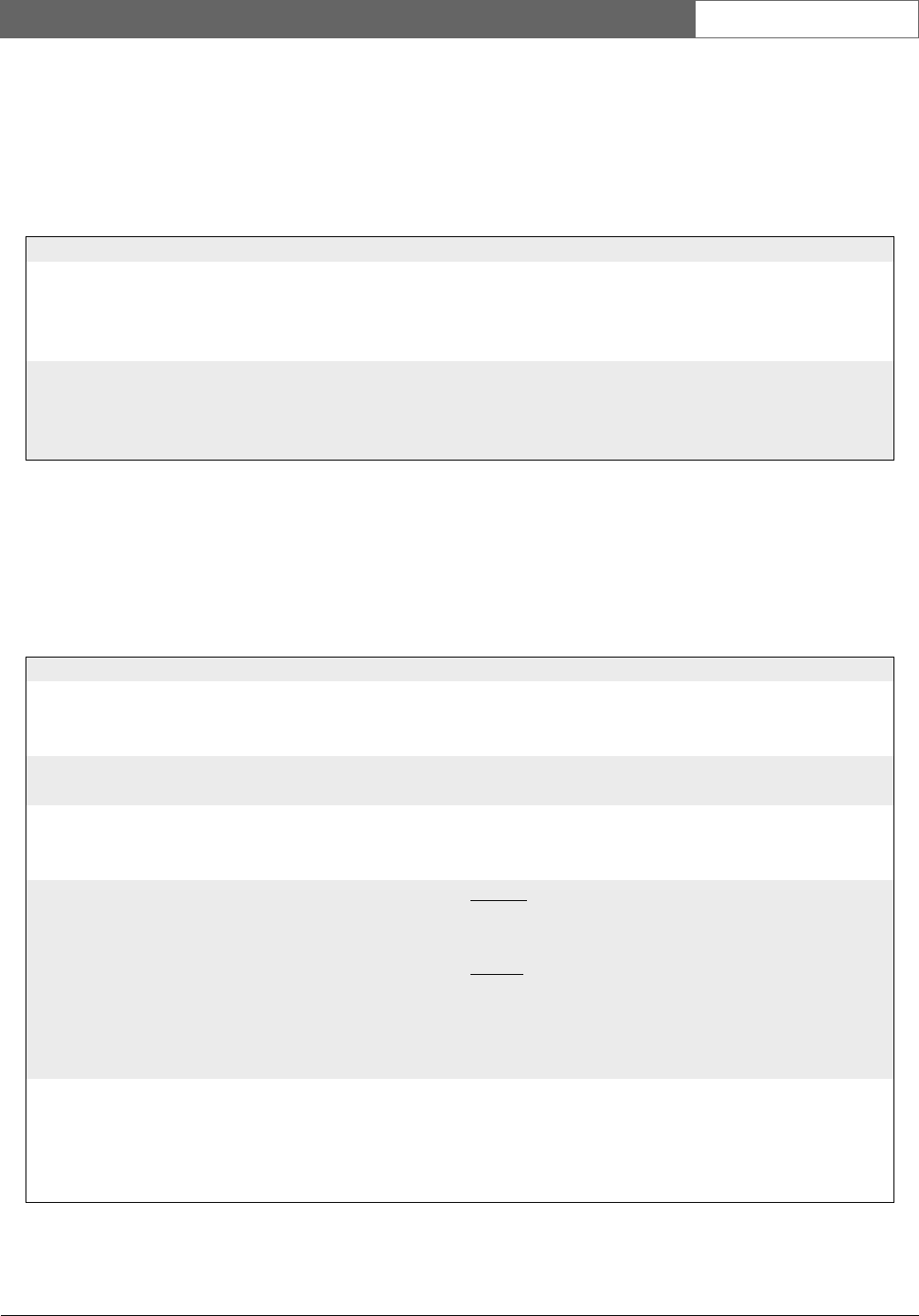
Bosch Security Systems | 2007-11 | 9922 141 70691 en
DCN Wireless | Installation and User Instructions | Central Devices en | 52
10.6.10 Intercom
Use the menu items in the 4J Intercom sub-menu to
identify the location of the chairman and the operator
(refer to table 10.28 and 12.10).
10.6.11 Wireless
Use the menu items in the 4K Wireless sub-menu to
configure the wireless network of the system (refer to
table 10.29).
table 10.28: Intercom sub-menu (* = default)
Menu item Parameter Value Description
4Ja Assign Operator No*
Yes
Does not identify the
location of the operator.
Identifies the location of
the operator.
4Jb Assign Chairman No*
Yes
Does not identify the
location of the chairman.
Identifies the location of
the chairman.
table 10.29: Wireless sub-menu (* = default)
Menu item Parameter Value Description
4Ka Auto mic off --- Enabled*, Disabled Enables or disables the
auto microphone off
function (refer to 12.4.5).
4Kb System ID --- 0* to 15 Sets the identifier of the
system (refer to 11.6.2).
4Kc Repetition --- 0* to 2 Sets the number of
repetitions of audio
packets (refer to 12.5).
4Kd WAP --- Carrier:
0* to 2
Power:
High*
Medium
Low
Off
Sets the carrier of the
wireless access point
(refer to 11.6.3).
Sets the power of the
wireless access point
(refer to 11.6.4).
4Ke Lang. Distr. Language distribution Enabled, Disabled* Enables or disables
language distribution in
the wireless network.
Refer to limits 4 and 5 in
chapter 1.2

Bosch Security Systems | 2007-11 | 9922 141 70691 en
DCN Wireless | Installation and User Instructions | Central Devices en | 53
10.6.12 De-init
Use the 4L De-initialize menu item in the 4L De-Init
sub-menu to erase the addresses of the contribution
devices and the interpretation devices (refer to table
10.30 and 12.2).
10.6.13 Defaults
Use the 4N Defaults sub-menu to set all parameters to
the default values in the configuration menu (refer to
table 10.31). This includes the values of the parameters
of the interpreter desks. These parameters are not
changed:
• The subscription list of wireless devices
• The name of the central control unit
10.6.14 Delegate Display
Use the 4O menu to select a language that is used on the
display of a wired contribution device (refer to table
10.32).
table 10.30: De-init sub-menu (* = default)
Menu item Parameter Value Description
4L De-init De-initialize None*
Wired
Wireless
Does not erase the
addresses.
Erases the addresses of
the wired devices in the
DCN.
Erases the subscription
list of the devices in the
wireless network.
table 10.31: Defaults sub-menu (* = default)
Menu item Parameter Value Description
4N Defaults Reset to defaults? No*
Yes
Does not put back the
default values.
Sets all parameters to the
default values.
table 10.32: Delegate display sub-menu
4O Del. Display --- Language:
English*
German
French
Italian
Dutch
Spanish
The language that is used by the displays of
the contribution devices. Other languages
(e.g. Chinese) can be downloaded to the
CCU, but will overwrite the default
languages. The English language cannot be
overwritten.
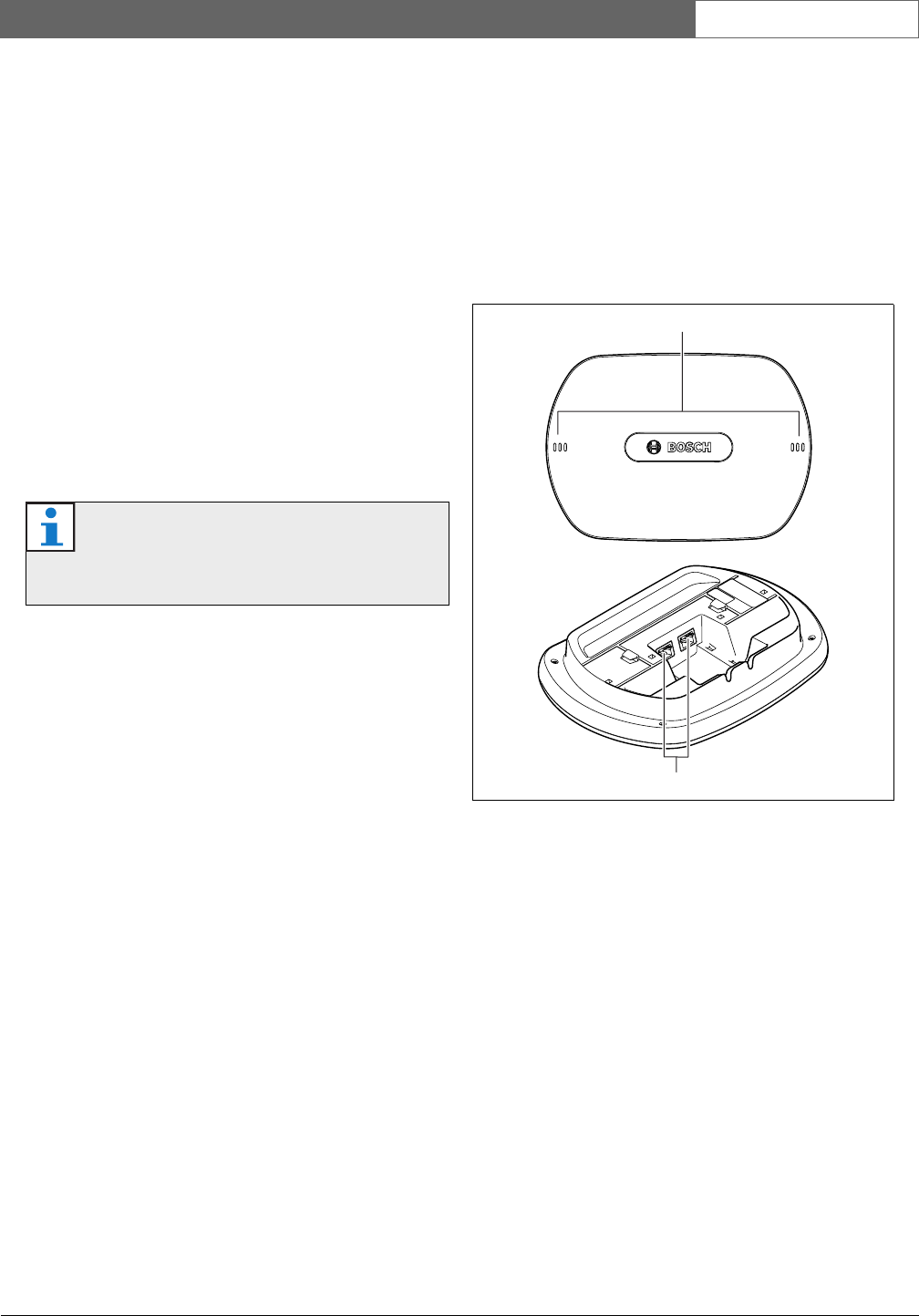
Bosch Security Systems | 2007-11 | 9922 141 70691 en
DCN Wireless | Installation and User Instructions | Central Devices en | 54
11 DCN-WAP Wireless
Access Point
11.1 Introduction
The wireless access point:
• Sends signals from the central control unit to the
wireless devices.
• Receives signals from the wireless devices and sends
them to the central control unit.
11.2 Firmware
The version numbers of the software of the wireless
access point (refer to 10.6.7) and the central control unit
(refer to 10.6.6) must be the same.
11.3 Controls, connectors and
indicators
The wireless access point contains:
1Status LEDs - Give information about the
condition of the wireless network and the wireless
access point (refer to 11.7).
2Optical network sockets - Connect the wireless
access point to the optical network (refer to 11.5.1).
Note
Use the Download and License Tool to send
new software to the wireless access point.
figure 11.1: Top and bottom views
1
2
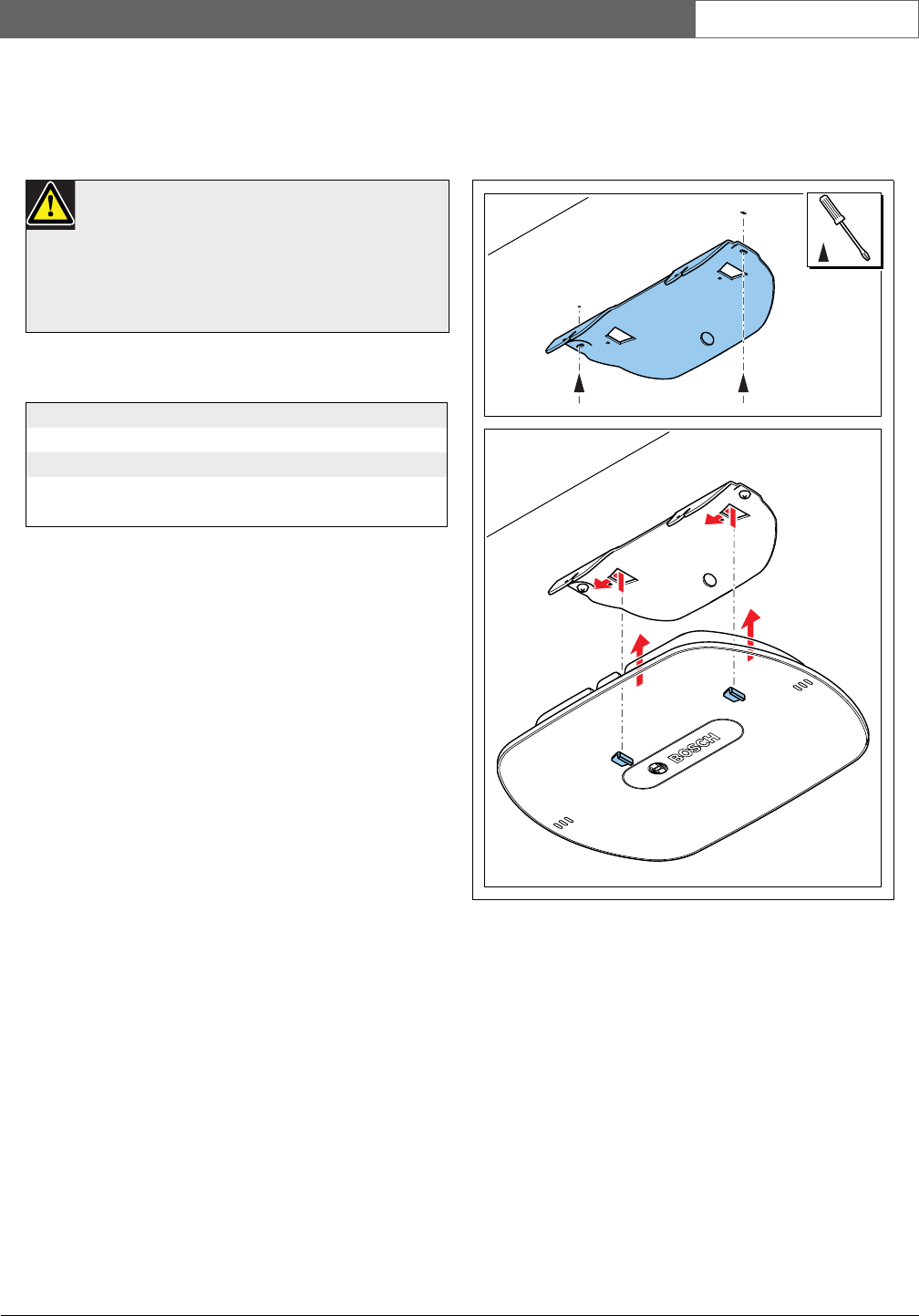
Bosch Security Systems | 2007-11 | 9922 141 70691 en
DCN Wireless | Installation and User Instructions | Central Devices en | 55
11.4 Inst allat ion
11.4.1 G eneral
11.4.2 Wall or ceiling
You can use the bracket to attach the wireless access
point to a wall or ceiling. Refer to figure 11.2.
Caution
Do not open the wireless access point. Any
hardware change makes the product certificates
invalid. Only qualified personnel can open the
wireless access point.
table 11.1: Physical characteristics
Dimensions (h x w x d):
284.5 x 201.5 x 59 mm
Weight:
• DCN-WAP: 643 g (without bracket)
• Bracket: 264 g
figure 11.2: Installation, wall and ceiling
02
01
TORX 10
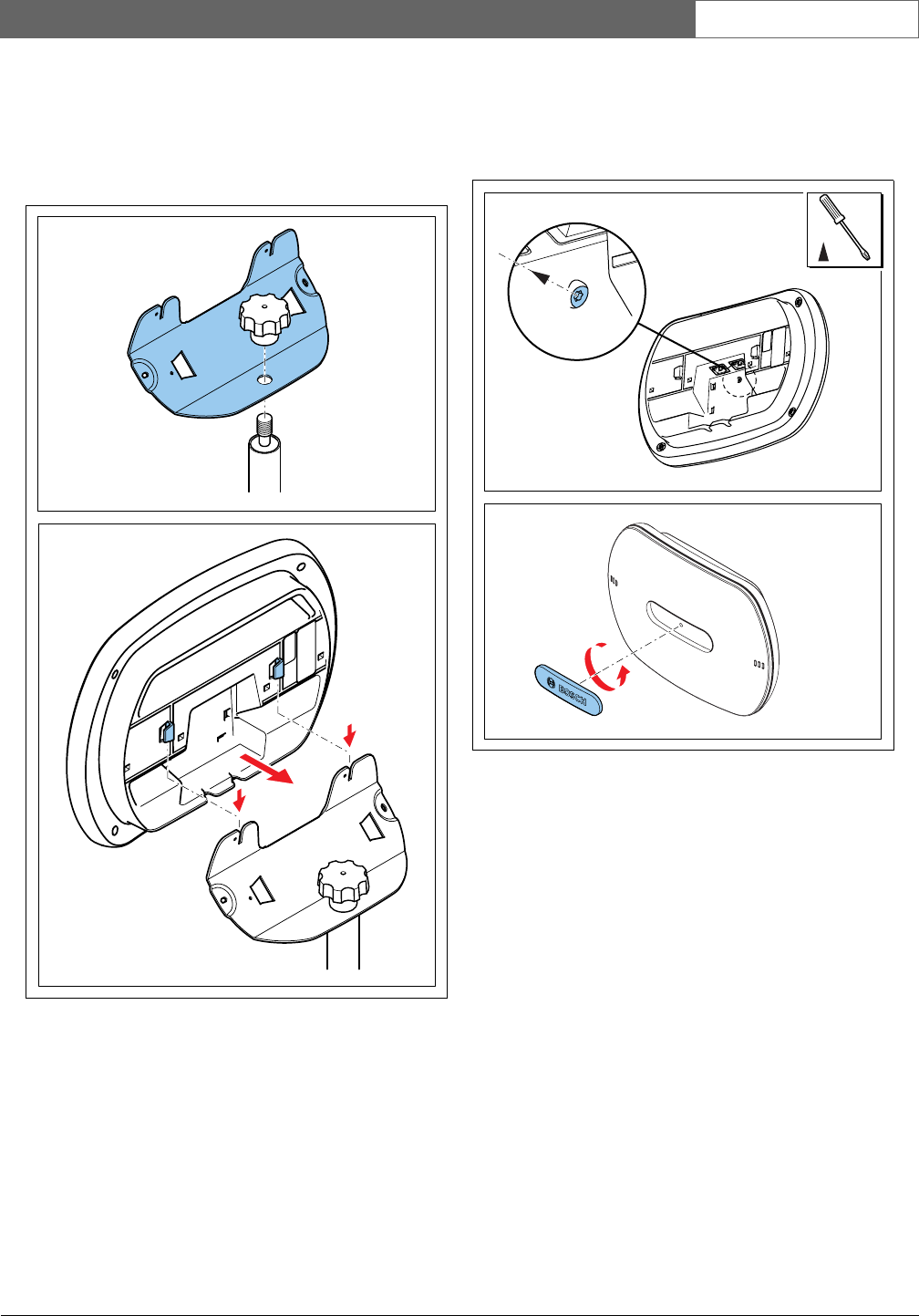
Bosch Security Systems | 2007-11 | 9922 141 70691 en
DCN Wireless | Installation and User Instructions | Central Devices en | 56
11.4.3 Tripod
You can use the bracket to install the wireless access
point on an LBC1259/00 Universal Floor-stand. Refer
to figure 11.3.
11.4.4 Logo
You can change the orientation of the logo. Refer to
figure 11.4:
figure 11.3: Installation, LBC1259/00
02
01
figure 11.4: Installation, logo
02
01
TORX 10
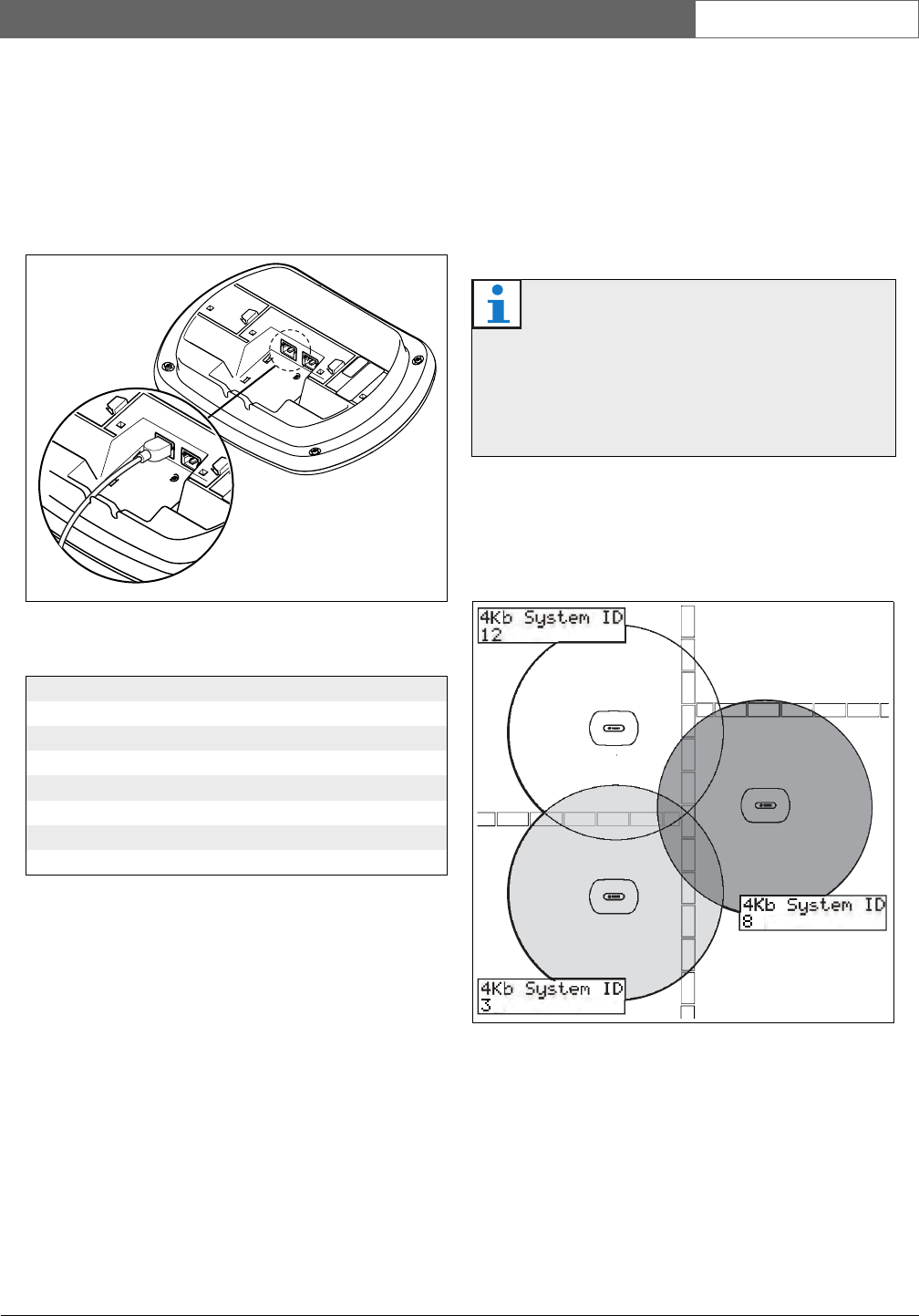
Bosch Security Systems | 2007-11 | 9922 141 70691 en
DCN Wireless | Installation and User Instructions | Central Devices en | 57
11.5 External connections
11.5.1 Optical network
Connect the optical network sockets of the wireless
access point to the optical network with optical network
cables (refer to figure 11.5).
11.6 Configuration
11.6.1 Introduction
Use the configuration menu of the central control unit to
configure the wireless access point.
11.6.2 System ID
Set the system identity with the 4Kb System ID menu
item. Adjacent systems must have different system
identities (refer to figure 11.6) and different carriers
(refer to figure 11.7)
figure 11.5: Optical network
table 11.2: Optical network connections
Number of connections:
2x proprietary sockets
Location:
Bottom side
Nodes:
1
Power consumption
4 W
Note
Set the correct system identity before you do
the installation of the system (refer to section
12.2.2). When you change the system identity
after you did the initialization, you must do the
initialization again.
figure 11.6: System IDs for adjacent systems
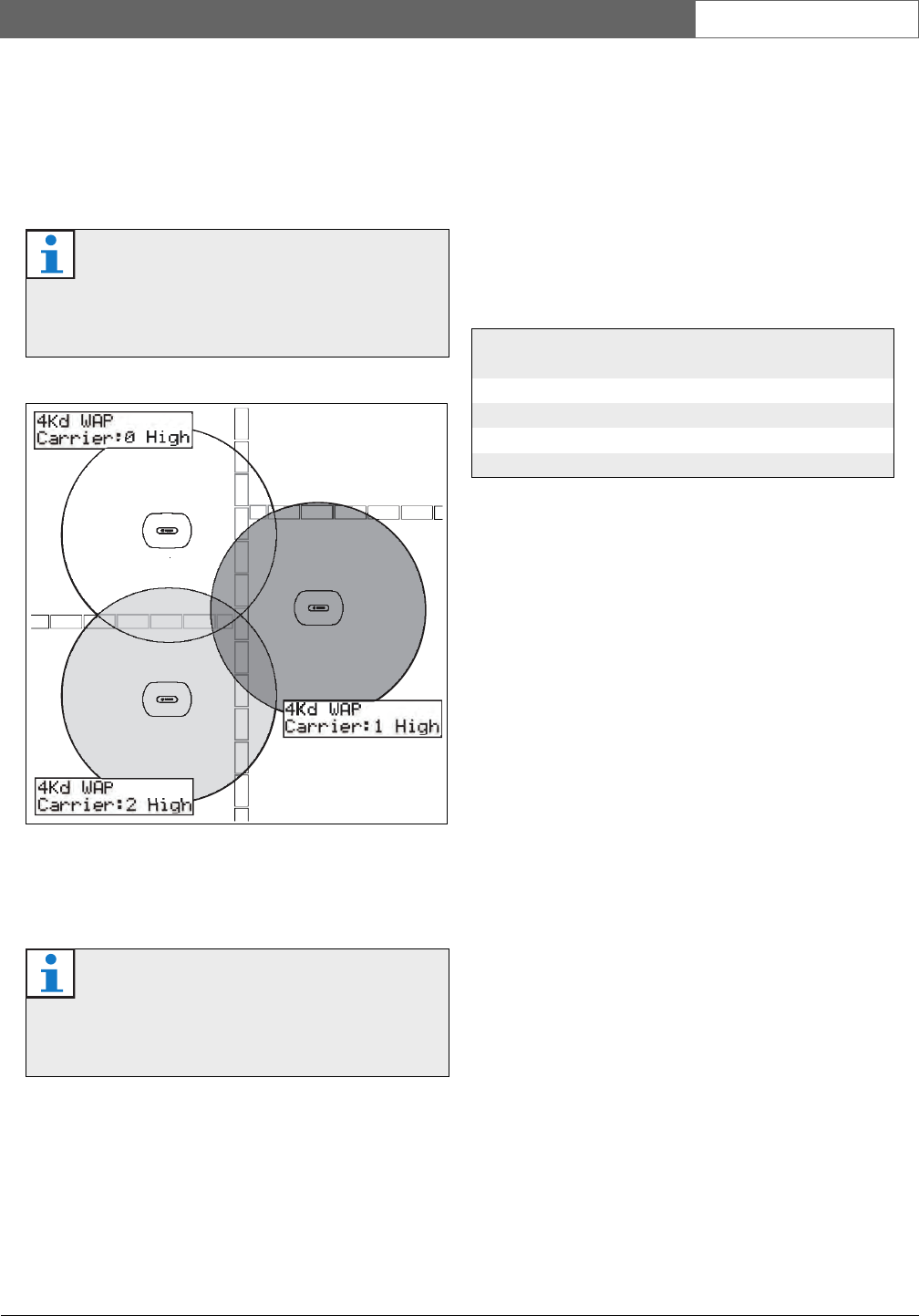
Bosch Security Systems | 2007-11 | 9922 141 70691 en
DCN Wireless | Installation and User Instructions | Central Devices en | 58
11.6.3 Carrier
Set the carrier of the wireless access point with the
4Kd WAP menu item. Adjacent systems must have
different carriers (refer to figure 11.7) and different
system identities (refer to figure 11.6).
You can change the carrier after you did the
initialization of the system (refer to 12.2.2).
11.6.4 Power value
The wireless access point has a typical maximum
coverage area of 30 m by 30 m. To determine the exact
coverage area the coverage test kit can be used. The
maximum coverage area of the wireless access point is
dependent upon its power (refer to table 11.3). Set the
power of the wireless access point with the 4Kd WAP
menu item.
You can change the power value after you did the
initialization of the system (refer to 12.2.2). When you
decrease the power value, some wireless devices can
show that they cannot find the wireless network (refer to
14.8.6).
Note
If adjacent systems are using the same carrier,
they must be separated by a minimum distance
of 500 m.
figure 11.7: Carriers for adjacent systems
Note
When you change the carrier during a
discussion or conference, you can cause a short
audio disruption.
table 11.3: Power values
Value Typical Coverage
Area (m)
High 30 x 30
Medium 20 x 20
Low 10 x 10
Off 0
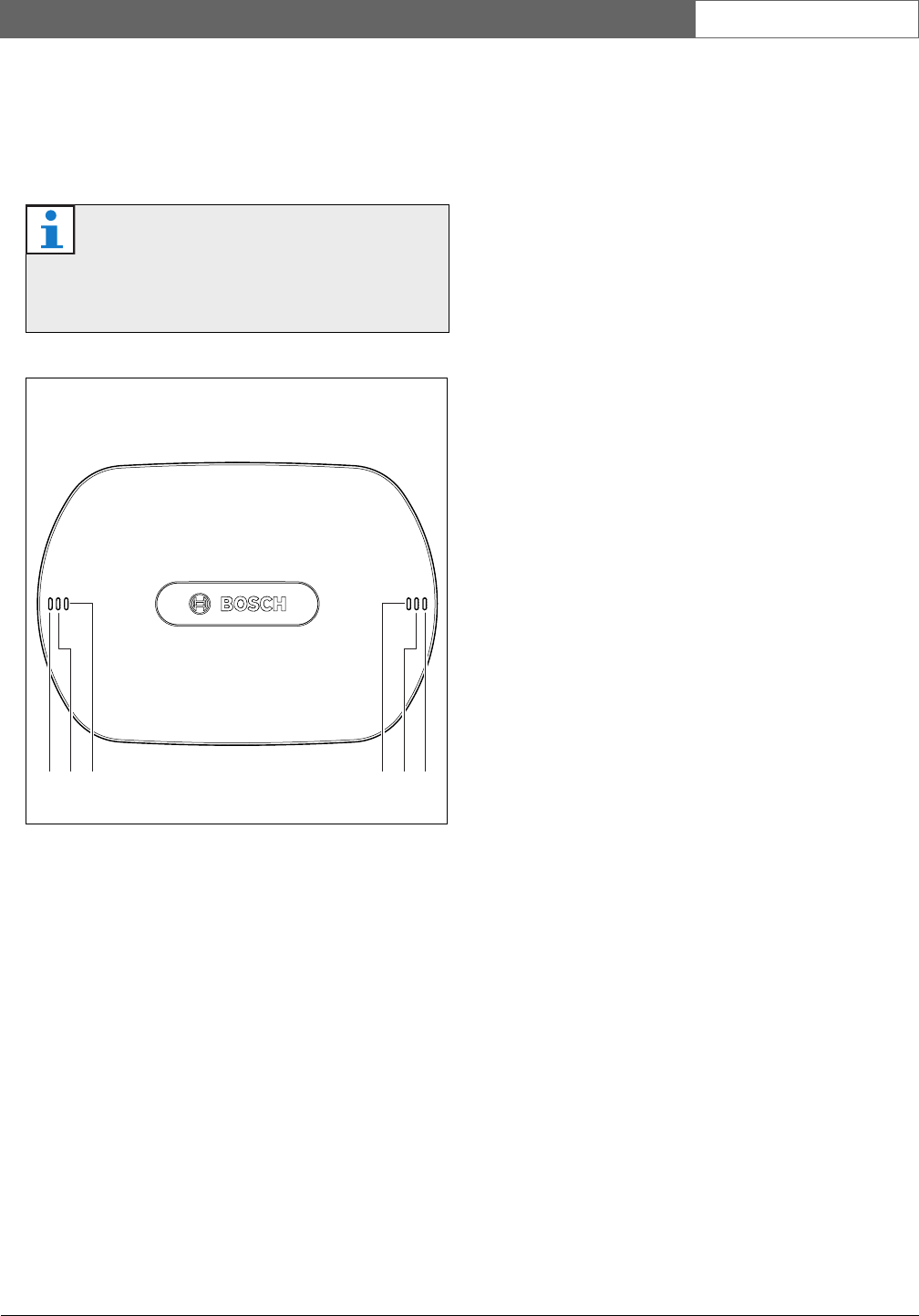
Bosch Security Systems | 2007-11 | 9922 141 70691 en
DCN Wireless | Installation and User Instructions | Central Devices en | 59
11.7 Operation
The LEDs on the wireless access point give information
about the condition of the wireless network and the
wireless access point (refer to figure 11.8 and table 11.4).
Note
You can change the condition of the system with
the configuration menu of the central control unit
(refer to 10.6.11).
figure 11.8: Status LEDs
ABC CBA

Bosch Security Systems | 2007-11 | 9922 141 70691 en
DCN Wireless | Installation and User Instructions | Central Devices en | 60
Note:
• Flashing (fast) = one second on, one second off.
• Flashing (slow) = one sec on, three seconds off.
table 11.4: Status LEDs
Blue (A) Red (B) Blue (C) Description
Flashing (fast) Off Off The wireless mode is set to On (refer to table 10.25), and no
wireless contribution devices are connected to the system.
Flashing (fast) Off Flashing (fast) No wireless contribution devices are connected, and menu
item 3B, one of the 3B submenus, or 4Kd of the
configuration menu of the central control unit is open. Use
these menu items to configure the wireless access point
(refer to figure 10.12).
Flashing (fast) Off On The wireless mode is set to Subscription (refer to table
10.25), and no wireless contribution devices are connected
to the system.
Flashing (slow) Off Flashing (fast) The wireless mode is set to Sleep (refer to table 10.25), and
menu item 3B, one of the 3B submenus, or 4Kd of the
configuration menu of the central control unit is open. Use
these menu items to configure the wireless access point
(refer to figure 10.12).
Flashing (slow) Off Off The wireless mode is set to Sleep (refer to table 10.25).
Off Flashing (fast) Off The system prepares a software transfer to the wireless
access point.
Off Flashing
(slow)
Off The wireless mode is set to Off (refer to table 10.25), or the
power value of the wireless access point is set to Off (refer to
table 11.3). This LED sequence is also used to indicate that
the central control unit is incompatible with the wireless
access point (if this is the case, a message is also shown on
the display of the central control unit).
Off Off Off The wireless access point is off.
Off On Off The wireless access point lost connection with the optical
network.
On Flashing (fast) Off The system sends software to the wireless access point.
On Off Flashing (fast) One or more wireless contribution devices are connected to
the system, and menu item 3B, one of the 3B submenus, or
4Kd of the configuration menu of the central control unit is
open. Use these menu items to configure the wireless
access point (refer to figure 10.12).
On Off On The wireless mode is set to Subscription (refer to table
10.25), and one or more devices are connected to the
system.
On Off Off The wireless mode is On (refer to table 10.25), and one or
more wireless contribution devices are connected to the
system.
On On On Internal error in wireless access point.
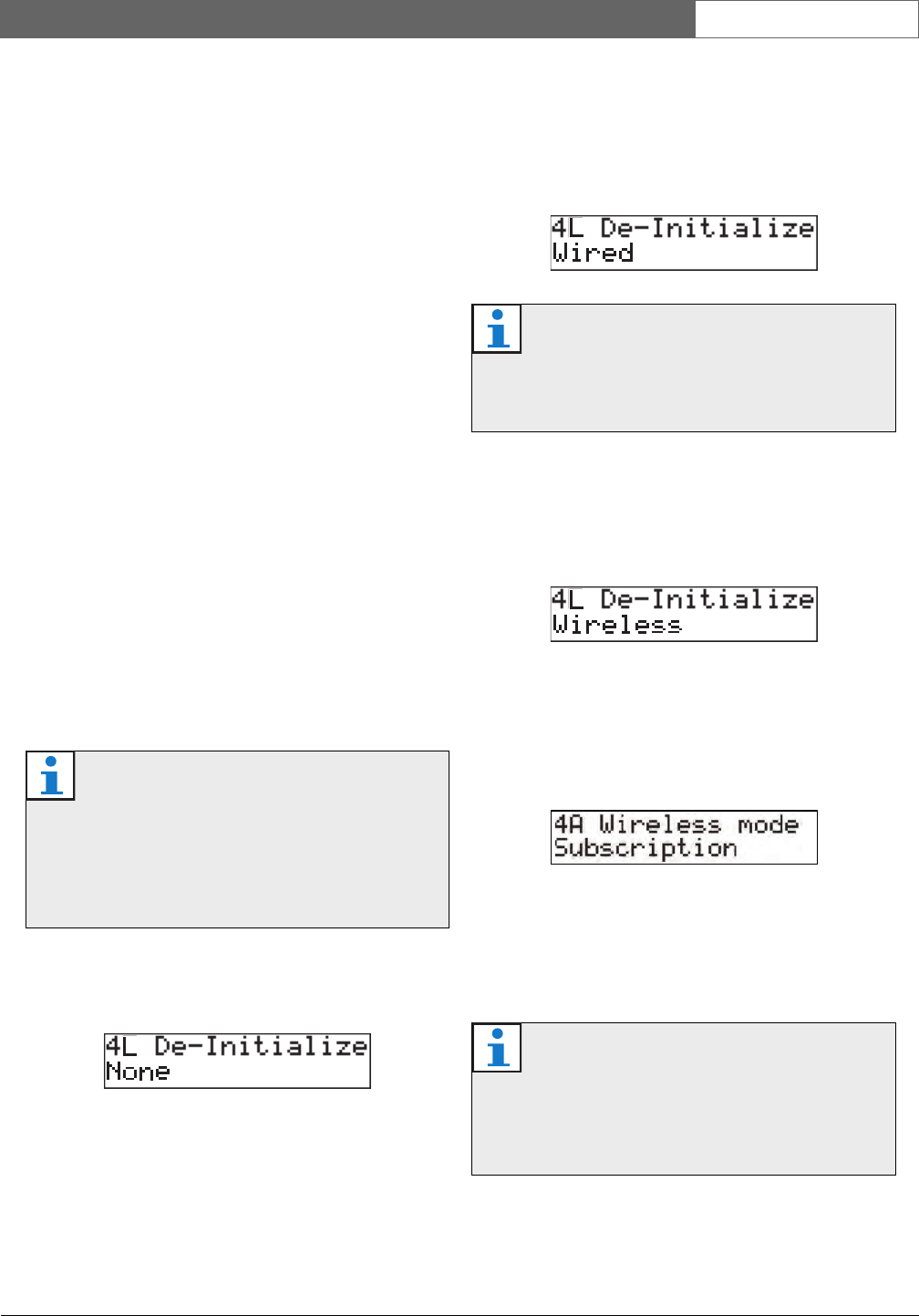
Bosch Security Systems | 2007-11 | 9922 141 70691 en
DCN Wireless | Installation and User Instructions | Central Devices en | 61
12 System configuration
12.1 Introduction
The central control unit controls the system. Use the
configuration menu of the central control unit to
configure the system.
12.2 Initialization
12.2.1 Introduction
Each active DCN device in the system must have an
address. The central control unit cannot send data to an
active DCN device that does not have an address.
During the initialization, the central control unit gives
addresses to the active DCN devices.
Each wireless device in the system must have a
subscription. The central control unit cannot send data
to a wireless device that does not have a subscription.
During the initialization, the wireless access point gives
subscriptions to the wireless devices.
12.2.2 System
You must do the initialization of the system before you
can use the system:
1 Select the 4L De-initialize menu item of the
configuration menu of the central control unit.
2 Set the value of the parameter in the menu item to
Wired. The addresses of all active devices in the
DCN are erased. All LEDs on all active devices in
the DCN come on.
3 Set the value of the parameter in the menu item to
Wireless. The LED around the microphone button
of the wireless discussion units comes on as yellow
for 2 s.
4 Select the 4A Wireless Mode menu item of the
configuration menu of the central control unit.
5 Set the value of the parameter in the menu item to
Subscription.
6 Push the microphone button of each active device in
the DCN. When the central control unit gives an
address to an active DCN device, the LEDs of the
active device go off.
Note
It is not necessary to do an initialization when
the system is re-installed in another location and
contains the same devices after it is re-installed.
Active DCN devices hold their addresses.
Wireless devices hold their subscriptions.
Note
In the next step, you erase the subscriptions
from the wireless devices and the subscription
list from the wireless access point.
Note
Do not push more than one microphone button
at the same time. The central control unit cannot
give addresses to more than one active device
at the same time.
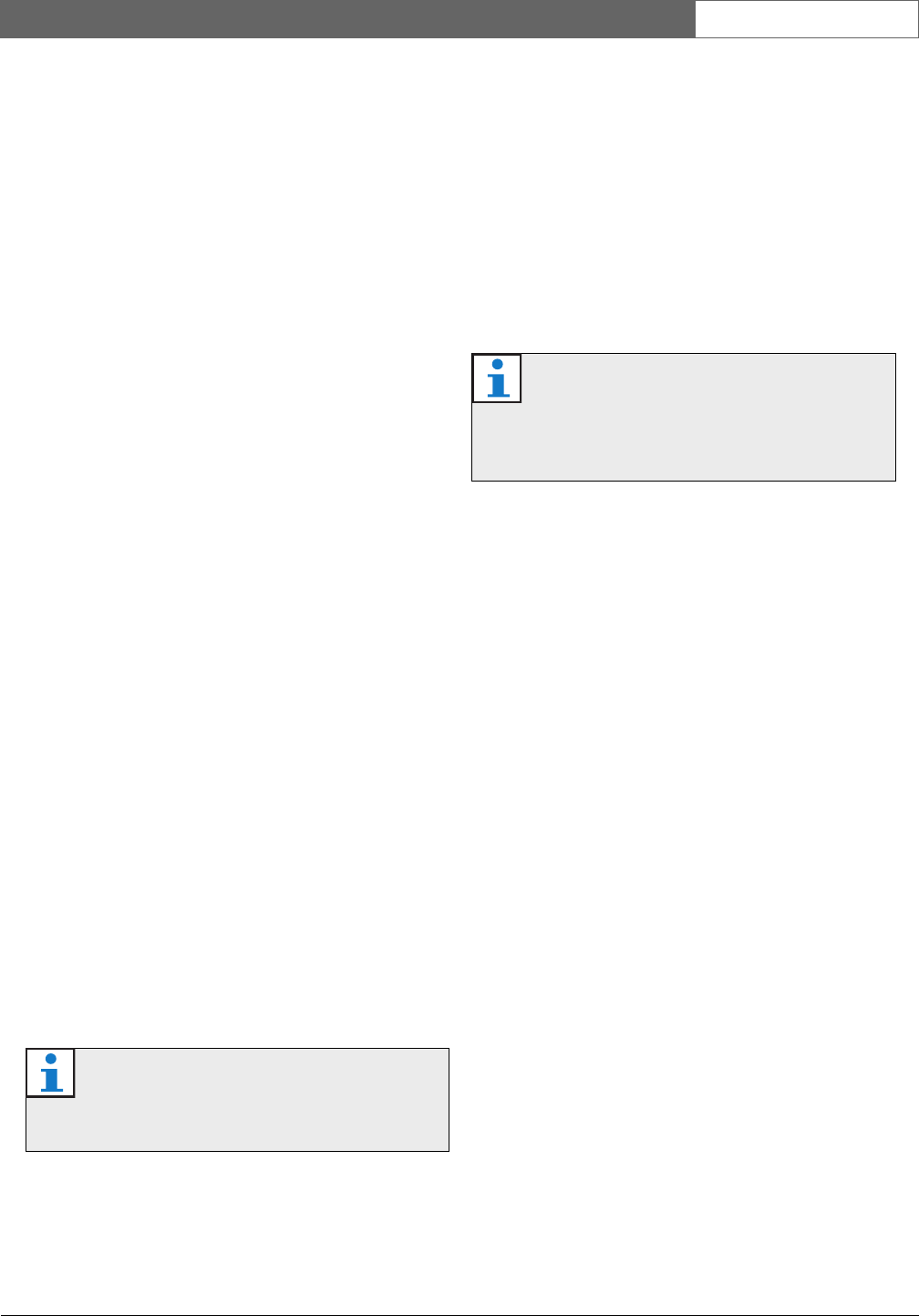
Bosch Security Systems | 2007-11 | 9922 141 70691 en
DCN Wireless | Installation and User Instructions | Central Devices en | 62
7 Push the microphone button of each wireless device.
When the central control unit gives a subscription to
the wireless discussion unit, the LED around the
microphone button comes on as green for 2 s.
12.2.3 Extra DCN devices
You can also give addresses to active devices in the
DCN after you did the initialization of the system.
• Push the de-init switch of the active DCN device for
less than half a second to erase the address of the
active device.
• Push and hold the de-init switch of the active DCN
device for more than one second to erase the address
and do the initialization at the same time.
12.2.4 Extra wireless devices
You can also give subscriptions to wireless device after
you did the initialization of the system. Refer to 14.6 for
instructions.
12.3 Wireless modes
12.3.1 Introduction
You can set the wireless mode of the system with the
4A Wireless Mode menu item.
12.3.2 On
If the wireless mode is On, the wireless network is
activated. The delegates and chairman can use the
wireless devices that:
• Have a subscription, and
• Are activated.
12.3.3 Sleep
If the wireless mode is Sleep, the wireless network is in
the sleep mode. Use the sleep mode to increase the time
between charge of the batteries (for example, during a
long break in a discussion or conference).
12.3.4 Off
If you set the wireless mode to Off, the wireless network
is deactivated. All wireless devices with a subscription
are automatically deactivated.
12.3.5 Subscription mode
If the wireless mode is Subscription, the wireless
network is in the subscription mode. Use the
subscription mode to give subscription to extra wireless
devices (refer to 12.2.4).
Note
The wireless devices are not deactivated in the
sleep mode.
Note
The central control unit automatically goes back
to the previous wireless mode 15 minutes after
the last wireless device got a subscription.
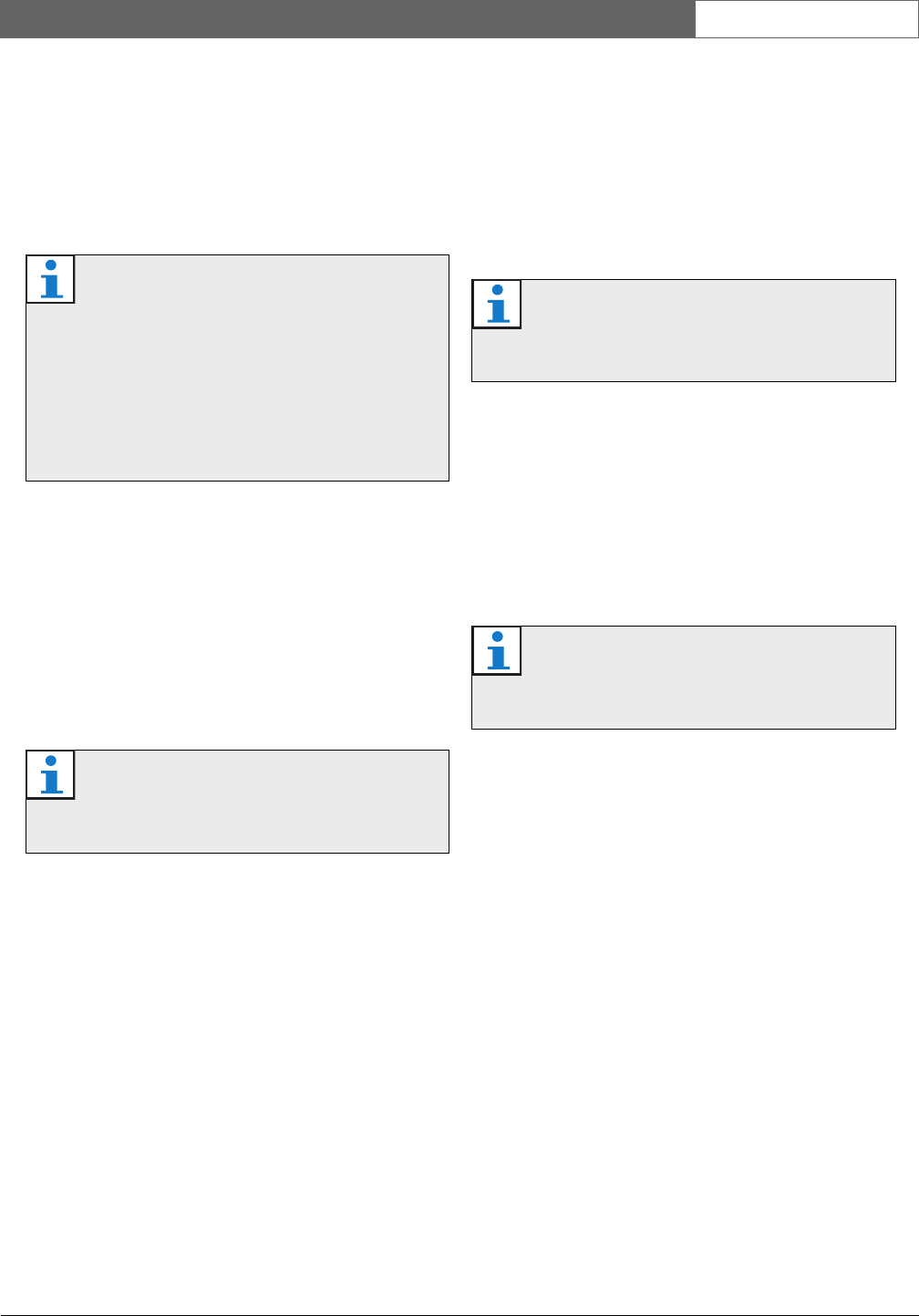
Bosch Security Systems | 2007-11 | 9922 141 70691 en
DCN Wireless | Installation and User Instructions | Central Devices en | 63
12.4 Microphone modes
12.4.1 Introduction
Select the microphone mode with the 4C Mic. Mode
menu item (refer also to 10.6.8). You must also set the
maximum number of activated delegate microphones.
12.4.2 Open
In the Open mode, delegates can activate their
microphones with the microphone button on their
contribution devices. When the maximum number of
delegates speak, the next delegate that activates his or
her microphone makes a request-to-speak. The
microphone is not activated until another delegate
deactivates his or her microphone.
12.4.3 Override
In the Override mode, delegates can activate their
microphones with the microphone button on their
contribution device. When the maximum number of
delegates speak, the next delegate that activates his or
her microphone automatically deactivates the
microphone that was activated for the longest time.
12.4.4 PTT
In the PTT (push-to-talk) mode, the delegates can
activate their microphones with the microphone button
on their contribution devices. The microphone is
activated as long as the microphone button is pushed.
When the maximum number of delegates speak, the
other delegates cannot activate their microphones.
12.4.5 Auto mic off
Enable or disable the auto microphone off function with
the 4Ka Auto mic off menu item. When the auto
microphone off function is enabled, the microphones of
the wireless devices are automatically deactivated when
they are not used for 30 seconds.
Note
The system has 4 audio channels. The delegates
can use three channels, the chairmen can use
one channel. When more than one chairman
devices are installed in the system, the next
chairman that activates his or her microphone
automatically deactivates the microphone of the
previous chairman.
Note
Microphones of chairman devices can always be
activated in the Open mode.
Note
Microphones of chairman units can always be
activated in the Override mode.
Note
Microphones of chairman units can always be
activated in the PTT mode.
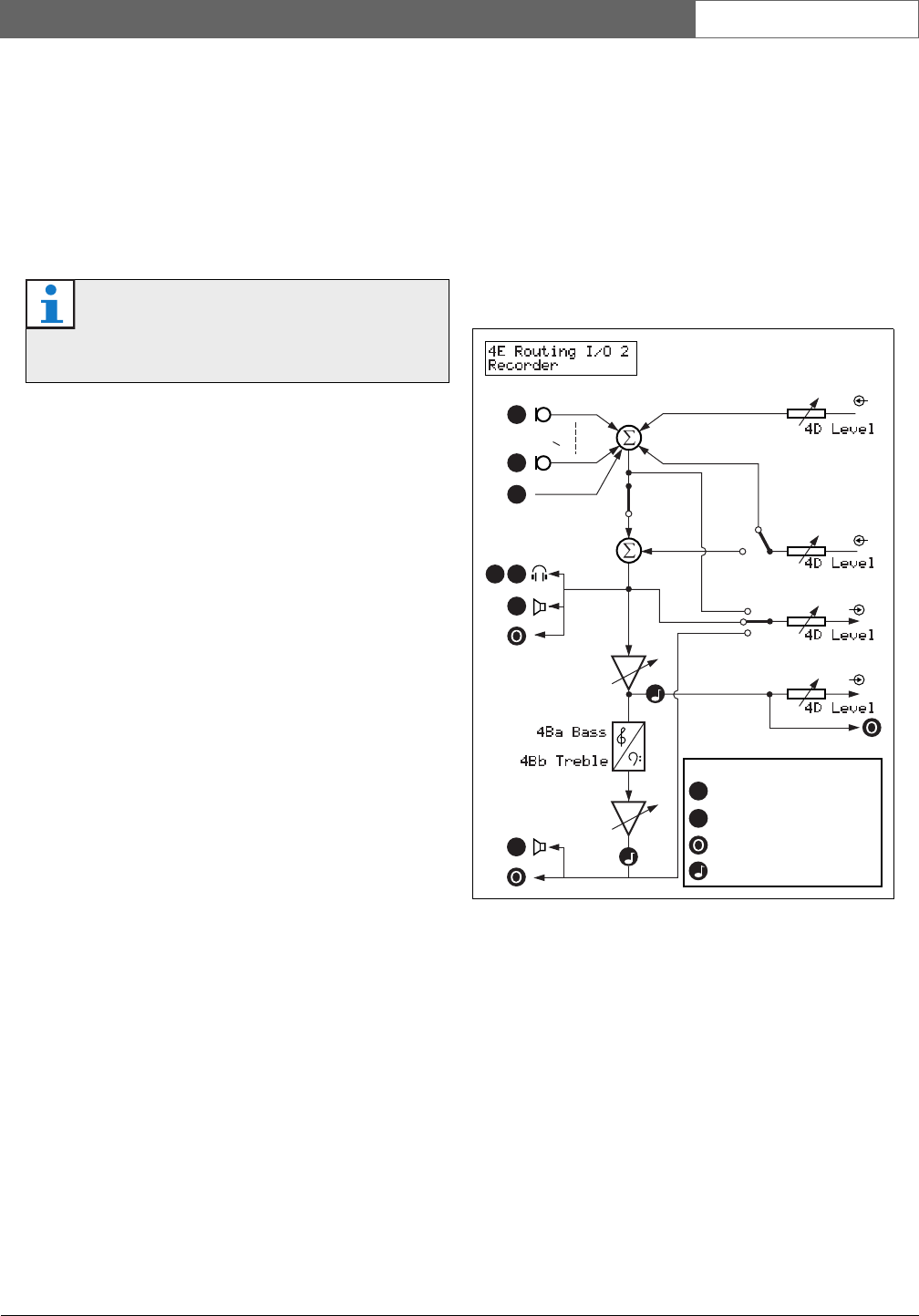
Bosch Security Systems | 2007-11 | 9922 141 70691 en
DCN Wireless | Installation and User Instructions | Central Devices en | 64
12.5 Repetition rate
When other wireless networks cause interference, the
audio quality can decrease. In some cases, you can
increase the repetition rate of the audio packets to
improve the audio quality. You can change the
repetition rate of the audio packets with the
4Kc Repetition menu item.
12.6 Audio routing modes
12.6.1 Introduction
You can set the audio routing mode of the system with
the 4E Routing I/O 2 menu item. The functions of audio
input 1 and audio output 1 of the central control unit are
the same in each audio routing mode. The signal on
audio input 1 is always added to the floor signal. The
signal on audio output 1 is always suitable to connect
the system to an external public address system (for
example, Praesideo).
12.6.2 Recorder
In the Recorder mode, audio output 2 of the central
control unit transmits a signal that you can connect to
an external audio recorder (refer to figure 12.1). The
central control unit has no effect on the volume level of
the signal.
In the Recorder mode, the signal on audio input 2 of the
central control unit is added to the floor signal.
Note
When you increase the repetition rate, the audio
delay is increased.
figure 12.1: Recorder
DCN-WCCU
DCN-SW
3<
1
2
2
1
C
C
I
I
C
Optical network
Interpretation devices
CContribution devices
Legend
Chime
I
C
O
+
+
+
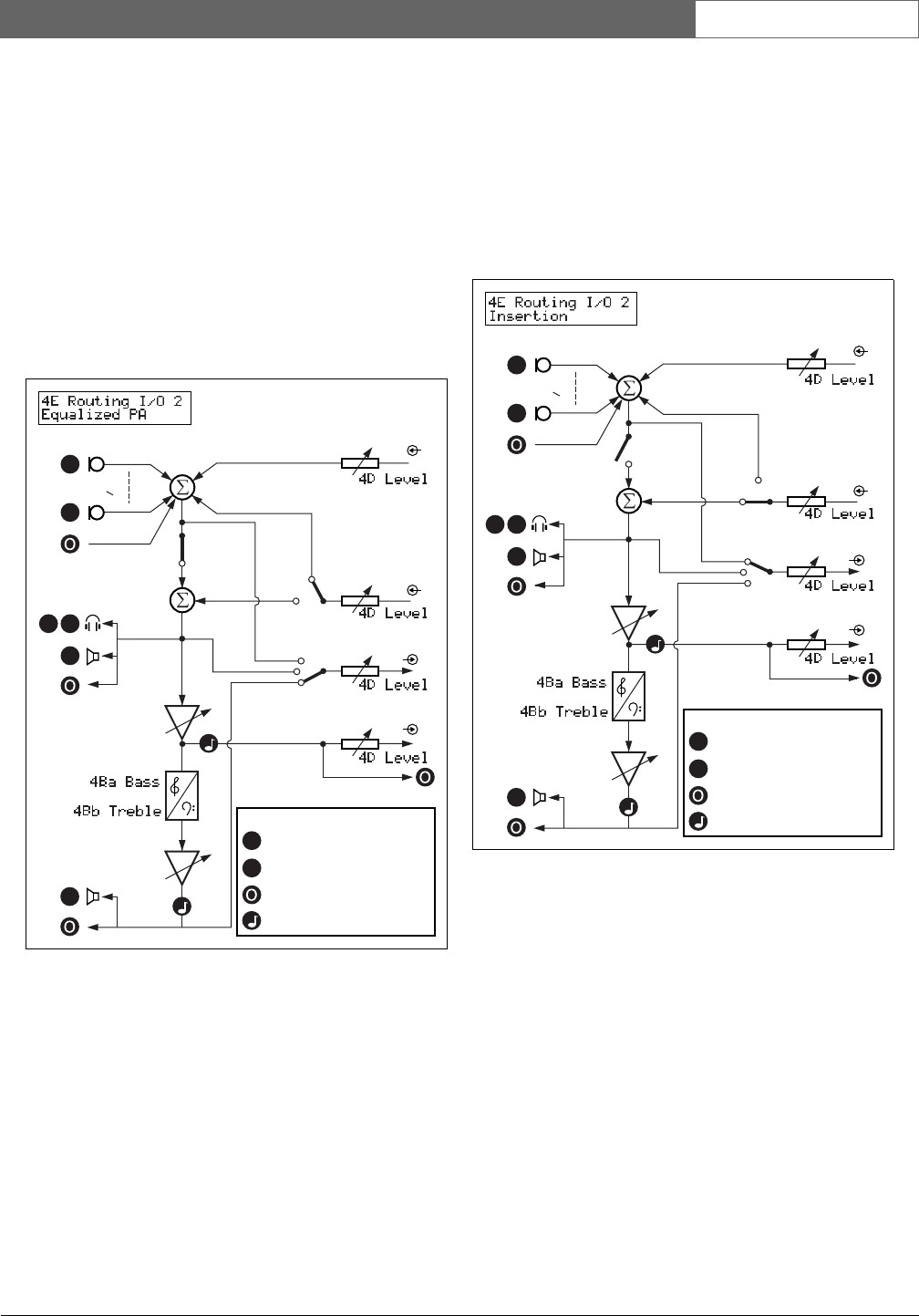
Bosch Security Systems | 2007-11 | 9922 141 70691 en
DCN Wireless | Installation and User Instructions | Central Devices en | 65
12.6.3 Equalized PA
In the Equalized PA mode, audio output 2 of the central
control unit transmits a signal that you can connect to
an external public address system (refer to figure 12.2).
The central control unit sets:
• The volume level of the signal
• The levels of the bass of the signal
• The level of the treble signal
In the Equalized PA mode, the signal on audio input 2 of
the central control unit is added to the floor signal.
12.6.4 Insertion
In the Insertion mode, audio output 2 and audio input 2
of the central control unit are used to add signals from
external audio devices (refer to figure 12.3). For
example, you can connect an external audio mixer
between audio output 2 and audio input 2 of the central
control unit.
In the Insertion mode, you must install a device between
audio output 2 and audio input 2 of the central control
unit. When you do not install a device, the audio signals
from contribution devices (floor) leave the system, but
do not enter the system again.
figure 12.2: Equalized PA
DCN-WCCU
DCN-SW
3<
1
2
2
1
C
C
I
I
C
Optical network
Interpretation devices
CContribution devices
Legend
Chime
I
C
+
+
+
figure 12.3: Insertion
DCN-WCCU
DCN-SW
3<
1
2
2
1
C
C
I
I
C
Optical network
Interpretation devices
CContribution devices
Legend
Chime
I
C
+
+
+
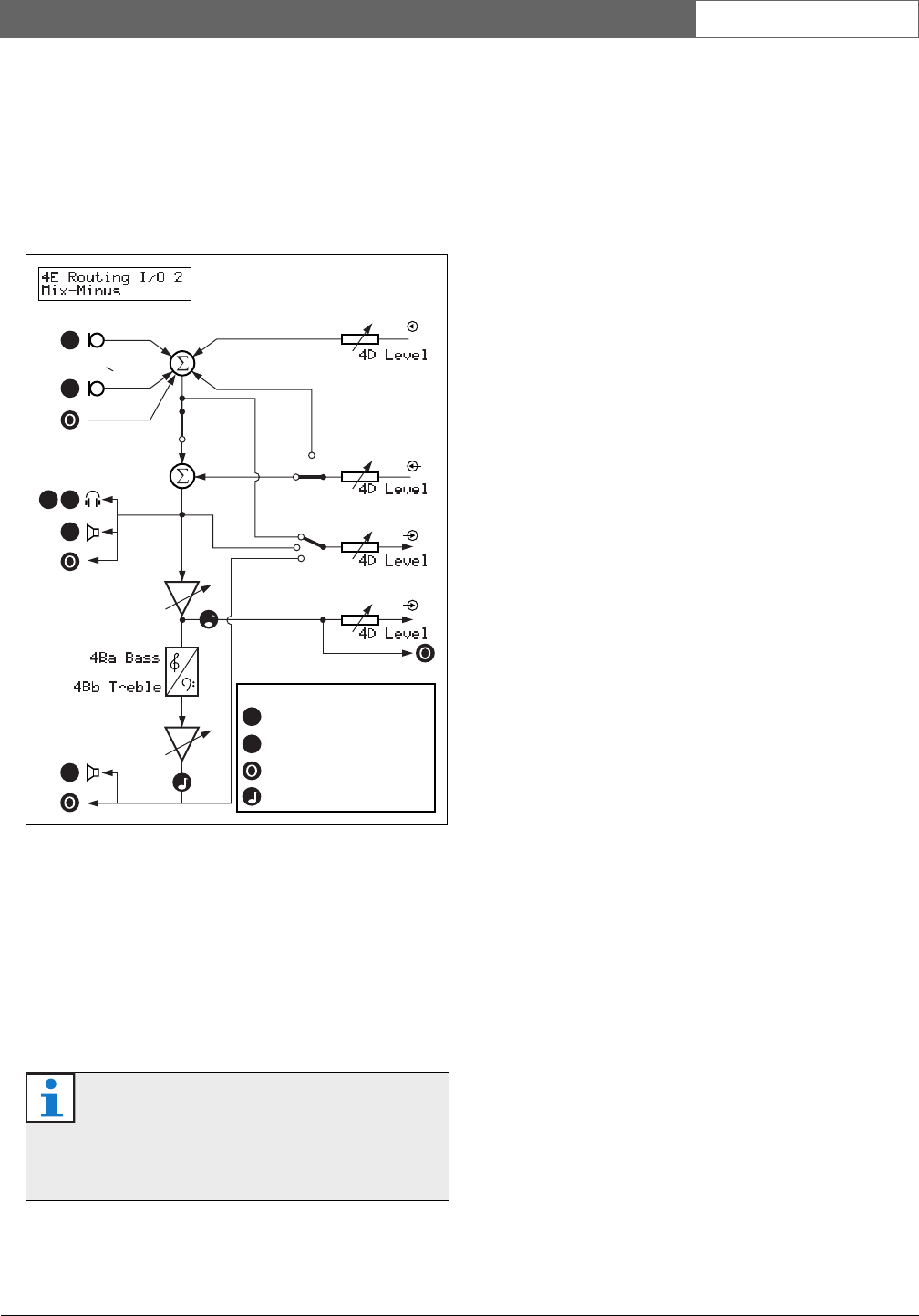
Bosch Security Systems | 2007-11 | 9922 141 70691 en
DCN Wireless | Installation and User Instructions | Central Devices en | 66
12.6.5 Mix-minus
In the Mix-minus mode, audio output 2 and audio input
2 of the central control unit are used to connect 2
systems (refer to figure 12.4). Use the Mix-minus mode to
connect the audio of two systems. The Mix-minus
connection does not cause acoustic feedback.
When you connect two systems:
• Go to menu item 4E Routing I/O 2 to set the systems
in the Mix minus mode.
• Connect audio input 2 of the first system to audio
output 2 of the second system.
• Connect audio output 2 of the first system to audio
input 2 of the second system.
12.7 Attention chimes
The central control unit can play an attention chime
when the chairman:
• Pushes the priority button on the chairman device.
• Starts a voting session.
You can enable or disable attention chimes with the
4F Att. Tones menu item (refer also to 10.6.8). There are
3 different attention chimes available.
12.8 Erase requests-to-speak and
speakers
The central control unit can erase the requests-to-speak
and speakers when the chairman pushes the priority
button on the chairman device. You can enable or
disable this function with the 4G Mic. Priority menu item
(refer to 10.6.8).
• If you set the menu item to Permanently off, the
system does not activate the microphones of the
delegates again when the chairman releases the
priority button. The requests-to-speak and speakers
are erased.
• If you set the menu item to Temporarily off, the
system activates the microphones of the delegates
again when the chairman releases the priority
button. The requests-to-speak and speakers are not
erased.
12.9 Floor distribution
The central control unit can send the floor signal to all
empty channels in the system. You can enable or
disable this function with the 4I Floor Distr. menu item
(refer to 10.6.8).
• If you set the menu item to Off, the central control
unit does not send the floor signal to all empty
signals in the system.
• If you set the menu item to On, the central control
unit sends the floor signal to all empty channels in
the system.
figure 12.4: Mix-minus
Note
When the distance between the two systems is
great, you can use a telephone coupler to
connect the two systems.
DCN-WCCU
DCN-SW
3<
1
2
2
1
C
C
I
I
C
Optical network
Interpretation devices
CContribution devices
Legend
Chime
I
C
+
+
+
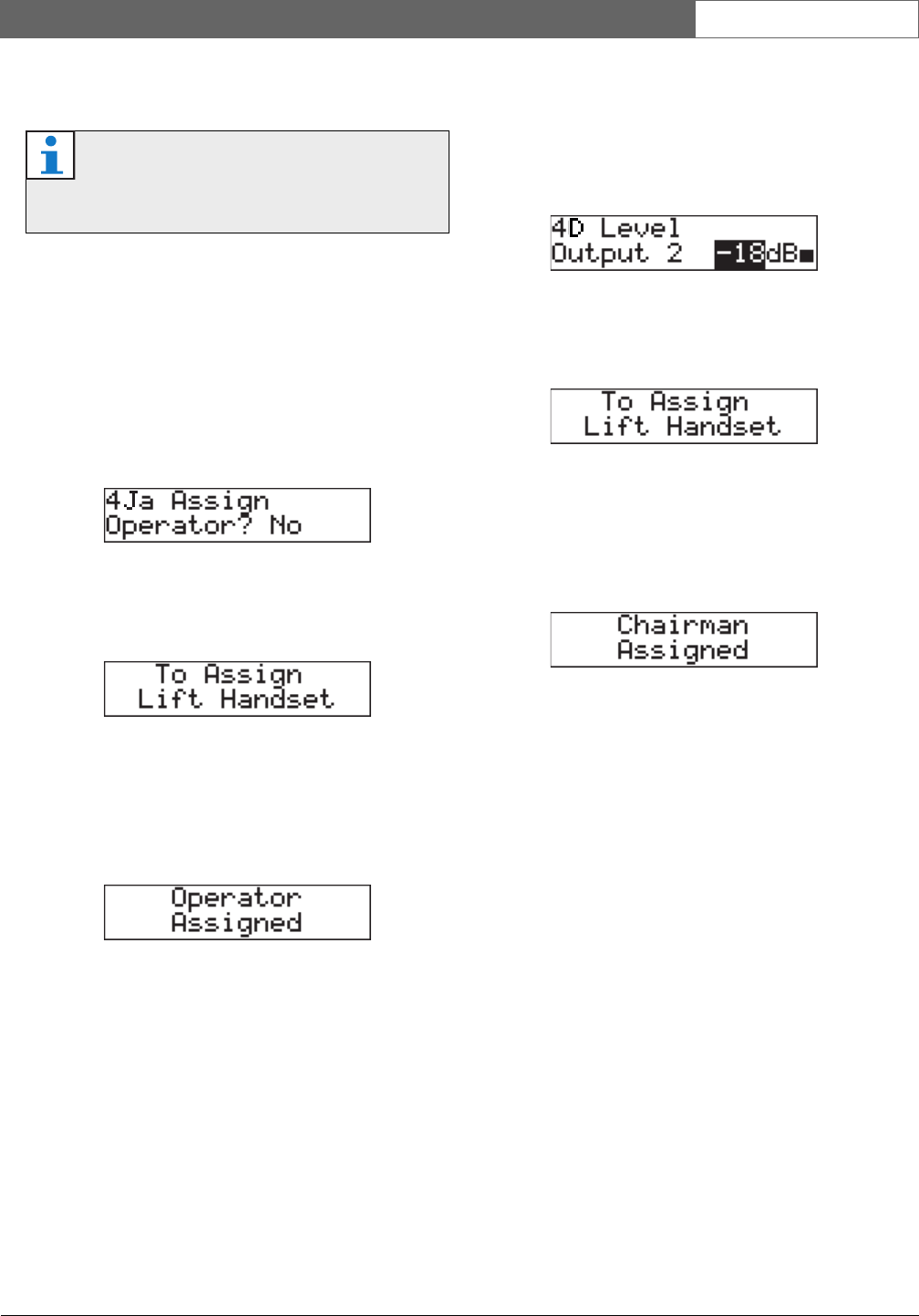
Bosch Security Systems | 2007-11 | 9922 141 70691 en
DCN Wireless | Installation and User Instructions | Central Devices en | 67
12.10 Intercom
12.10.1 Introduction
To enable the intercom you must first identify the
locations of the operator and the chairman.
12.10.2 Location of the operator
To identify the location of the operator:
1 Select the 4Ja Assign menu item of the configuration
menu of the central control unit.
2 Set the value of the parameter in the menu item to
Yes. The display of the central control unit shows:
3 Lift the receiver of the intercom handset of the
operator to identify the location of the operator.
When the central control unit identifies the location,
the display of the central control unit shows:
12.10.3 Location of the chairman
To identify the location of the chairman:
1 Go to the 4Jb Assign menu item of the configuration
menu of the central control unit.
2 Set the value of the parameter in the menu item to
Yes. The display of the central control unit shows:
3 Lift the receiver of the intercom handset of the
chairman to identify the location of the chairman.
When the central control unit identifies the location,
the display of the central control unit shows:
Note
You can make an intercom device with the
DCN-DDI Dual Delegate Unit (refer to chapter ).
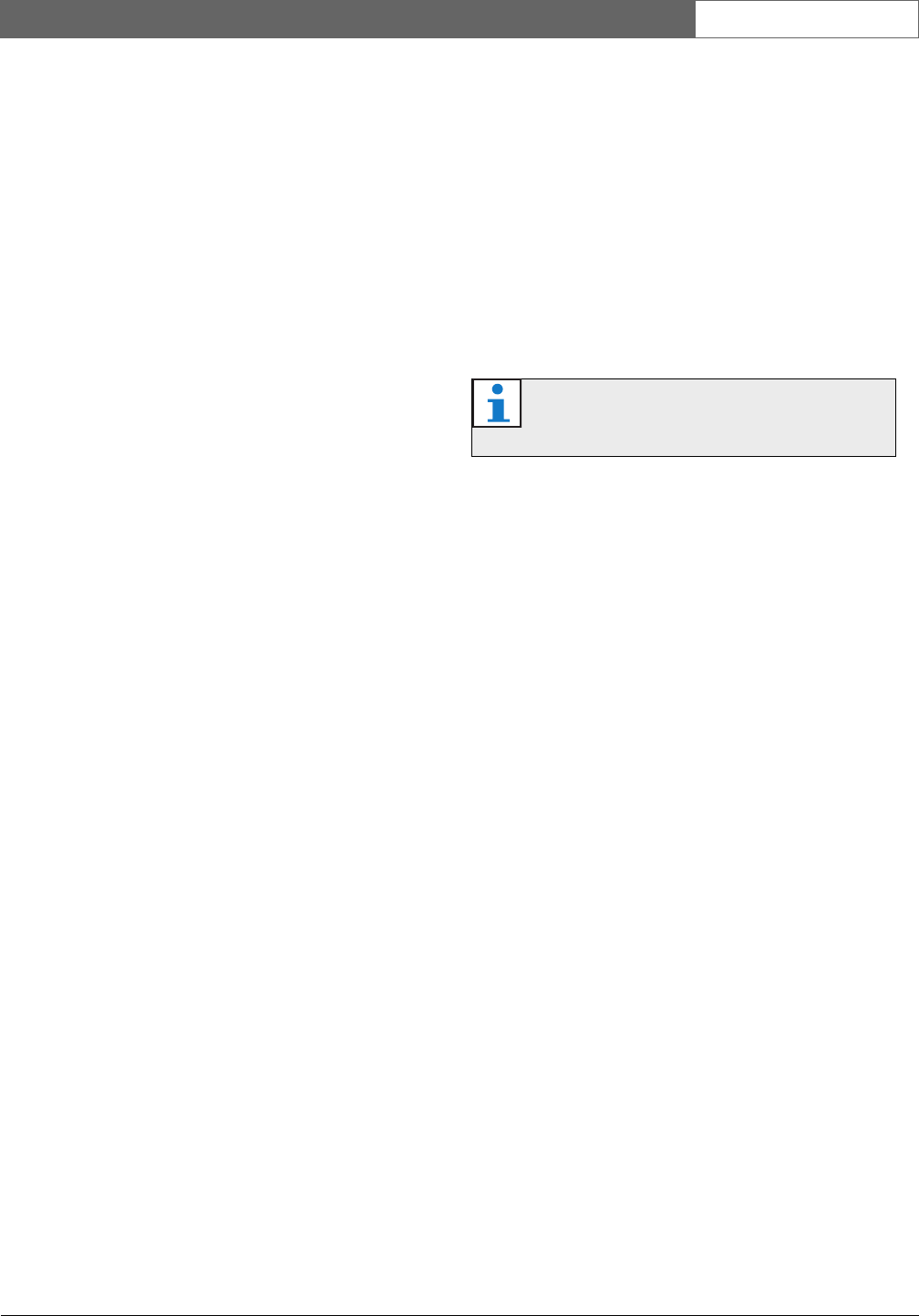
Bosch Security Systems | 2007-11 | 9922 141 70691 en
DCN Wireless | Installation and User Instructions | Central Devices en | 68
13 System operation
13.1 Start the system
Before starting the system, make sure:
• the system is correctly installed.
• the required number of wireless discussion units
have been subscribed.
Do as follows:
1 Push the on/off switch on the central control unit.
The display comes on. All devices in the DCN and
optical network are activated.
2 Install the battery packs in the wireless discussion
units.
3 Push the microphone buttons on the wireless
discussion units to activate the wireless discussion
units. The LED around the microphone button
comes on as yellow for 250 milliseconds (if the
software version of the wireless discussion unit is
lower than 2.35, the LED around the microphone
button comes on as green for 2 seconds).
• If all LEDs of the wireless discussion unit are off, the
wireless discussion unit is activated, and ready to
use.
• If the LED around the microphone button stays on
as yellow, and the indicator ring of the microphone
comes on as red, the wireless discussion unit cannot
find the subscribed wireless network. If the wireless
network is found within 15 minutes, the wireless
discussion unit connects. If not, the wireless
discussion unit automatically deactivates (if the
software version of the wireless discussion unit is
lower than 2.35, the LED around the microphone
button alternates red and yellow for 5 seconds to
indicate that the wireless discussion unit cannot find
the subscribed wireless network. If the wireless
network is found within 5 seconds, the wireless
discussion unit connects. If not, the wireless
discussion unit automatically deactivates).
• If you want to use the wireless discussion unit in a
new system, but it is already subscribed to another
system (see previous bullet point), you must first
deinitialize the unit (refer to section 14.6.3). After the
unit has been de-initialization it must be subscribed
to the new system (refer to section 14.6.2).
13.2 Stop the system
Do as follows:
1 Select the 4A Wireless Mode menu item of the
configuration menu of the central control unit.
2 Set the value of the parameter in the menu item to
Off. All wireless discussion units are deactivated.
3 Push the on/off switch of the central control unit.
The display goes off. All devices in the DCN and the
optical network are deactivated.
Note
If necessary, charge the battery packs.

Bosch Security Systems | 2007-11 | 9922 141 70691 en
DCN Wireless | Installation and User Instructions | Contribution Devices en | 69
Section 3 - Contribution Devices

Bosch Security Systems | 2007-11 | 9922 141 70691 en
DCN Wireless | Installation and User Instructions | Contribution Devices en | 70
14 DCN-WDU Wireless
Discussion Units
14.1 Introduction
With the wireless discussion units, the delegates and
chairmen can make contributions to a discussion. The
chairmen can also use their wireless discussion units to
monitor and control a discussion.
14.2 Controls, connectors and
indicators
14.2.1 Top
The top of the wireless discussion units (refer to figure
14.1) contains:
1Microphone socket - Connects a DCN-MICL or
DCN-MICS Pluggable Microphone to the wireless
discussion unit (refer to chapter 15).
2Loudspeaker - Gives the audio signal from the
floor to the delegate or the chairman. When the
microphone is activated, the signal of the
loudspeaker is muted.
3Volume buttons - Change the volume level of the
signal that is sent to the headphones.
4Microphone buttons - Activate or deactivate the
microphone. Each microphone button has a LED
that shows the condition of the microphone. The
mode of the wireless discussion unit (refer to section
14.8.4) gives the type and number of microphone
buttons that you must install in the wireless
discussion unit.
5Voting buttons - Operate the wireless discussion
unit. Each voting button has a yellow LED.
6Channel selector display - Shows the number of
the channel and the abbreviation of the language
that is sent to the headphones (refer to appendix B in
the DCN Next Generation Installation and User
Instructions). When the display shows FLR, the floor
signal is sent to the headphones.
7Channel selector buttons - Select the channel
that is sent to the headphones.
14.2.2 Left and right sides
The left and right sides of the wireless discussion units
(refer to figure 14.3) contain:
8Headphones socket - Connect headphones to the
wireless discussion unit (refer to section 14.7.1).
14.2.3 Bottom side
The bottom side of the wireless discussion units (refer to
figure 14.4 and figure 14.5) contains:
9Battery pack container - Contains the
DCN-WLION Battery Pack (refer to chapter 16).
10 Configuration switches - Configure the wireless
discussion unit (refer to section 14.3) and set the
mode of the wireless discussion unit (refer to section
14.4).
11 De-init switch - Erases the subscription from the
wireless discussion unit (refer to section 12.2).
12 Power supply socket - Connects a DCN-WPS
Power Supply Adapter to the wireless discussion
unit.
14.2.4 Rear side
The rear side of the wireless discussion units (refer to
figure 14.6) contains:
13 Status LEDs - Give information about the
condition of the wireless discussion unit (refer to
section 14.8.6).
Notee
You can change the type of language
abbreviation with menu e of the installation
menu of the interpreter desk (refer to Section
33 in the DCN Next Generation Installation and
User Instructions).
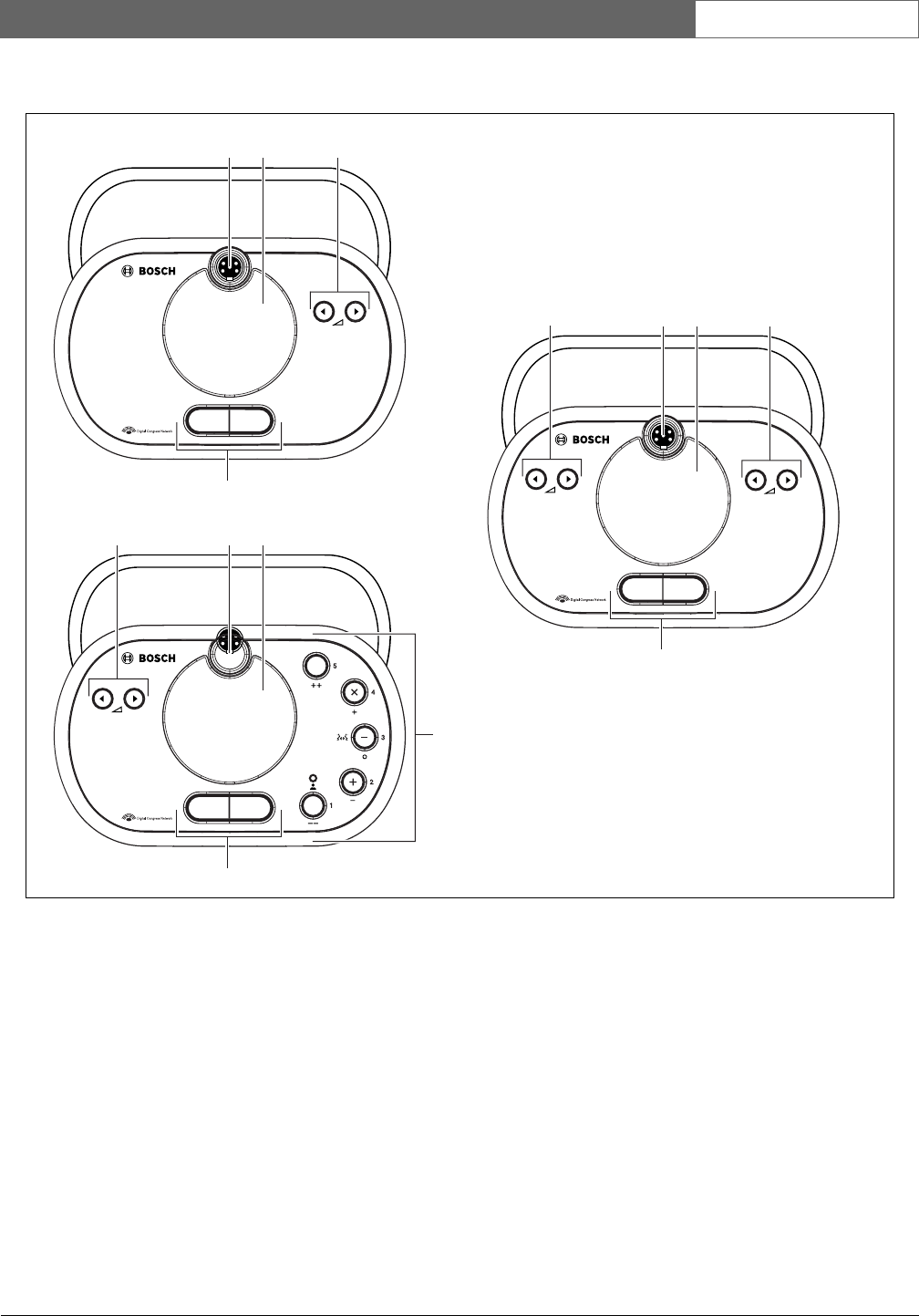
Bosch Security Systems | 2007-11 | 9922 141 70691 en
DCN Wireless | Installation and User Instructions | Contribution Devices en | 71
figure 14.1: Top views (1)
1 2 3
4
DCN-WD
DCN-WDV
DCN-WDD
1 2 3
4
1 23
4
5
3
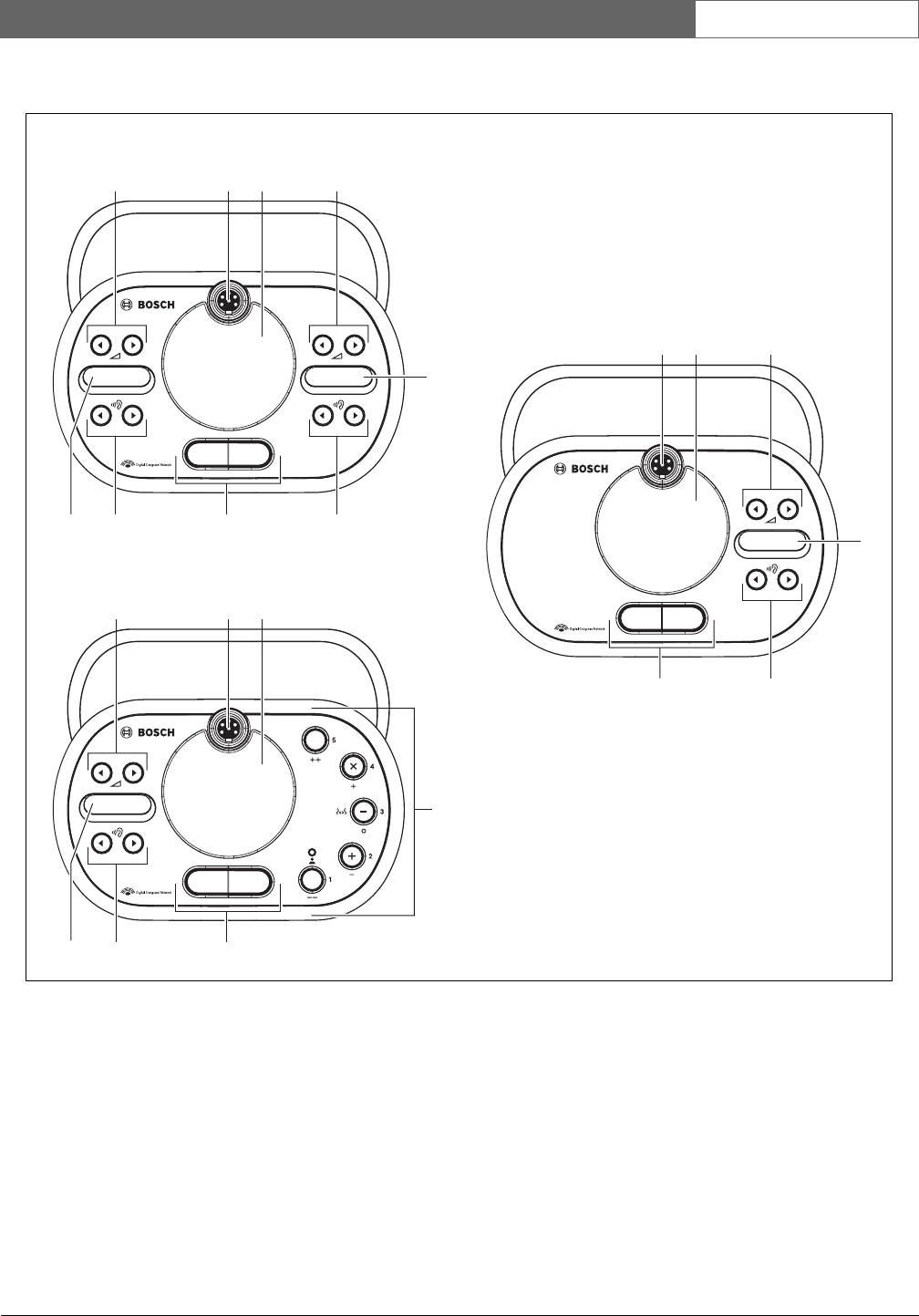
Bosch Security Systems | 2007-11 | 9922 141 70691 en
DCN Wireless | Installation and User Instructions | Contribution Devices en | 72
figure 14.2: Top views (2)
1 2 3
4
DCN-DISDCS
DCN-DISVCS
1 23
7 4
5
7
3
76
6
6
74
12
6
3DCN-DISCS
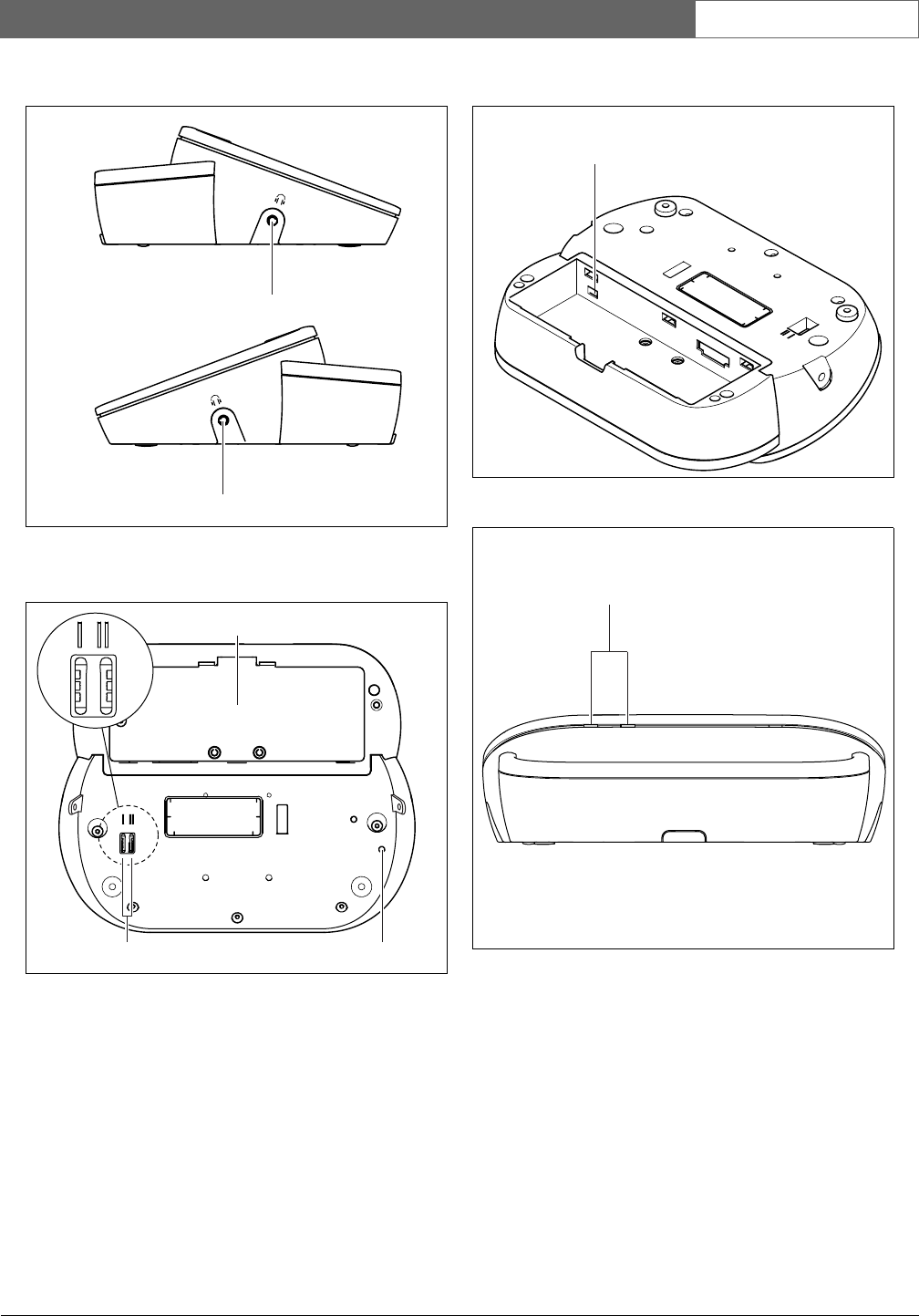
Bosch Security Systems | 2007-11 | 9922 141 70691 en
DCN Wireless | Installation and User Instructions | Contribution Devices en | 73
figure 14.3: Side views
figure 14.4: Bottom view (1)
8
8
9
3
2
1
10 11
figure 14.5: Bottom view (2)
figure 14.6: Rear view
12
13
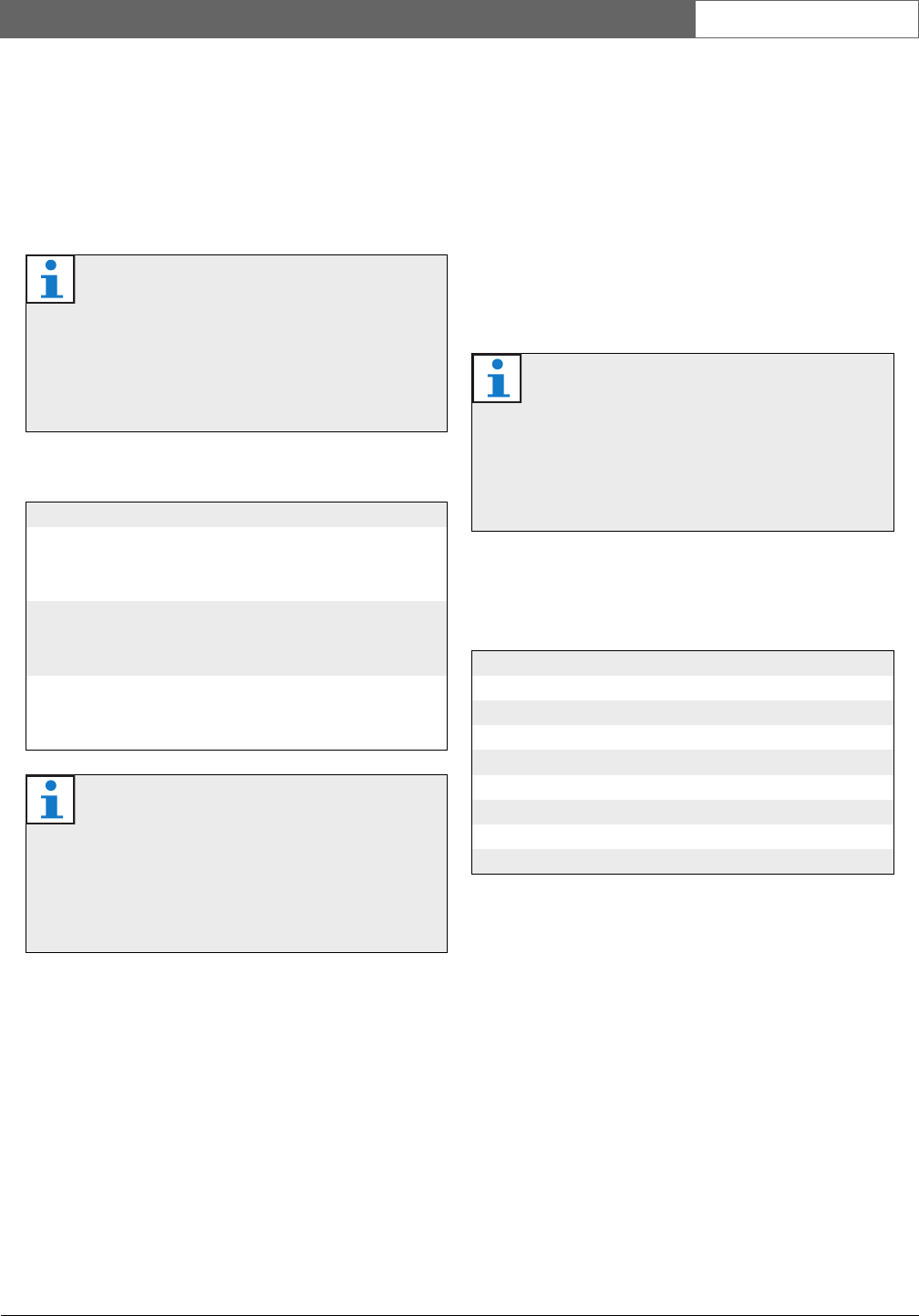
Bosch Security Systems | 2007-11 | 9922 141 70691 en
DCN Wireless | Installation and User Instructions | Contribution Devices en | 74
14.3 Internal settings
14.3.1 Introduction
With the configuration switches on the bottom of the
wireless discussion unit (refer to figure 14.4, no. 10), you
can configure the wireless discussion unit.
14.3.2 Microphone sensitivity
When the configuration switches are in the correct
position (refer to table 14.1), you can adjust the
microphone sensitivity of the wireless discussion unit
between -2 and 2 dB.
• To increase the microphone sensitivity with 0.5 dB,
push the >volume button.
• To decrease the microphone sensitivity with -0.5 dB,
push the <volume button.
The LED around the microphone button shows the
sensitivity (refer to table 14.2).
Note
The internal settings apply to the wireless
discussion unit. When the wireless discussion
unit is in the dual delegate mode (refer to
section 14.4.5), the internal settings are the
same for the two delegates.
table 14.1: Internal settings
I II Internal setting
2 1 Microphone sensitivity
(refer to section 14.3.2).
Default: 0 dB.
2 2 Channel/volume restore function
(refer to section 14.3.3).
Default: disabled.
2 3 Headphones level reduction
(refer to section 14.3.4)
Default: disabled.
Note
The central control unit does not keep the
internal settings of the wireless discussion units.
After you set the mode (refer to section 14.4),
the wireless discussion unit keeps the internal
settings.
Note
When the wireless discussion unit has two sets
of volume buttons, configure the microphone
sensitivity with the right set of volume buttons.
The microphone sensitivity cannot be
configured with the left set of volume buttons.
table 14.2: Microphone sensitivity
Microphone button LED Sensitivity
Red -2 dB
Off -1.5 dB
Red/Yellow -1 dB
Off -0.5 dB
Yel l o w 0 d B
Green/Yellow 1 dB
Off 1.5 dB
Green 2 dB
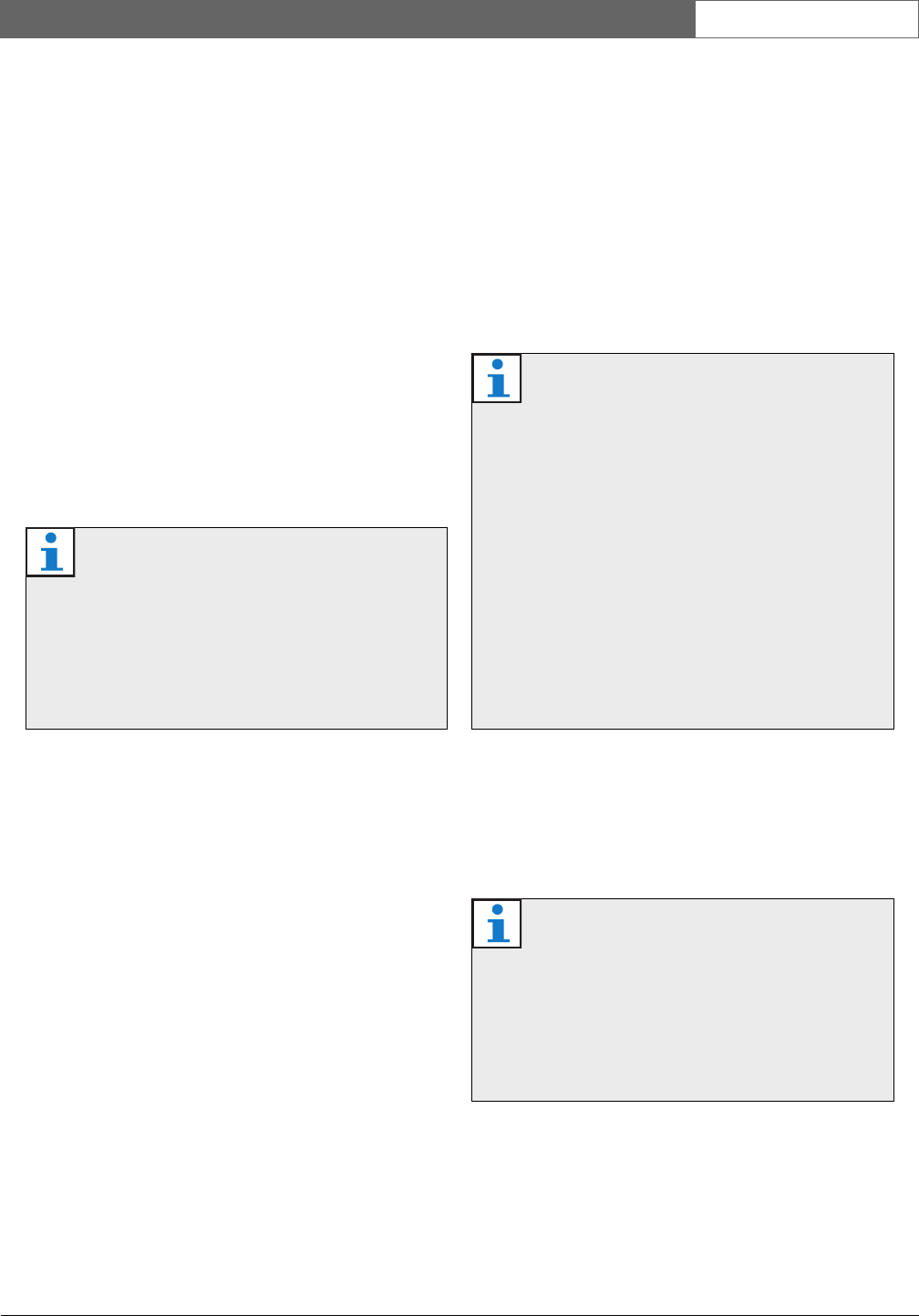
Bosch Security Systems | 2007-11 | 9922 141 70691 en
DCN Wireless | Installation and User Instructions | Contribution Devices en | 75
14.3.3 Channel/volume restore function
When the configuration switches are in the correct
position (refer to table 14.1), you can enable or disable
the channel/volume restore function of the headphones
connection of the wireless discussion unit.
• To enable the channel/volume restore function of
the headphones, push the >volume button. (The
LED around the microphone buttons come on as
green.) When the wireless discussion unit is enabled,
it automatically sets the last known volume and
channel.
• To disable the channel/volume restore function of
the headphones, push the <volume button. (The
LED around the left microphone button comes on as
red.) When the wireless discussion unit is enabled, it
automatically sets the channel to floor, and the
volume to -18 dB.
For example, you can enable this function in discussions
in which the delegates and chairmen always use the
same wireless discussion unit.
14.3.4 Headphones level reduction
When the configuration switches are in the correct
position (refer to table 14.1), you can enable or disable
the headphones level reduction of the wireless
discussion unit.
• To enable the headphones level reduction, push the
>volume button. (The LED around the left
microphone button comes on as green.) When the
microphone is enabled, the headphones level
reduction is 18 dB.
• To disable the headphones level reduction, push the
<volume button. (The LED around the left
microphone button comes on as red.) When the
microphone is enabled, there is no headphones level
reduction.
For example, you can enable this function to avoid
acoustic feedback between the microphone and the
headphones of the wireless discussion unit.
Note
When the wireless discussion unit has two sets
of volume buttons, configure the channel/
volume restore function with the right set of
volume buttons. The channel/volume restore
function cannot be configured with the left set of
volume buttons.
Note
When the wireless discussion unit is in the dual
delegate mode (refer to section 14.4.5) and the
headphones level reduction is enabled:
• The signal that is sent to the left headphones
socket is decreased when the left
microphone button is pushed. The signal
that is sent to the right headphones socket is
not decreased.
• The signal that is sent to the right
headphones socket is decreased when the
right microphone button is pushed. The
signal that is sent to the left headphones
socket is not decreased.
Note
When the wireless discussion unit has two sets
of volume buttons, configure the headphones
level reduction with the right set of volume
buttons. The headphones level reduction
function cannot be configured with the left set of
volume buttons.
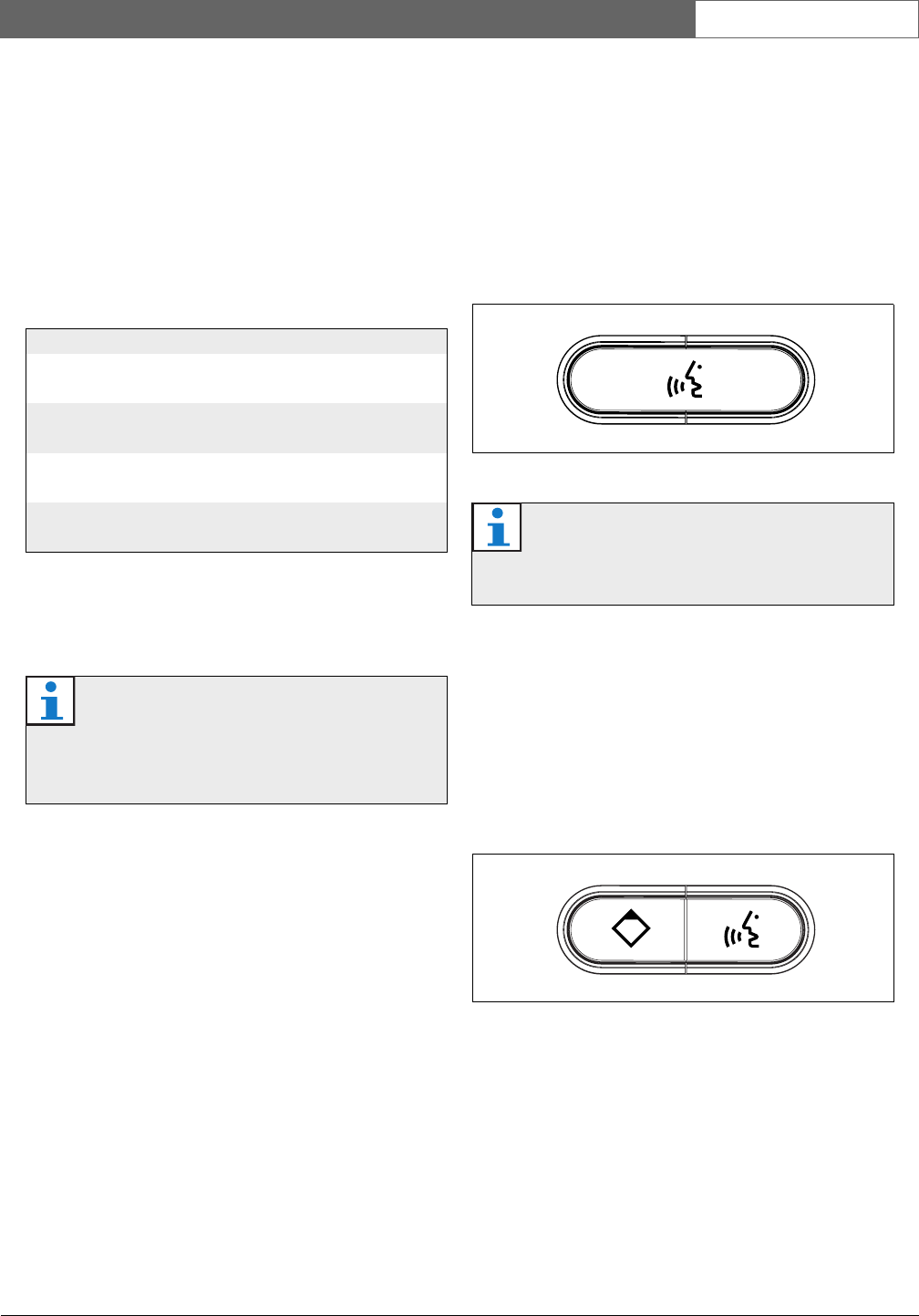
Bosch Security Systems | 2007-11 | 9922 141 70691 en
DCN Wireless | Installation and User Instructions | Contribution Devices en | 76
14.4 Modes
14.4.1 Overview
With the configuration switches on the bottom of the
wireless discussion unit (refer to figure 14.4, no. 10), you
can configure the mode of the wireless discussion unit.
Each type of wireless discussion unit can operate in a
number of modes (refer to table 14.3).
14.4.2 Procedure
1 Remove the battery pack from the wireless
discussion unit.
2 Change the mode of the wireless discussion unit
(refer to table 14.3).
3 Re-install the battery pack in the wireless discussion
unit (refer to section 14.5.3).
14.4.3 Single delegate
When the wireless discussion unit is in the single
delegate mode, it is a delegate device for 1 delegate.
You can put all types of wireless discussion units in the
single delegate mode. When you put the wireless
discussion unit in the single delegate mode, you must
also install the default microphone button (refer to
figure 14.7 and section 14.5.2).
14.4.4 Chairman
When the wireless discussion unit is in the chairman
mode, it is a chairman device for 1 chairman. You can
put all types of wireless discussion units in the chairman
mode. When you put the wireless discussion unit in the
chairman mode, you must also install the
DCN-DISBCM Buttons (refer to figure 14.8 and section
14.5.2).
table 14.3: Modes
I II Mode
1 1 Single delegate
(refer to section 14.4.3)
1 3 Chairman
(refer to section 14.4.4)
3 1 Dual delegate
(refer to section 14.4.5)
3 3 Single delegate with auxiliary control
(refer to section 14.4.6)
Note
When you do not remove the battery pack, you
can cause an incorrect operation of the wireless
discussion unit.
figure 14.7: Default microphone button
Note
All wireless discussion units are delivered with
the default microphone button.
figure 14.8: DCN-DISBCM Buttons
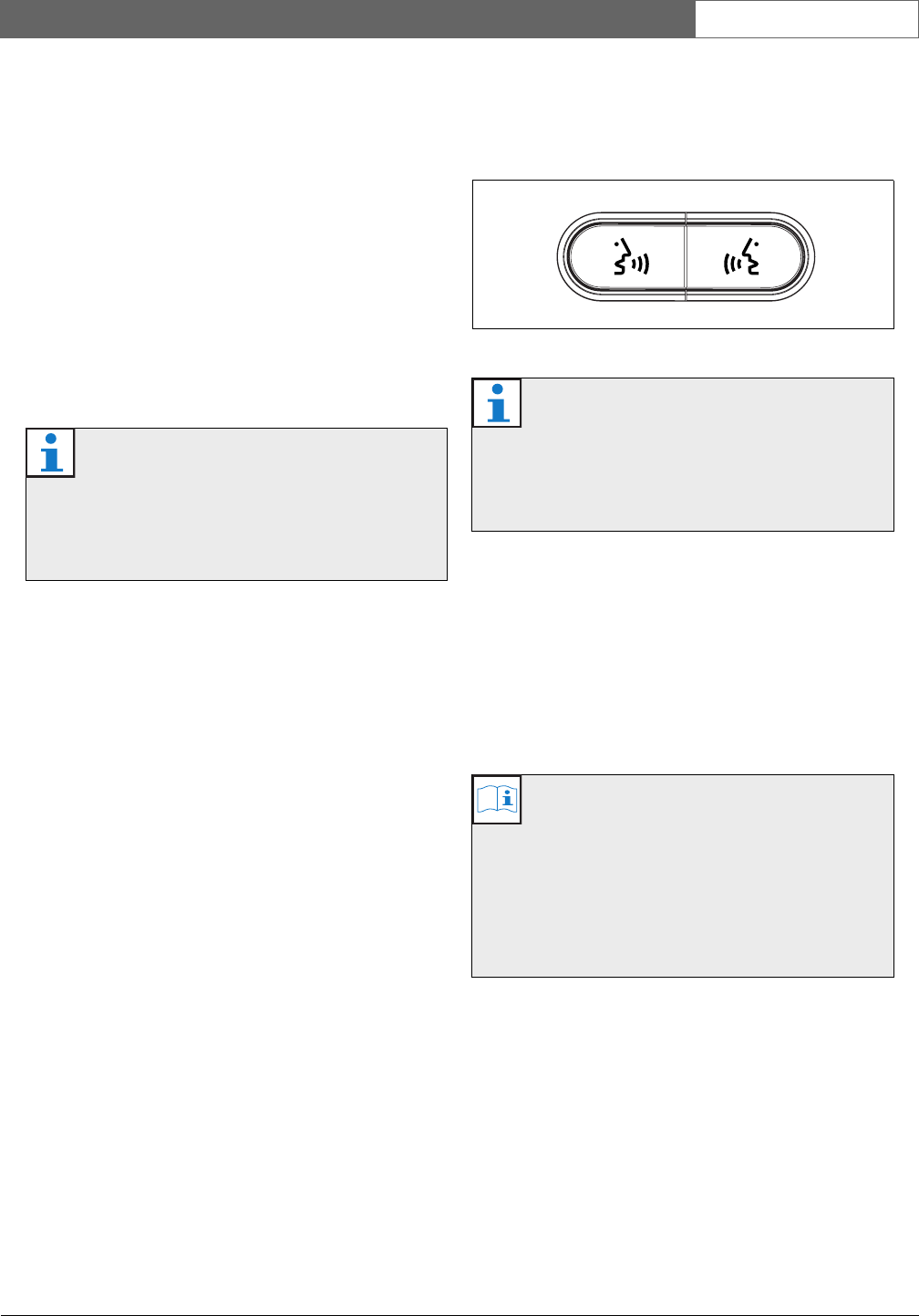
Bosch Security Systems | 2007-11 | 9922 141 70691 en
DCN Wireless | Installation and User Instructions | Contribution Devices en | 77
The only difference between a delegate wireless
discussion unit and a chairman wireless discussion unit
is the priority button on the left of the microphone
button. With the priority button, the chairman can
deactivate the microphones of all delegate devices. At
the same time, the priority button activates the
microphone of the chairman. The system has the
possibility to:
• Play an attention chime when the chairman pushes
the priority button (refer to section 12.7).
• Erase the requests-to-speak and the speakers when
the chairman pushes the priority button (refer to
section 12.8).
14.4.5 Dual delegate
When the wireless discussion unit is in the dual delegate
mode, it is a delegate device for 2 delegates. The system
sees the wireless discussion unit as two separate devices,
but it gives only one address to the wireless discussion
unit. You can only put these types of wireless discussion
units in the dual delegate mode.
•DCN-WDD
• DCN-WDDCS
When you put the wireless discussion unit in the dual
delegate mode, you must also install the DCN-DISBDD
Buttons (refer to figure 14.9 and section 14.5.2).
14.4.6 Single delegate with auxiliary
control
When the wireless discussion unit is in the single
delegate with auxiliary control mode, it is a delegate
device for 1 delegate. The delegate can use the left
microphone button as an auxiliary button. For example,
to activate an indicator.
You can only put these types of wireless discussion units
in the single delegate with auxiliary control mode:
•DCN-WDD
•DCN-WDDCS
•DCN-WDV
•DCN-WDVCS
When you put the wireless discussion unit in the single
delegate with auxiliary control mode, you must also
install two microphone buttons (refer to section 14.5.2).
Note
The DCN-DISBCM Buttons come with a tool
that you can use to remove the old buttons from
the wireless discussion unit (refer to figure
14.10).
figure 14.9: DCN-DISBDD Buttons
Note
The DCN-DISBDD Buttons come with a tool
that you can use to remove the old buttons from
the wireless discussion unit (refer to figure
14.10).
Note
When the delegate pushes the auxiliary button,
the auxiliary button makes an event. Use the
Open Interface to program the actions that must
be started by the event. Refer to the applicable
Software User Manual for instructions that tell
you how to program the Open Interface.
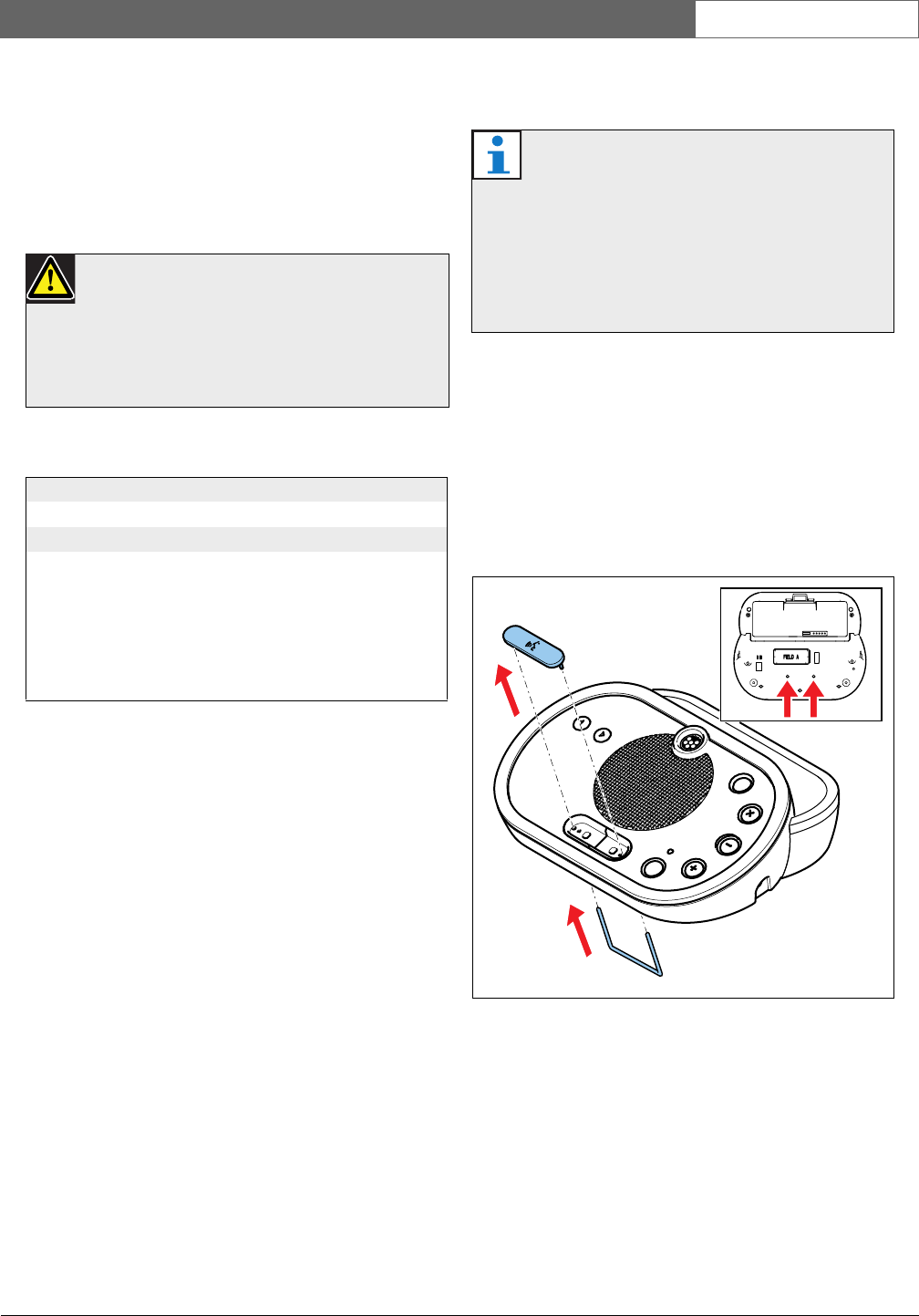
Bosch Security Systems | 2007-11 | 9922 141 70691 en
DCN Wireless | Installation and User Instructions | Contribution Devices en | 78
For example, you can use the DCN-DISBCM Buttons
(refer to figure 14.8).
14.5 Installation
14.5.1 General
14.5.2 Microphone buttons
The mode of the wireless discussion unit (refer to
section 14.4) gives the type and number of microphone
buttons that you must install in the wireless discussion
unit.
Refer to figure 14.10 for instructions that tell you how to
remove microphone buttons from a wireless discussion
unit.
Caution
Do not open the wireless discussion unit. Any
hardware change makes the product certificates
invalid. Only qualified personnel can open the
wireless discussion unit.
table 14.4: Physical characteristics
Dimensions (h x w x d):
61 x 190 x 160 mm
Weight:
• DCN-WD: 0.485 g
• DCN-WDD: 0.500 kg
• DCN-WDV: 0.505 kg
• DCN-WDCS: 0.495 kg
• DCN-WDDCS: 0.515 kg
• DCN-WDVCS: 0.520 kg
Note
Before you install the microphone buttons, make
sure that the wireless discussion unit operates
correctly. Defective wireless discussion units
are always replaced with a wireless discussion
unit that contains the default microphone button
(refer to figure 14.7).
figure 14.10: Remove microphone buttons
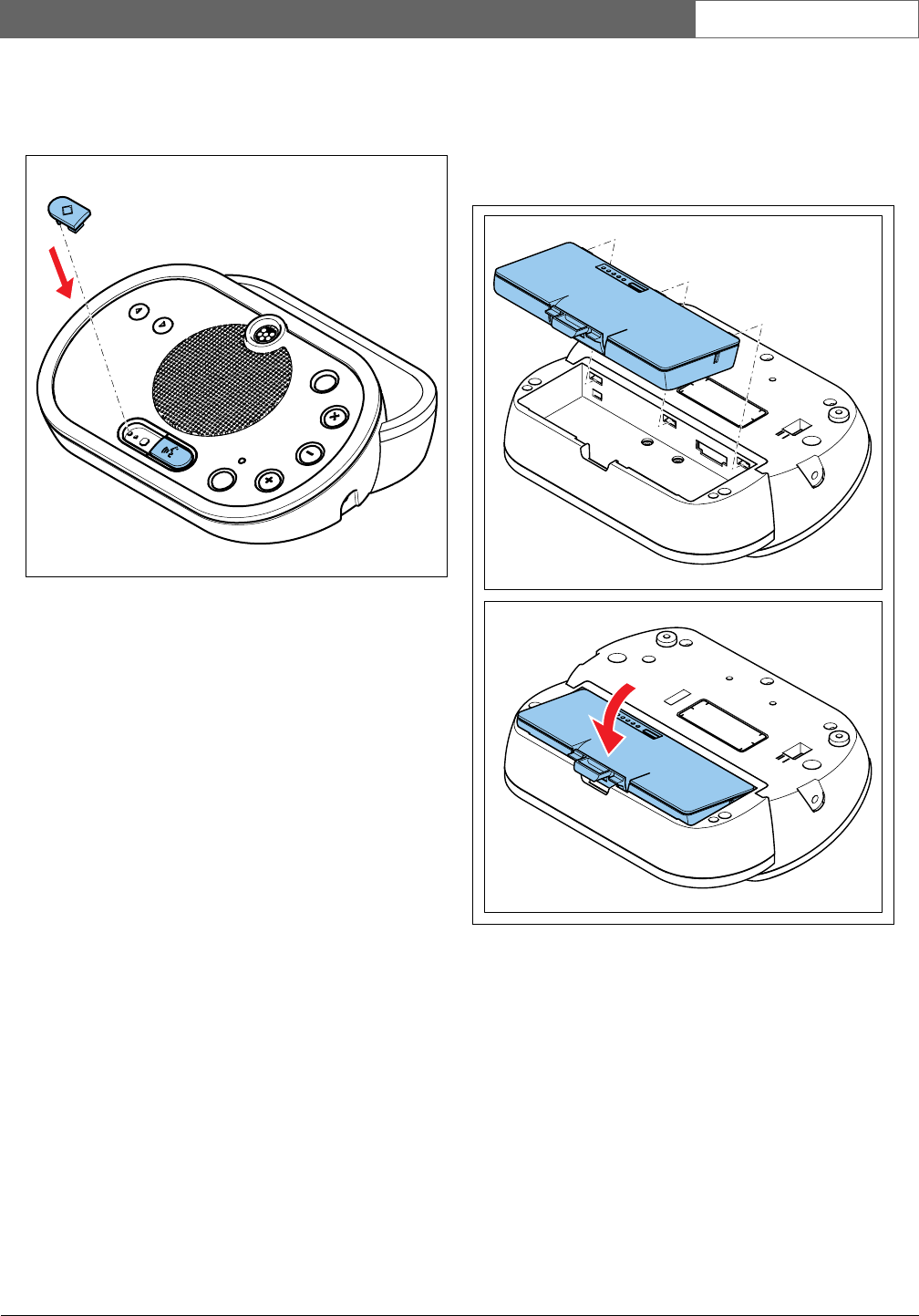
Bosch Security Systems | 2007-11 | 9922 141 70691 en
DCN Wireless | Installation and User Instructions | Contribution Devices en | 79
Refer to figure 14.11 for instructions that tell you how to
install microphone buttons in a wireless discussion unit.
14.5.3 Battery
Refer to figure 14.12 for instructions that tell you how to
install a DCN-WLION Battery Pack in the wireless
discussion unit.
figure 14.11: Install microphone buttons
figure 14.12: Install a battery pack
02
01
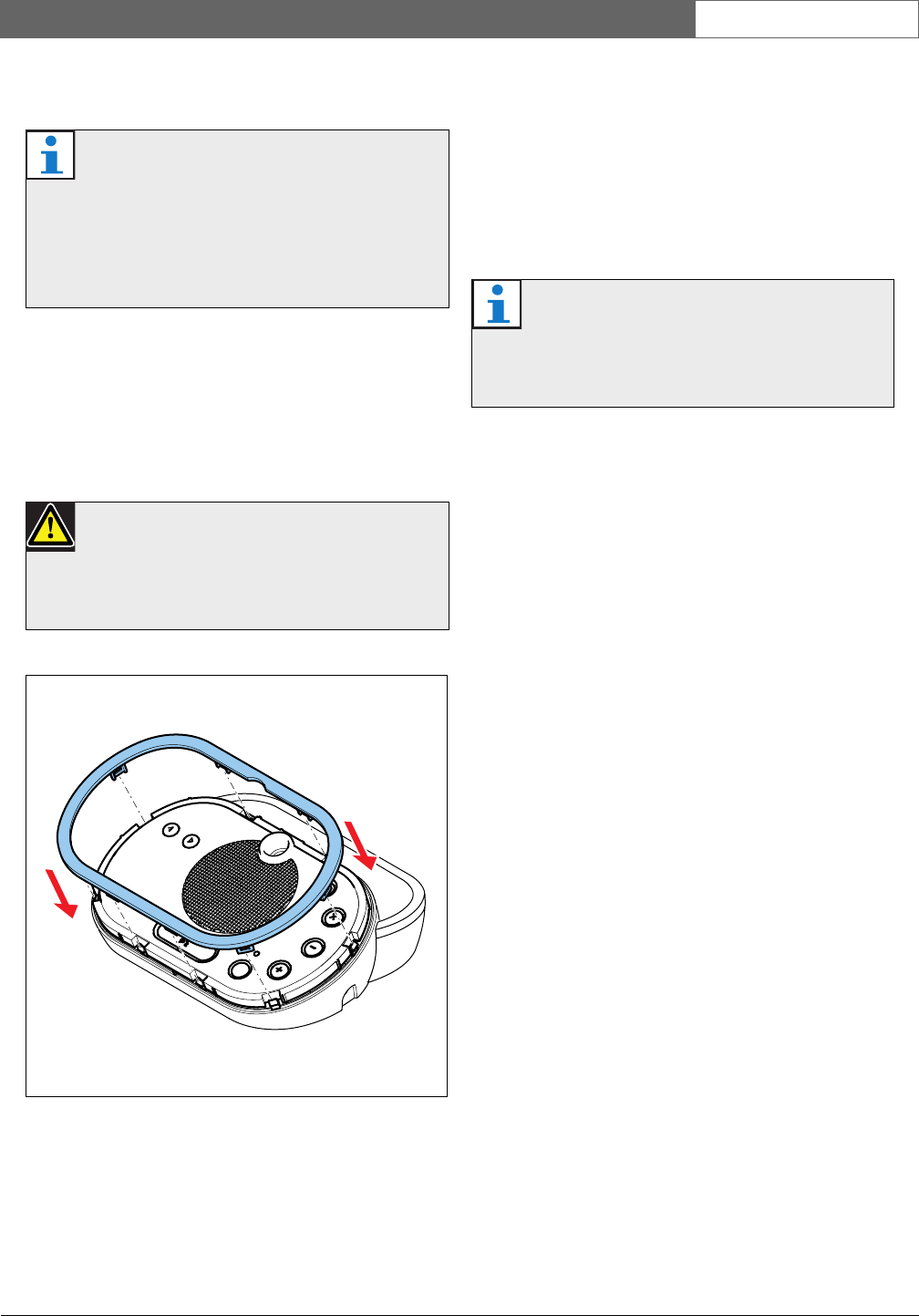
Bosch Security Systems | 2007-11 | 9922 141 70691 en
DCN Wireless | Installation and User Instructions | Contribution Devices en | 80
14.5.4 Rims
The wireless discussion units are delivered without rims.
With the rims, you can change the look of the wireless
discussion unit.
Refer to figure 14.13 for instructions that tell you how to
attach a rim to a wireless discussion unit.
14.6 Subscription
14.6.1 Introduction
Each wireless discussion unit in the system must have a
subscription. The central control unit cannot send data
to a wireless discussion unit that does not have a
subscription.
Note
Before you install the rim, make sure that the
wireless discussion units operates correctly.
Defective wireless discussion units are always
replaced with a wireless discussion unit without
a rim.
Caution
Do not remove the rim from a wireless
discussion unit. Only qualified personnel can
remove rims from wireless discussion units.
figure 14.13: Attach a rim
Note
Refer to section 12.2 when the central control
unit must give subscriptions to all wireless
network devices.

Bosch Security Systems | 2007-11 | 9922 141 70691 en
DCN Wireless | Installation and User Instructions | Contribution Devices en | 81
14.6.2 Procedure
The procedure below is applicable for wireless
discussion devices without a subscription. If the wireless
discussion unit already has a subscription, first erase the
subscription (refer to section 14.6.3).
Do as follows:
1 Set the wireless mode of the system to Subscription
(refer to section 12.3.5).
2 Insert charged batteries into the wireless discussion
units.
3 Push the microphone button of the wireless
discussion unit. All LEDs of the wireless discussion
unit come on and stay on, and the indicator ring of
the microphone comes on as red.
4 Push the microphone button of the wireless
discussion unit for a second time. The unit will try to
subscribe. If subscription is successful, all LEDs of
the wireless discussion unit, and the indicator ring of
the microphone go off (if the software version of the
wireless discussion unit is lower than 2.35, all LEDs
go off after 2 seconds, and the LED around the
microphone is green for 5 seconds indicating that the
subscription was successful. A second push on the
microphone button, as required for units with
software version 2.35 or higher, is not required).
• If after pushing the microphone button for a second
time, all LEDs around the microphone button and
the indicator ring of the microphone come on again,
the wireless discussion unit is either not within range
of the wireless network, or the wireless mode is not
set to Subscription (if the software version of the
wireless discussion unit is lower than 2.35, and after
pushing the microphone button for the first time, the
ring around the microphone button alternates red
and green for 5 seconds, the unit is either: not within
range of the wireless network, the wireless mode is
not set to Subscription, or the language distribution is
enabled). Refer to the note under Limit 4 in section
1.
• If after pushing the microphone button for the first
time, the ring around the microphone button is
yellow for 250 milliseconds and then goes off, the
wireless discussion unit was already subscribed to
this system - you did not have to put the system in
subscription mode. Instead switch on the unit as
described in section 13.1 (if the software version of
the wireless discussion unit is lower than 2.35, the
ring around the microphone button is green for 2
seconds).
• If after pushing the microphone button for the first
time, the yellow LEDs around the microphone
button, and the red indicator ring of the microphone
are on, the wireless discussion unit is already
subscribed to a system, but is not within range of this
system. If the unit cannot find the system within 15
minutes, it will automatically switch off (if the
software version of the wireless discussion unit is
lower than 2.35, the ring around the microphone
button alternates red and yellow for 5 seconds, and
then the unit automatically switches off).
• If after pushing the microphone button for the first
time, the yellow LED comes on for 250 ms and the
red microphone indicator comes on and stays on, the
wireless discussion unit is already subscribed to the
system, but another unit with the same address is
already connected. To correct this, de-initialize the
unit as described in section 14.6.3, or push the
microphone button for a second time. The unit will
then de-initialize. If the unit is in range of the
wireless network and subscription is enabled, the
unit will also subscribe (if the software version of the
wireless discussion unit is lower than 2.35, the ring
around the microphone button alternates red and
yellow for 5 seconds, and then the unit automatically
switches off. De-initialize the unit as described in
section 14.6.3, and then subscribe the unit again).
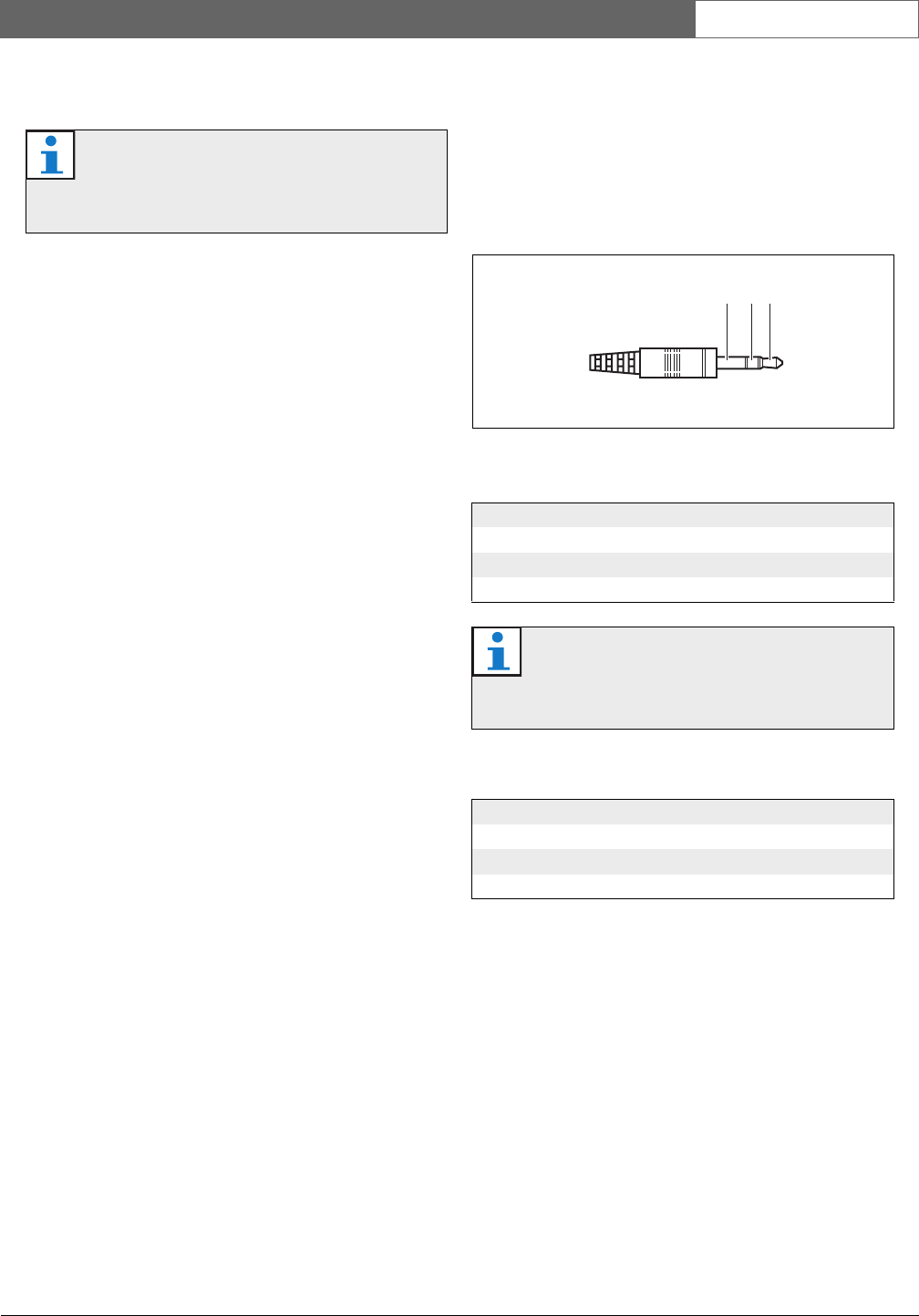
Bosch Security Systems | 2007-11 | 9922 141 70691 en
DCN Wireless | Installation and User Instructions | Contribution Devices en | 82
14.6.3 Erase the subscription
Do as follows:
Push-and-hold the de-init button of the wireless
discussion unit (refer to figure 14.4), and push the
microphone button of the wireless discussion unit to
switch it on (if the unit is already switched on, just push
the de-init button).
All LEDs of the wireless discussion unit come on, and
the LED around the microphone indicator ring comes
on as red. The old subscription is erased, and the unit is
ready for subscription (refer to section 14.6.2). If the
software version of the wireless discussion unit is lower
than 2.35, the LED around the microphone button
comes on as yellow for 2 seconds.
14.7 External connections
14.7.1 Headphones
You can connect headphones to the headphones socket
of the wireless discussion unit, the headphones must
have a 3.5 mm plug (refer to figure 14.14).
Note
Do not push the de-init button with a sharp
object.
figure 14.14: 3.5 mm headphones plug, connection
table 14.5: 3.5 mm headphones plug, connection
Number Signal
1Left
2Common
3Right
Note
You can connect mono headphones to the
wireless discussion unit.
table 14.6: Headphones sockets, details
Number of connections:
2x 3.5 mm socket
Location:
Right and left sides
2 3 1
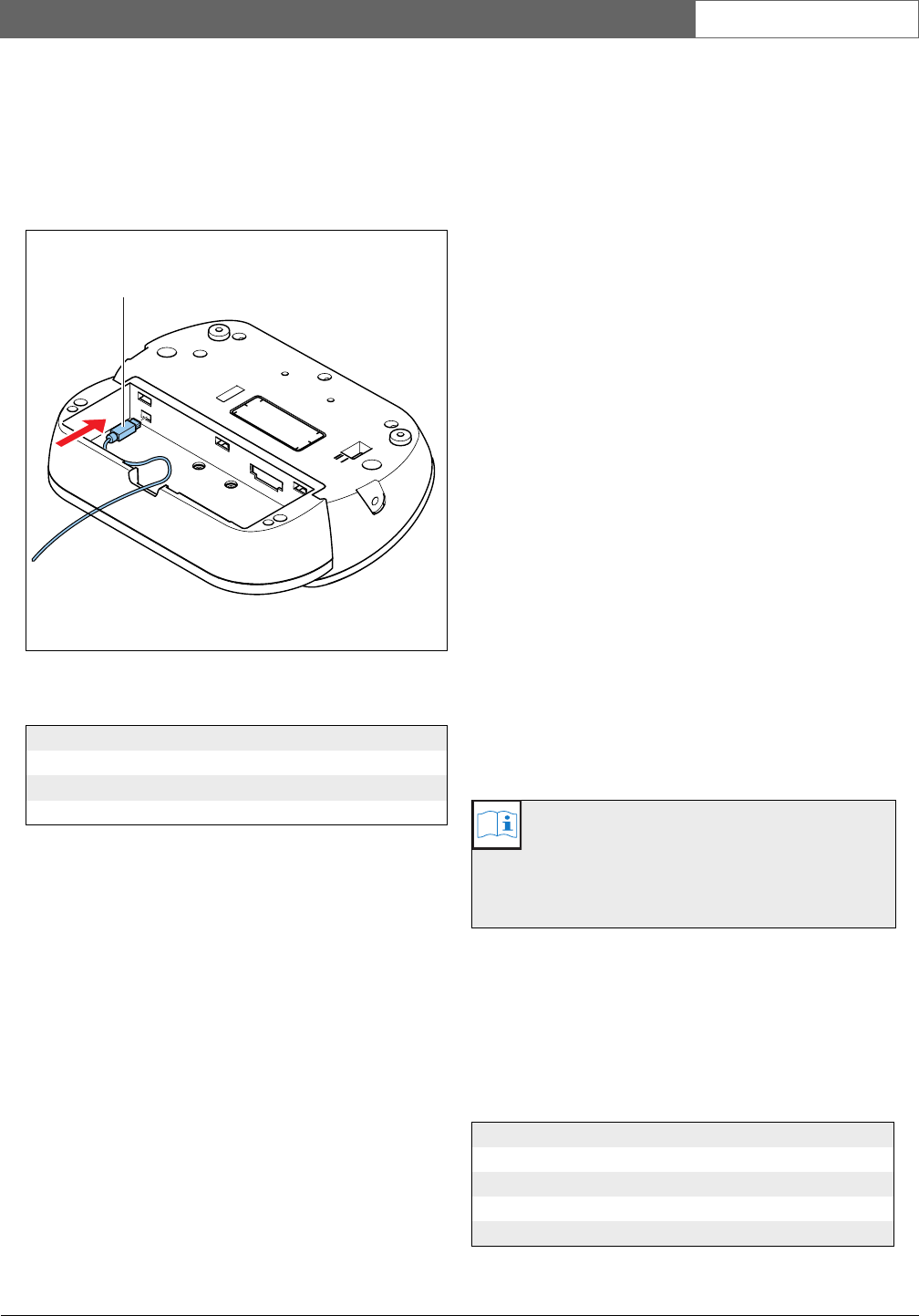
Bosch Security Systems | 2007-11 | 9922 141 70691 en
DCN Wireless | Installation and User Instructions | Contribution Devices en | 83
14.7.2 External power supply
When you remove the battery pack from the wireless
discussion unit, you can connect the wireless discussion
unit to a DCN-WPS Power Supply Adapter (refer to
figure 14.15).
14.8 Operation
14.8.1 Activation
Before activating the units, make sure:
• The wireless discussion units are already subscribed
to the system (refer to section 14.6.2).
• The system is switched on.
• The wireless discussion units are in range of the
system.
Push the microphone button to activate the wireless
discussion unit. The LED around the microphone
button comes on as yellow for 250 milliseconds. The
unit is now connected and can be used.
If the wireless discussion unit does not behave as
described above, refer to section 14.6.2 (if the software
version of the wireless discussion unit is lower than 2.35,
the LED around the microphone button does not come
on as yellow for 250 milliseconds; the indicator ring of
the microphone comes on as green for 2 seconds).
14.8.2 Deactivation
Push and hold down the volume-down and volume-up
buttons for 2 seconds.
14.8.3 Quick reference card
14.8.4 Microphone
The colors of the LEDs of the microphone buttons show
the condition of the microphone that is connected to the
wireless discussion unit (refer to table 15.5).
figure 14.15: Power supply socket, connection
table 14.7: Power supply socket, details
Number of connections:
1
Location:
In battery pack container
1
Note
Refer to the Quick Reference Card of the
wireless discussion unit for instructions that tell
you how to operate the wireless discussion unit.
table 14.8: Condition
Color Condition
Red (on) Microphone active
Red (flash) Last minute of speech time
Green (on) Request-to-speak
Green (flash) First request
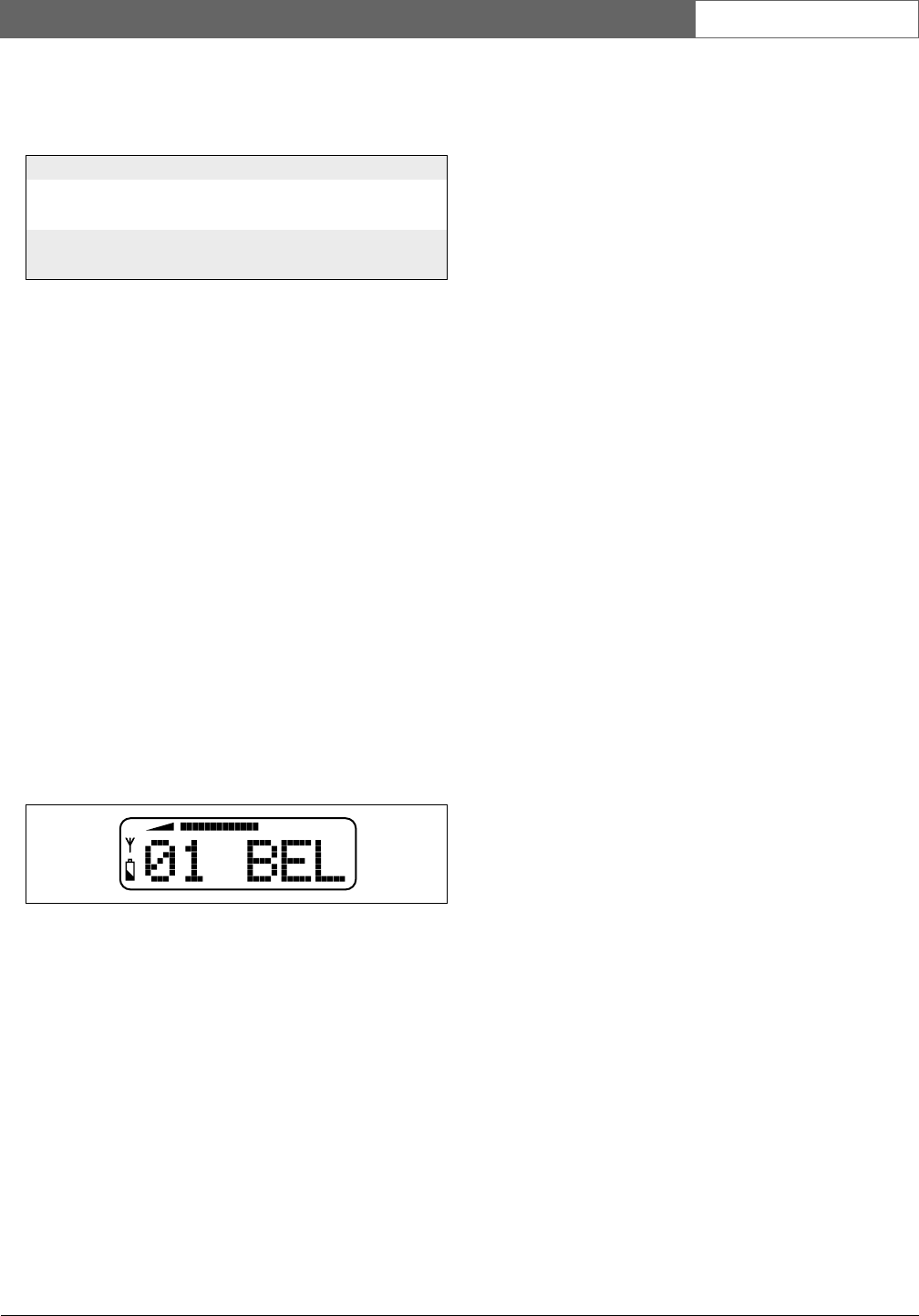
Bosch Security Systems | 2007-11 | 9922 141 70691 en
DCN Wireless | Installation and User Instructions | Contribution Devices en | 84
14.8.5 Attendance LED
14.8.6 Status LE Ds
The status LEDs (refer to figure 14.6, no. 13) show the
condition of the wireless discussion unit.
• If the yellow LED is on, the wireless discussion unit
is out-of-range.
• If the red LED flashes, the battery pack of the
wireless discussion unit will be empty within 1 hour.
If a wireless discussion unit is out of range for more than
15 minutes, it will automatically switch off.
14.8.7 Status channel selector display
If the wireless discussion unit has a channel selector
display, additional icons show the condition of the unit
(refer to figure 14.16):
• If the antenna icon is shown, the wireless discussion
unit is out-of-range.
• If the battery icon is shown, the battery pack of the
wireless discussion unit will be empty within 1 hour.
If a wireless discussion unit is out of range for more than
15 minutes, it will automatically switch off.
table 14.9: Attendance LED
Attendance LED Condition
Yellow (flashing) The system requests
attendance registration.
Yel l ow ( on ) The attendance registration
is confirmed.
figure 14.16: Antenna and battery icon